NEWS
03/04 May 2025. New suburb in Urk commemorates 1942 crashed Lancaster with monument.
On the location where on 17 December 1942 Lancaster ED333 plunged into the ground, killing all 7 crew, a new suburb was build. On the Dutch WW2-liberation day, the local community showed they had not forgotten the crew's sacrifice. On the roundabout entering the new quarter, an outstanding (10 x 8 meters) steel monument was erected. Build by local industry, the monument represents a scroll bound together by 7 strings with each the name of a crew member engraved, completed with the RAF 97 Sqn emblem on the front. Visiting address is village Urk (NL), Ensgat street. 
.
.
30 Oct 2024. Wrecksite of B-24 42-63969 crew Hunt (22 Dec 1943) found in Lake IJsselmeer.
Newspapers reported today that the ARG 40-45 foundation led by Johan Graas, identified a wreck site in the northern part of Lake IJsselmeer (Old Zuyder Sea) at Wieringermeer as the lost USAAF B-24 Liberator bomber 42-63969, crew 1Lt. Grady Hunt. A shoe with 'US Army', remains of unused parachutes and the aircraft's serial number were retrieved. This aircraft has five MIA crew members. Read more: https://www.zzairwar.nl/dossiers/149.html or Google 'ZZairwar B-24 Grady Hunt'. The US DPAA was notified. It is unknown yet if the wreck site is known as a previous recovery location in the years 1943- 1970 (map below) but remained unidentified then. The 42-63969 received a commemorative pole on the Wieringermeer dike in October 2023.
.
19 Sept 2024. Pole 1 Dronten. Unknown Lancaster wreck will be investigated.
In 2011 the first commemoration pole (image above) for a in WW2 crashed aircraft was placed in polder Flevoland (NL). This was in the city of Dronten, which was water (Lake IJsselmeer) during the war. The crew and aircraft remembered were of RAF Lancaster W4367. However, the periodical update with renewed research in 2020 suggested that the involved aircraft was more likely another RAF bomber. Therefore in 2021 the text on Pole no. 1 was changed to 'unidentified British bomber'. In the 2020-research, old documents were discovered that described how a in 1959 after the water was drained here, an airman was found in a gun turret in a muddy area where Dronten had to be build. This man was never identified and he was buried as 'Known to God' in Nijmegen. A recent metal detecor search on the same location, revealed that there are large aircraft parts in the ground. In 2025 the Dutch Air Force will conduct an investigation on this spot and will try to identify the bomber. With this, the hope is that the unknown gunner buried in Nijmegen can be identified as well and in a ceremony his headstone can be replaced for one with his name. It is possible that more crew members (now listed as MIA) will be found in this wrecksite. The operation is funded by the Dutch Program WW2 Aircraft Recoveries and will be led by the new Recovery Officer Coen Cornelissen.
10 July 2024. Documentary by Guy Martin on recovery operation Lancaster ED603
A few trailers on You Tube:
Guy Martin WW2 Bomber, trailer 20 sec (July 2nd)
Guy Martin WW2 Bomber The Storm (July 12)
Guy Martin WW2 Bomber Humbled (July 19)
Nice to known: The Storm. A year before the recovery, we warned the Recovery Official during a SGLO-meeting, that a cofferdam would be very vulnerable in this part of the Lake, because the waves can be very high and powerful here. It is more a Sea than a Lake. It appears the scenario of a dam-collapse almost came true... The documentary shows a lone Rolls-Royce (US Packard build) Merlin engine, sitting in the sand. This is the engine the fishermen who discovered the Lancaster (we), broke-off from the wing, winched to the surface, removed the serial number plate and returned the engine to the bottom next to the wreck. The Merlin was in much, much better condition then. The details from the serial number plate identified the wreck. The drawing of the serial plate (handwritten copy) is shown fully below this news page. I gave the brass serial plate itself to a guest who was on board then. Therefore the engine in the documentary is without ID-plate, sorry Guy. 
Thank you, Mr. Cutler
12 May 2024. Old identity card found. In memory of Sgt. Jerzy A. Kwiecinksi
In the night of 26 on 27 March 1942, RAF/Polish Wellington Z1269 crashed East of Den Helder in the Wadden Sea. Five crew were recovered (dead) and were buried, but one man, Sgt. Jerzy Kwiecinski possibly parachuted out but drowned and went MIA in the Wadden Sea. A few years ago we did some unsuccesful research on his whereabouts, because he is expected to be buried as an unknown airman in the Wadden Sea area. Last week from a drawer, with documents originally kept in by his friends in wartime London, his French identity card turned up, from the time he arrived in France after he escaped Poland after the fall of Poland in 1939. Thank you Roman for sharing this document with us. 
23 November 2023. Human remains in Lancaster ED603 identified as the three missing crew members.
Dutch Ministery of Defence annouced today that the human remains recovered in September, are now positively identified as the missing crew, see names below. With them airman-clothing was found, but also personal items. The family is notified. This will imply that after 80 years their MIA-status has ended. Their names will be removed from the Runnymede Memorial. Burial is planned for 2024 in the Netherlands.
04 September 2023. Lake IJsselmeer, 5km south of Breezandhaven, Afsluitdijk, NL. Start of recovery Lancaster ED603.
A week ago, the cofferdam around the wreck was completed and pumped dry. Today in the bottom of the pit, the Dutch Military started digging out the fugelage. Let's hope the three missing crew are found. The operation will take at least four weeks. Photo below shows the location, just west of wind turbine park Friesland.
- update 07 September 2023: human remains found in wreck Lancaster ED603 : https://lc.nl/friesland/Tragisch-verhaal-komt-boven-28629292.html
The missing crew of the ED603 are: Pilot Officer Arthur Smart, Pilot Officer Raymond Moore and Pilot Officer Charles F. Sprack. All three were already decorated with the DFM before they were asked to join the new elite RAF 83 pathfinder squadron begin 1943.
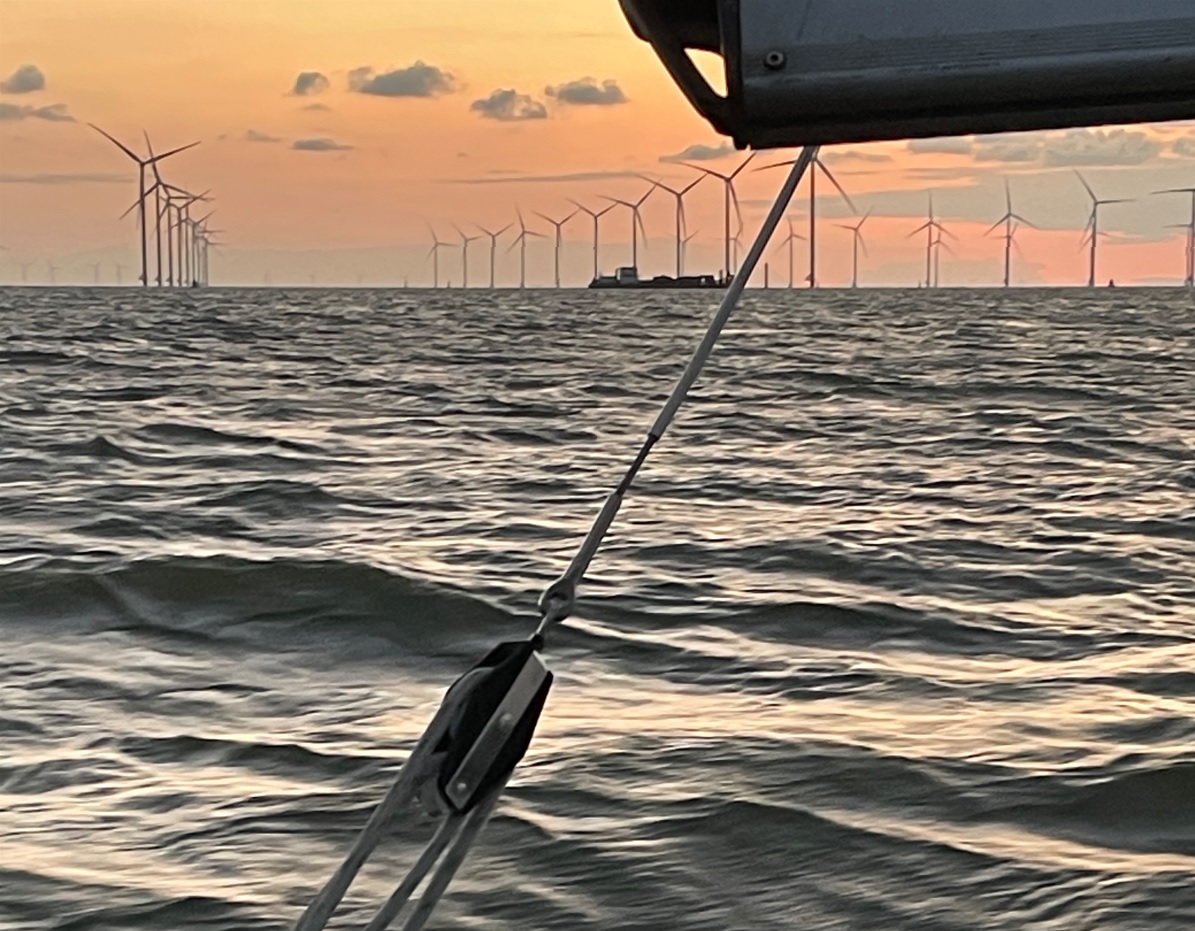
ZZairwar (Zuyder Zee Air War) file on Lancaster ED603: https://www.zzairwar.nl/dossiers/27.html
Kijk Magazine 05 September 2023: https://www.kijkmagazine.nl/nieuws/waarom-de-lancaster-bommenwerper-in-het-ijsselmeer-belandde
Photo and video of the cofferdam construction: https://nos.nl/artikel/2487814-bommenwerper-komt-na-80-jaar-onder-het-ijsselmeer-vandaan
6 February 2023. Teunis (PATS) Schuurman died.
On Monday February 6th 2023, the memorial service for Teun was held in Meppel, not far from his hometown Vollenhove. He was only 72 years old. Last contact with him was mid January 2023. Police found him in his house on the 29th of January. He probably died of a stroke in the week before. Since he stopped working as a civil engineer at Delft Hydraulics, he focused the last 16 years on web-design and studied the WW2-airwar in a 50 x 50 mile radius around his town (see square on map below). This resulted in a massive website with unique self-researched data: http://www.teunispats.nl/sglo.htm Over the years he contacted 759 British, American, Canadian and Australian airmen-families and ploughed through many old governmental file that enabled him to finally clarify, reconstruct and publish in great detail what had happened in hundreds of airplane crashes in his area. PATS, rest in Peace. 
20 December 2022. Commemorative plaque for crew R5512, Amsterdam.
Tuesday 20 december 2022, the City of Amsterdam and the Crash Lancaster R5512 Memorial Foundation reveiled a plaque for R5512 in underground-train station Amsterdam Noorderpark (Noord-Zuid Line). Exact on this spot this Lancaster (the OF-C, crew Eales, 97 Sqn RAF) crashed deep in the ground on 20 December 1942 after being shot down by German Flak. Three crew were buried in 1942, but during construction in 1962 the main body of the aircraft was discovered and the missing four airmen were found. This recovery in 1962 was the first time the later Dutch Airforce Recovery-officer Gerrit Zwanenburg came in contact with aircraft recovery, because he attented the 1962-recovery as a visitor. The R5512 Foundation is also in the advanced proces of building a full scale Lancaster front section/cockpit including original instruments, see further below. Photo below left: Mr. Malcolm Mason, vice-president of the RAFA, made the opening speech. 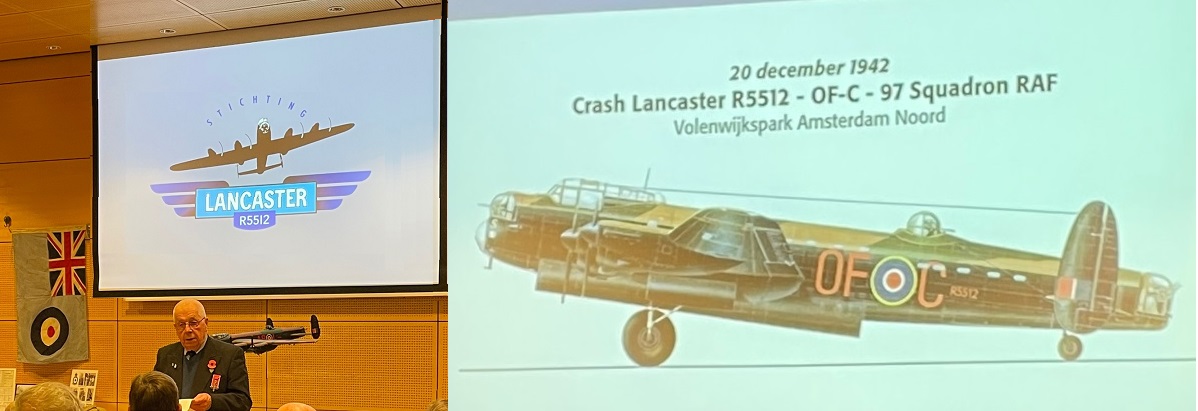
Research on Lancaster R5512 (OF-C) and the relation with Lancaster ED333 (OF-B):
In the weeks before 17 December 1942 at 97 Sqn (squadron code 'OF'), most crews consisted of a mixed British/Canadian crew. Lancaster OF-B (ED333) piloted by Canadian F/O Samuel McBurney, was already on operational flights bombing Germany, while the OF-C flown by P/O William Eales was still in training at 97 Sqn on Lancasters, making cross-country trainings over the UK and the North Sea. Then in the night of 17/18 Dec 1942, the OF-B did not return from a mission. Unknown to everybody the OF-B McBurney crew was shot down by a German nightfighter and crashed (7 KIA) on the East side of Lake IJsselmeer, in the wet North East Polder, 3 km east of Urk (K. Doormanweg). After just five training missions, the OF-C Eales crew had to step up and fill the gap the OF-B had left.
In 97's Sqn next mission, the evening of 20 December 1942, Pilot Officer Bill Eales took-off in the OF-C for his first combat mission, night-bombing the German war industry in Duisburg. Something happened over Duisburg, because on the return he came 30 minutes delayed from Duisburg and was flying low on only 500 meters altitude. He was stuggling and limping back to England. Probably an engine was shot out over the target. The OF-C came over central Holland, passed over Hilversum, but had no luck because it flew right into the well defended Amsterdam-harbour entrance.
Map below. Under construction. At 21:05 light Flak towers (LF) between Schellingwoude and Durgerdam fired on the R5512, who fired back with it's machine guns at the search lights. Light Flak towers (LF) in park 'Vliegenbos' finished the R5512 off. The shooting over the Meeuwenlaan and Zamenhof street had been intense. The bomber crashed in the Volewijkers-park where today metro station Noorderpark is. Only Sgt. Roy Bambury got out, but he fell dead with half deployed parachute on a tile rooftop of an appartment at Adelaarsweg 116. His left leg lay in the street.
Burial 28 December 1942, Amsterdam.
By a twist of fate, despite crashed three days in between and 58 km apart, the men of the OF-B (ED333) and OF-C, who knew each other well, were buried together in Amsterdam-Watergraafmeer, New Eastern Cemetery on 28 December 1942. In the village of Urk on the other side of the Lake, the Germans had forbidden the further burial of Allied airmen there, because the people of Urk showed too much respect during funerals of washed ashore Allied airmen. From then on, the Urkers had to bury recovered airmen in Amsterdam, which was the mother-community for Urk. From the 14th century onwards, Urk was the light house for Amsterdam on route to Amsterdam over the old Zuyder Sea. Four men of OF-B had received a coffin in Urk. These were sailed over by them to the Amsterdam-Schellingwoude (German) seaplane base. There had also arrived the coffins with the three recovered crew of the OF-C from Amsterdam-Noord. The seven coffins were transported to Amsterdam-Watergraafsmeer New Eastern Cemetery and buried mixed. Nobody was aware of their connection:
Grave 38. Unknown from Urk (Sgt. W. Kelleher, OF-B)
Grave 37. Thorneycroft (W/O L. Thorneycroft, RCAF, OF-B)
Grave 36. English airman Harper (F/O Milton Harper, RCAF, OF-C)
Grave 35. English airman Henderson (Sgt. George Henderson, OF-C).
Grave 34. Unknown from Urk (Sgt. J. Izatt, OF-B)
Grave 33. Unknown from Urk (Sgt. G. Bull, OF-B)
Grave 32. Unknown from Urk "Bambury" (OF-C, Sgt. Roy Bambury, OF-C). His recovery-location 'from Urk' was recorded on his burial card by mistake. He came from the Adelaarsweg-rooftop.
Photo under. The crew of R5512/OF-C was commemorated by Mr. Jos de Groot, chairman of the R5512 foundation. He also commemorated the fact that of the 125.000 airmen that served in RAF Bomber Command, 73.000 became casualties, of which 55.573 of them were killed performing their duty. 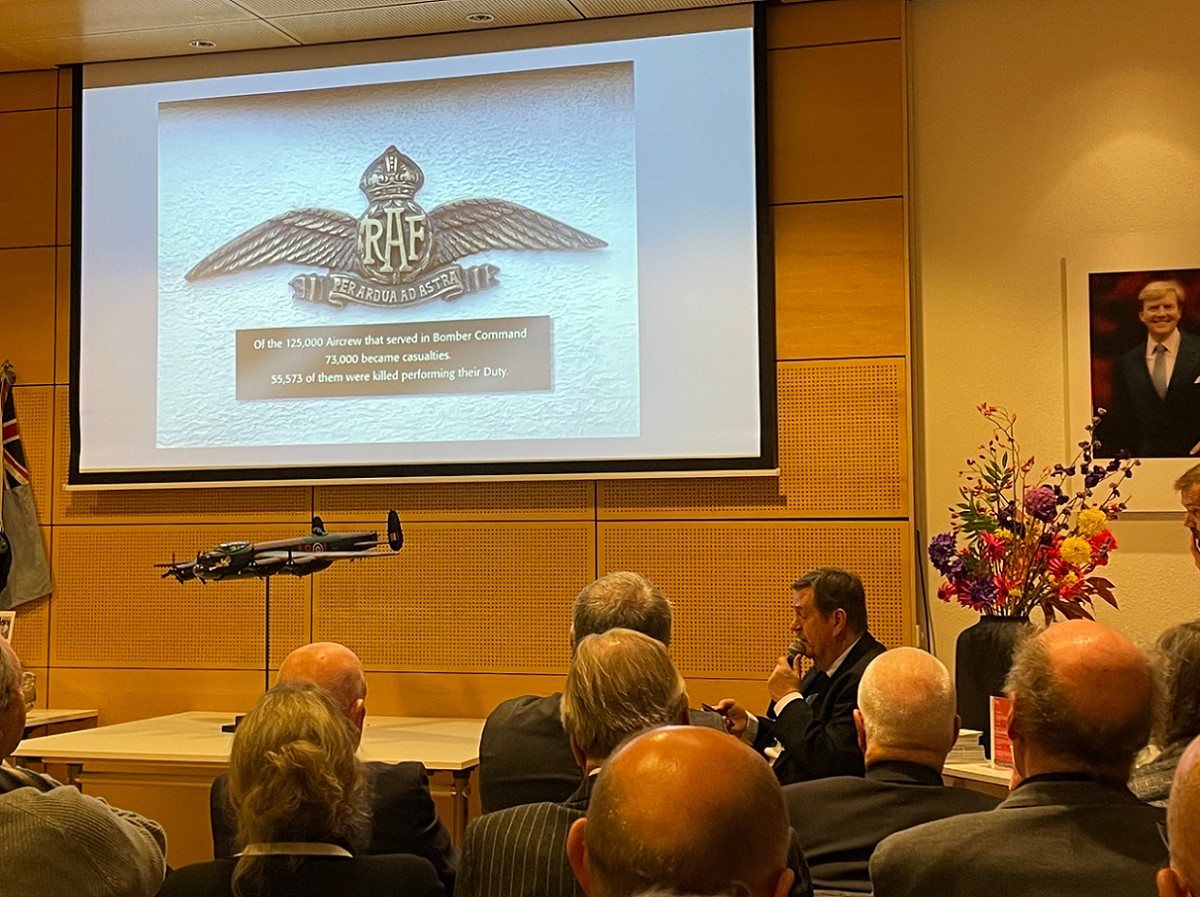
Reveiling of the commemorative plaque on the crash location by British and Canadian family of Lancaster R5512/OF-C. Today underground station Amsterdam-Noorderpark. The plaque design is based on a drawing made by Belgian artist Marc Vanoppen, better known as Marvano. The drawing appears in a book named 'Berlin: the seven Dwarves'. 
The Last Post.
During the trumpet signal, flowers were laid for the crew in Amsterdam, but also in Groesbeek where the four others (P/O Bill Eades, Sgt. James Donald, Sgt. Sidney Deed and Sgt. Arthur Mortimer, RCAF) were interred in 1962 after the second recovery of Lancaster 5512. 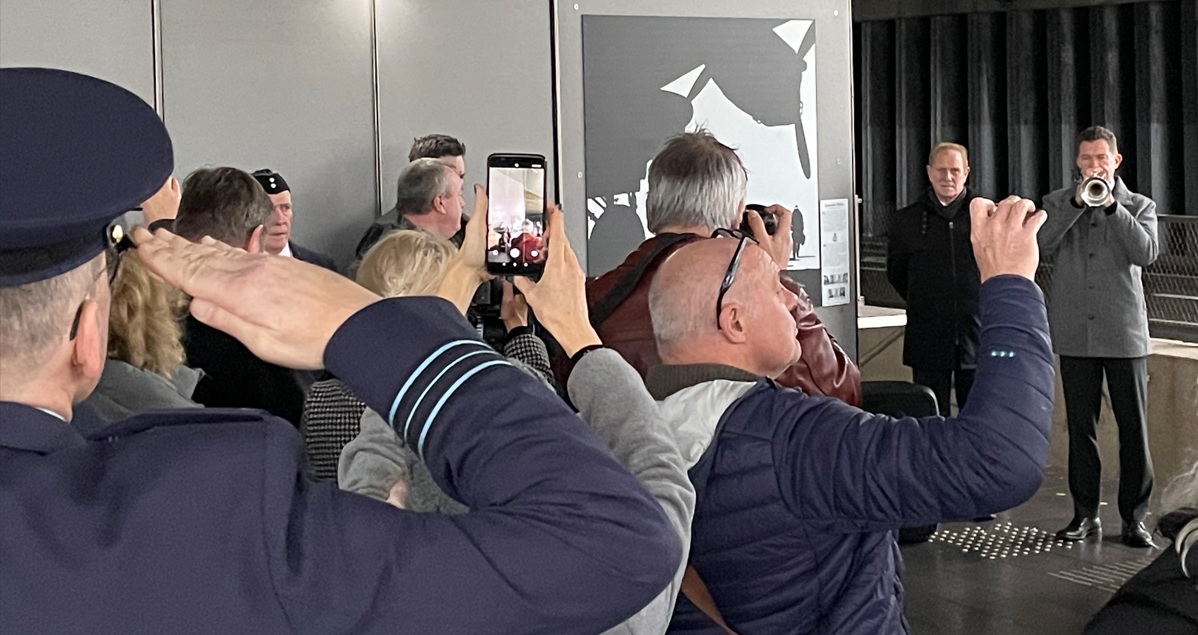
Below the cockpit section of a Lancaster, build by the R5512 Foundation. Real size with full original equipment on board. Family and supporting researchers received a small desk-version of the plaque.
Video of the reveiling of the plaque, 20 December 2022: https://www.youtube.com/watch?v=UHTKa_Aelo4 and AT5 news (start with the rooftop): https://youtube.com/watch?v=HBJyZ2j2_a8 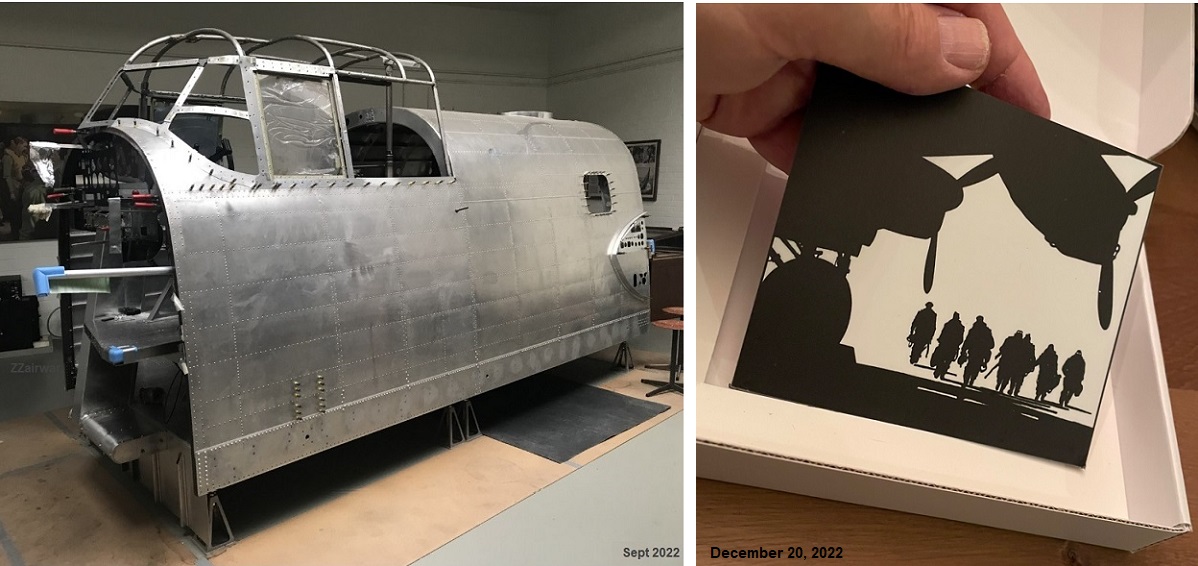
-----------------------------------------------------------------
6 December 2022. Middenmeer.
Update for cemetery Middenmeer, 2Lt. Joseph P. Congelli from New York: https://www.zzairwar.nl/dossiers/913.html
28 September 2022. Nijmegen.
Today in Nijmegen (NL) in the CWGC Jonkerbos War Cemetery, the military funeral took place of the crew remains found during the recovery of Stirling BK716. Lost without trace 29/30 March 1943, recovered in September 2020 in Lake IJsselmeer (see further below). More than 100 service personnel and family from the UK and Canada were present.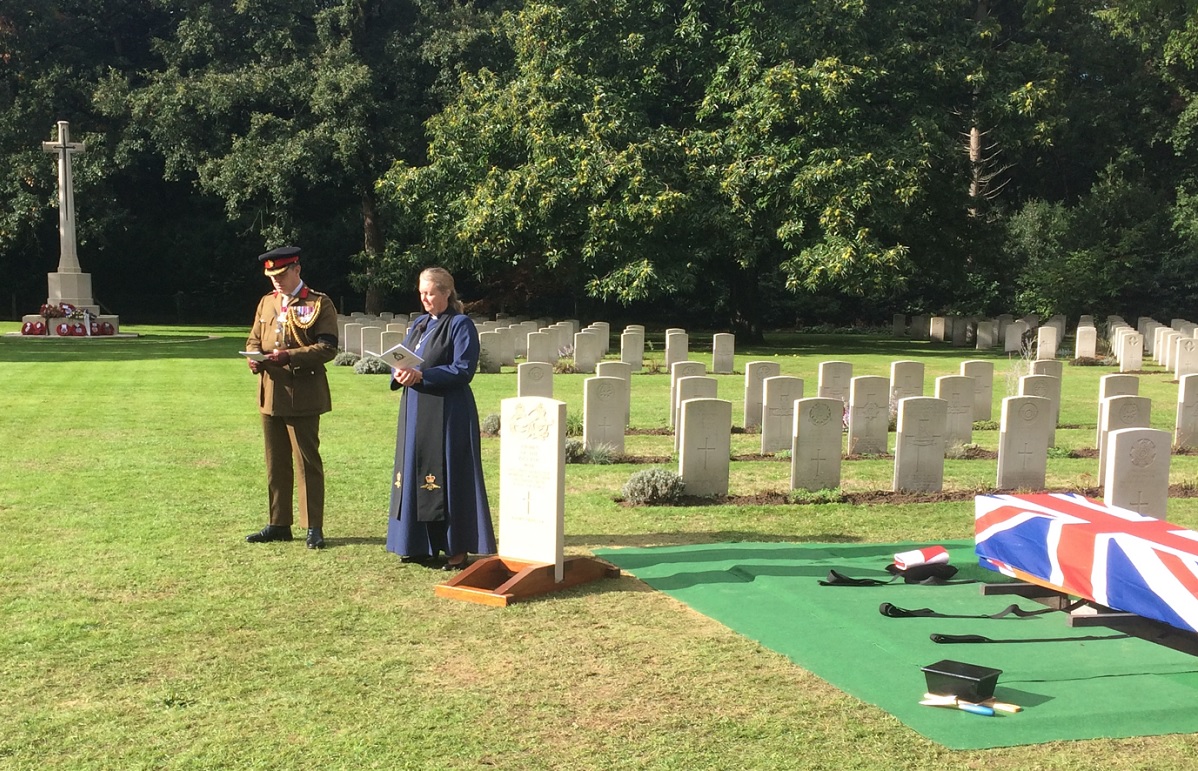
.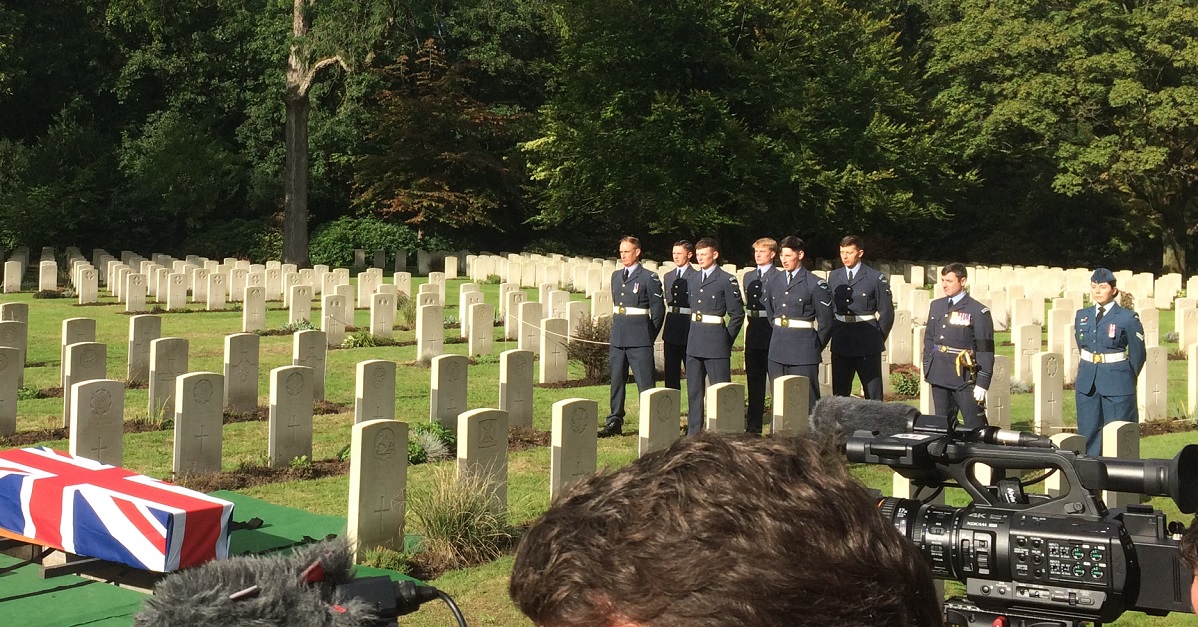
Recovery of Stirling BK716 in September 2020. 
01 September 2022. News on Lancaster ED603.
In August 2021 the Dutch Navy made a reconnaissance on the in 1996 received and then also checked position of the wreck of RAF 83 Sqn Lancaster ED603. Location is Breezand in Lake IJsselmeer, see map and further info below. In 2022 the military decided to postpone the recovery to 2023. Today the land owner of this part of the Lake, community Sudwest-Friesland, confirms in the press that the recovery is scheduled for 2023. Now that the Dutch state pays for the costs, Frisian communities do not longer obstruct the recovery. Over the years Makkum and Wonseradeel turned down several recovery requests. It is not certain the 'land-method' of building a cofferdam will be used, since the waves can be high and violent here. A marine recovery with salvage ships seems more appropriate. Debris of RAF Manchester L7390 were not found, which confirms the suspicion that the Germans recovered this Manchester in 1942.
In augustus 2021 verkende de Defensie Duik Groep (Marine) de in 1996 ontvangen positie en de (toen ook gecontroleerde) wrakpositie van RAF 83 Sqn Lancaster ED603. Locatie is de westkant van de Breezand in het noorden van het IJsselmeer, zie kaart en meer info onder. Vandaag maakte de gebiedseigenaar Sudwest-Friesland te Sneek bekend dat de berging na eerder uitstel in 2022 gepland staat voor 2023, gefinanciert door het Nationaal Bergingsprogramma. In de jaren daarvoor sloegen Makkum en daarna Wonseradeel de bergingsverzoeken steeds af, vandaar dat het vliegtuig met mogelijk drie bemanningsleden er nog steeds ligt. Het is niet zeker of de land-methode, de damwand en dan uitgraven/leegpompen ook hier wordt toegepast. Vanwege de waterdiepte en woeste golven lijkt hier eerder een bergingsschip-operatie als methode meest geschikt. Overblijfselen van Manchester L7390 werden niet gevonden wat een evt. berging van dit vliegtuig vooralsnog uitsluit.
26 June 2022. Dutch National Monument Missing Airmen.
At the dike at Molkwerum just north of Stavoren (Friesland, NL) a monument was revealed for the 220 WW2-airmen that are still missing in Lake IJsselmeer. Wreaths were layed by the RAF, the Canadian embassy, family, Dutch authorities and the organizing committee. 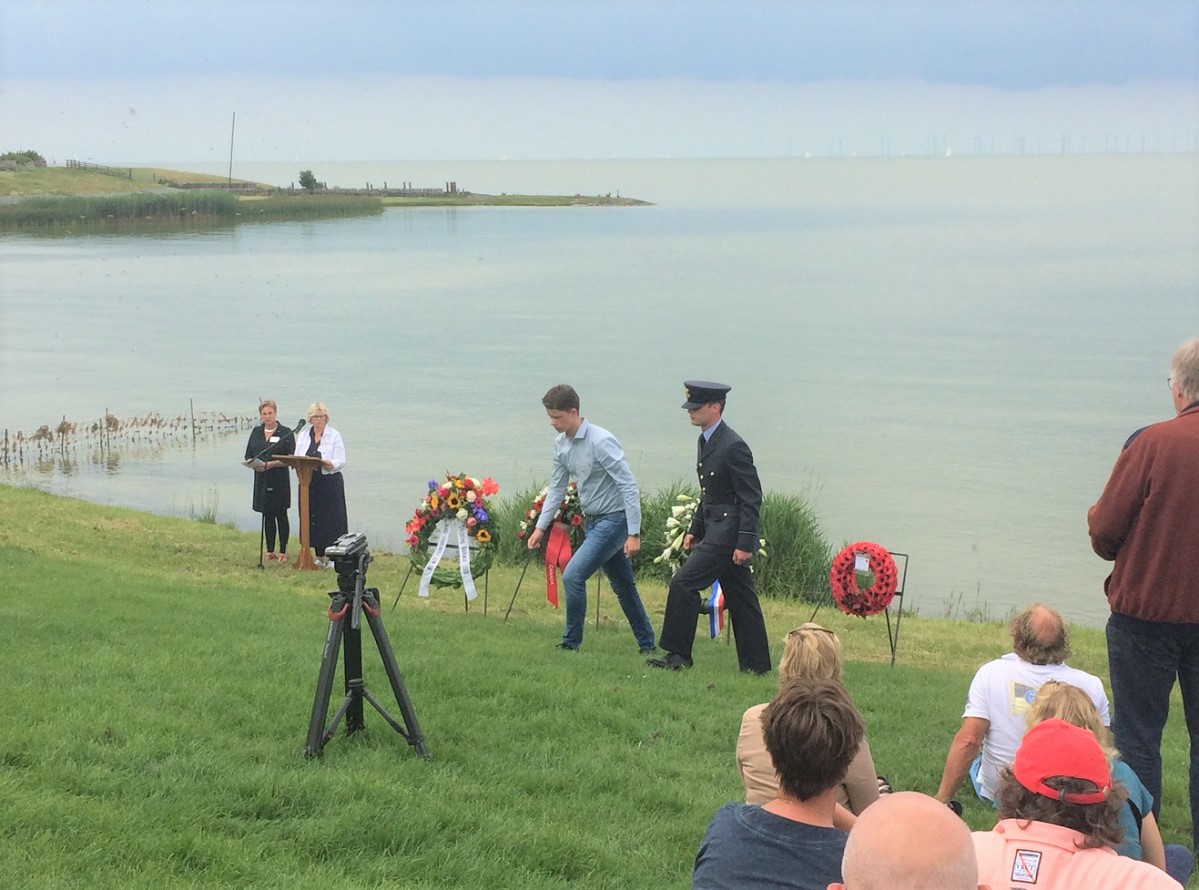
The monument represents the tail fin of a ditched WW2 bomber. It is made of concrete. It's solid base is resting and anchored on the bottom. 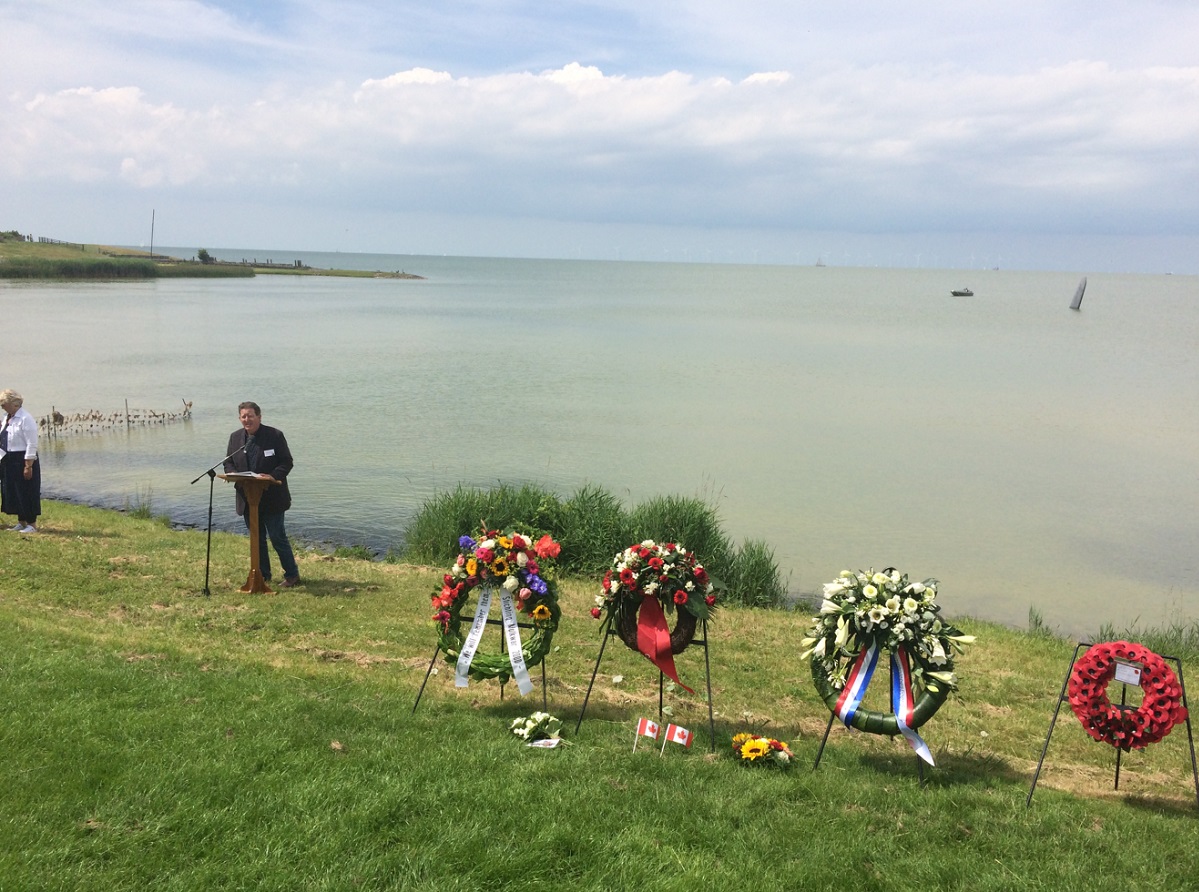
.
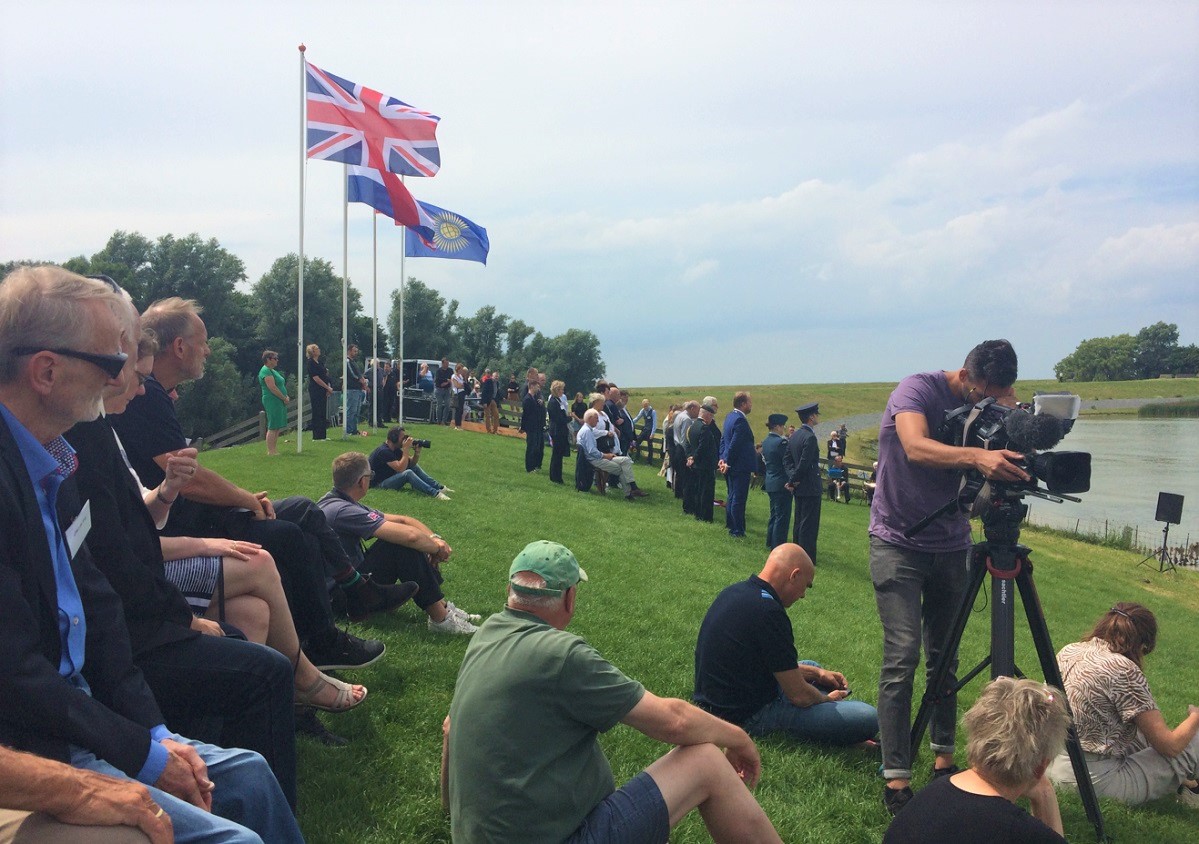
A plaque is positioned on the dike. Address: t Seleantsje, Molkwerum. Near restaurant Piacco. Postal code 8722. 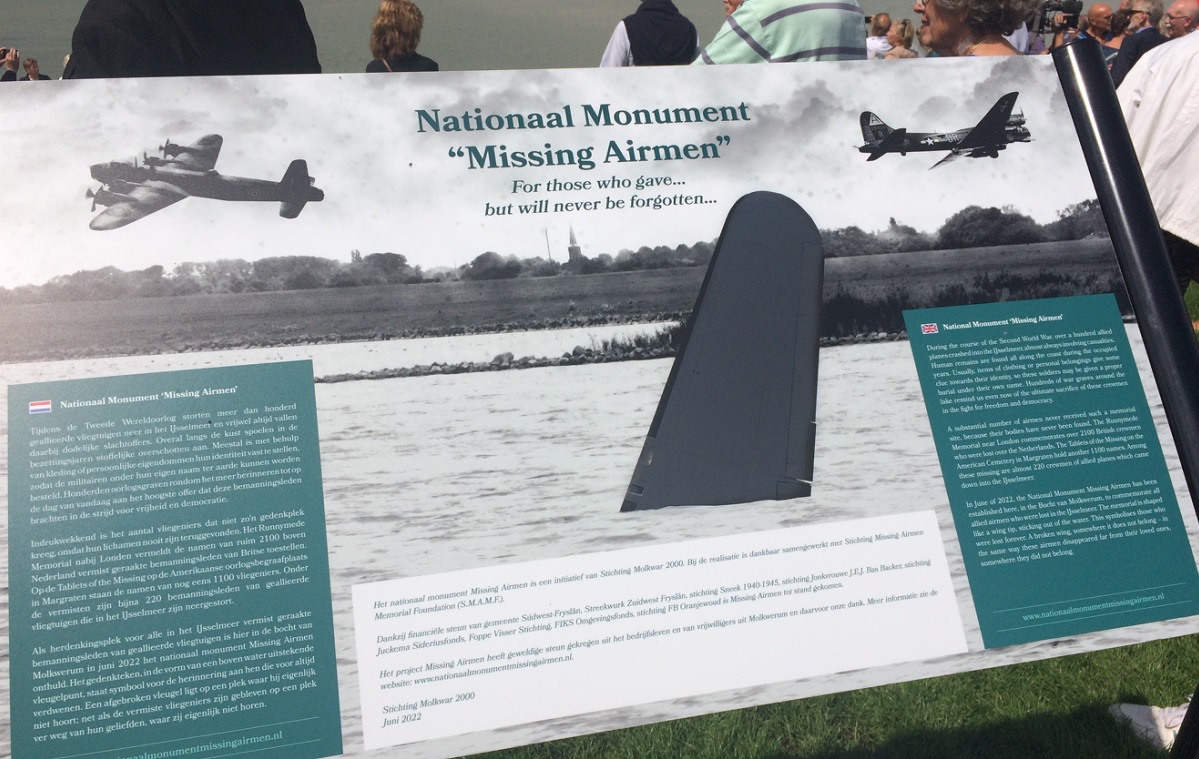
The text on the plaque reads: https://nationaalmonumentmissingairmen.nl
Two hundred people were witnessing the event. Below left is the McCrorie family revealing the plaque. Their relative RAF pilot F/Lt. Thomas F. McCrorie of Stirling EH889 washed ashore here in July 1943 and was buried here: https://www.zzairwar.nl/dossiers/956.html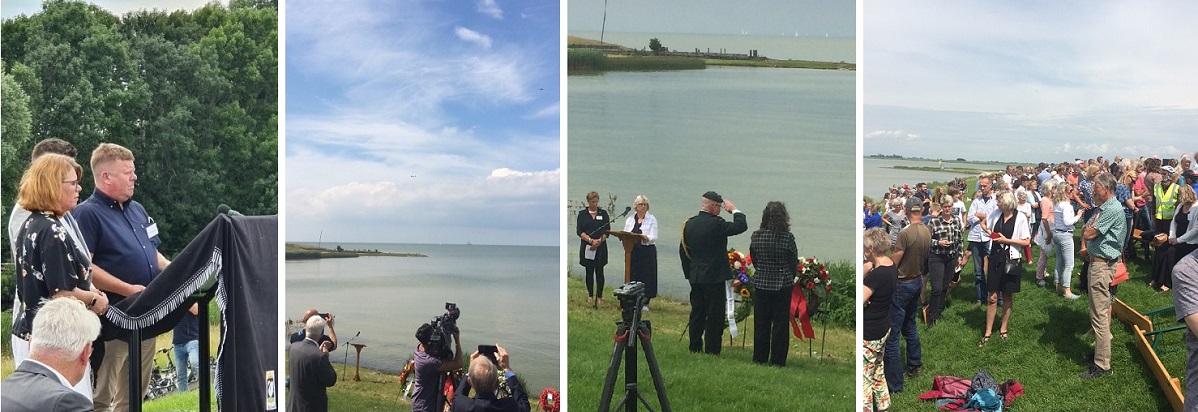
Fly pass by a P-51 and a T-6 Texan. Video Dutch TV: https://nos.nl/artikel/2434119-troost-voor-nabestaanden-220-vermiste-vliegeniers-met-nationaal-monument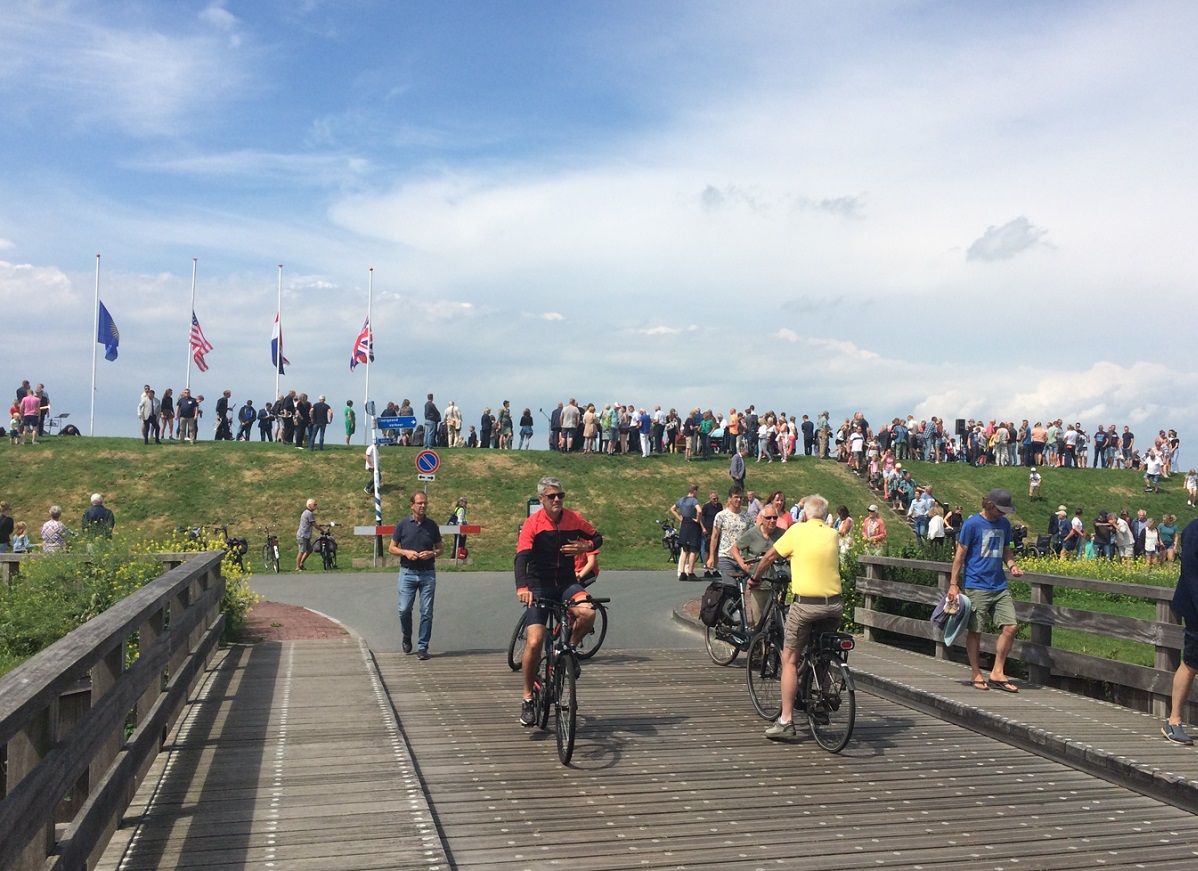
23 June 2022. Burial of crew Wellington T2990, crew Bufka. Bergen-op-Zoom CWGC military Cemetery
On the same date of the crash (23 June 1941) and a year after the recovery of Wellington bomber T2990, plus finalizing work by the Dutch Army Recovery and Identification Unit, the remains of the five Czech/RAF crew of T2990 were solomnly buried in one coffin at the CWGC military cemetery in Bergen-op-Zoom (NL). Each of the five will receive his own head stone. A new monument will also be erected at the former crash site in Nieuwe-Niedorp (see further below). 
.
Below: speech by Czech Minister of Defence Mrs. Jana Cernochova, followed by the Slovak Minister of Defence Mr. Jaroslav Nad.
The reserved seats for the family of pilot F/Sgt. Alois Rozum (pilot during the attack), gunner F/Sgt. Karel Valach, Pilot Officer Leonard Smrcek, P/O Vilem Konstacky and front gunner Sgt. Jan Hejna. 
The relatives at the grave. The five 'Czech-type' grave stones are positioned on the wooden standards next to the grave. 
British commander in dress uniform salutes.
The crash- and recovery location in the equestrian arena. 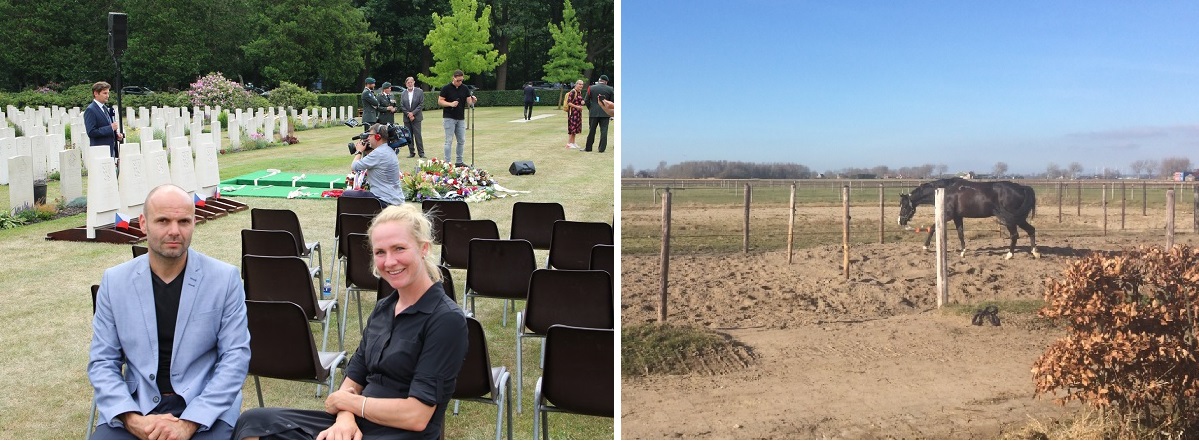
Wellington T2990 crashed June 1941 in a remote soft meadow and drove eight meters into the muddy ground. There was not a house or farm in sight. At first light the Germans came and arrested only survivor F/Sgt. Vilem Bufka, wounded. The pit was ten meters wide and already filled up with water to the neck. The Germans declared the British bomber not salvable. Local Mr. Jan Jonker was present and after the water in the pit turned into hard mud, he placed a wooden cross on it with engraved in Dutch: 'Crash site English bomber with crew, 23 June 1941'. The Germans received the information on the bomber and crew's identity via prisoner Vilem Bufka and relayed the info to the Red Cross who informed the British Ministry of Defence end 1941. Over the years, Mr. Jan Jonker maintained the cross with names and the material changed from wood to steel, later a marble slab with high wooden cross protected by a low fence to prevent cows from walking it over. It became an official CWGC-grave site, with CWGC-signpost along the road and an entry in the CWGC-register and website-database. Over the years, the fieldgrave was visited by the grandson of Karel Valach, many Czech people who worked in the Netherlands and a Czech WW2-veteran.
In 1970 a land-reorganisation project was started and by coincidence a farmhouse had to be build exactly on the crash site. However, the new farm buildings were carefully build around the crash site cross and the ground the monument stood on was sold for 1,- to the Community, including a right for overpass over the farm's central path for everybody who wanted to visit the cross (this infomation was later forgotten). In 2013 the farm was purchased by Mr. Boy and Mrs. Debbie Groot (photo above). They turned it into an equestrian centre, with stables, hotel for guest horses, riding school and riding arenas. The companies' business motto: 'Rest, space and well being'. They were quite shocked when in 2019 the Community came to them with the news the field grave was put on the Recovery list as part of the Dutch 15 million 'Program for WW2 aircraft wreck recoveries with chance of finding human remains'. It was clear on this wreck that the search part was minimal and chance on succes high. However, the prospect of large excavation machines on their premises, including building a cofferdam, could mean the end of the Groot-family business, as the paying owners could pull-out their valuable and sensitive animals. In the end, a great number of precautions were taken and in June 2021 the recovery went successful and without incident. Boy told the locals and himselve will erect a new monument along the road to commemorate the crew in Nieuwe-Niedorp. Mr. Jan Jonker who cared for the fieldgrave for so many years, died a few weeks after the recovery.
.
27 December 2021. Cemetery file for Terschelling Island war graves updated.
http://www.zzairwar.nl/dossiers/900.html
13 November 2021. Burial of the crew of recovered aircraft Stirling BK716 (Markermeer), Wellington T2990 (Nieuwe Niedorp) and Typhoon MN582 (Gorssel).
Burial of the crew of Stirling BK716 and Typhoon MN582 (Sgt. William Hurrell) will take place in Nijmegen in 2022, in the CWGC Jonkerbos War Cemetery. This is an active war cemetery and large enough to hold the ceremony. In the past crews of other post-war recovered aircraft were buried here also. There is space in plot 1 or 2, or in particular plot 23 where the previous burials took place. It is expected that the human remains from BK716 will be intered in a single collective grave.
In the wreck of Wellington T2990 in Nieuwe Niedorp was enough found to account for five crew members, which implies that despite the help of Captain Sgt. Bufka, the crew had not left the aircraft, see below story at date 06 March 2021. Burial location for them is unknown yet. This is in the hands of the Czech authorities.
Below. Monument revealed in Almere for Stirling BK716. Address: Vrijheidsdreef, at Weg 1940-1945, Bos der Onverzettelijken, Almere, Netherlands.
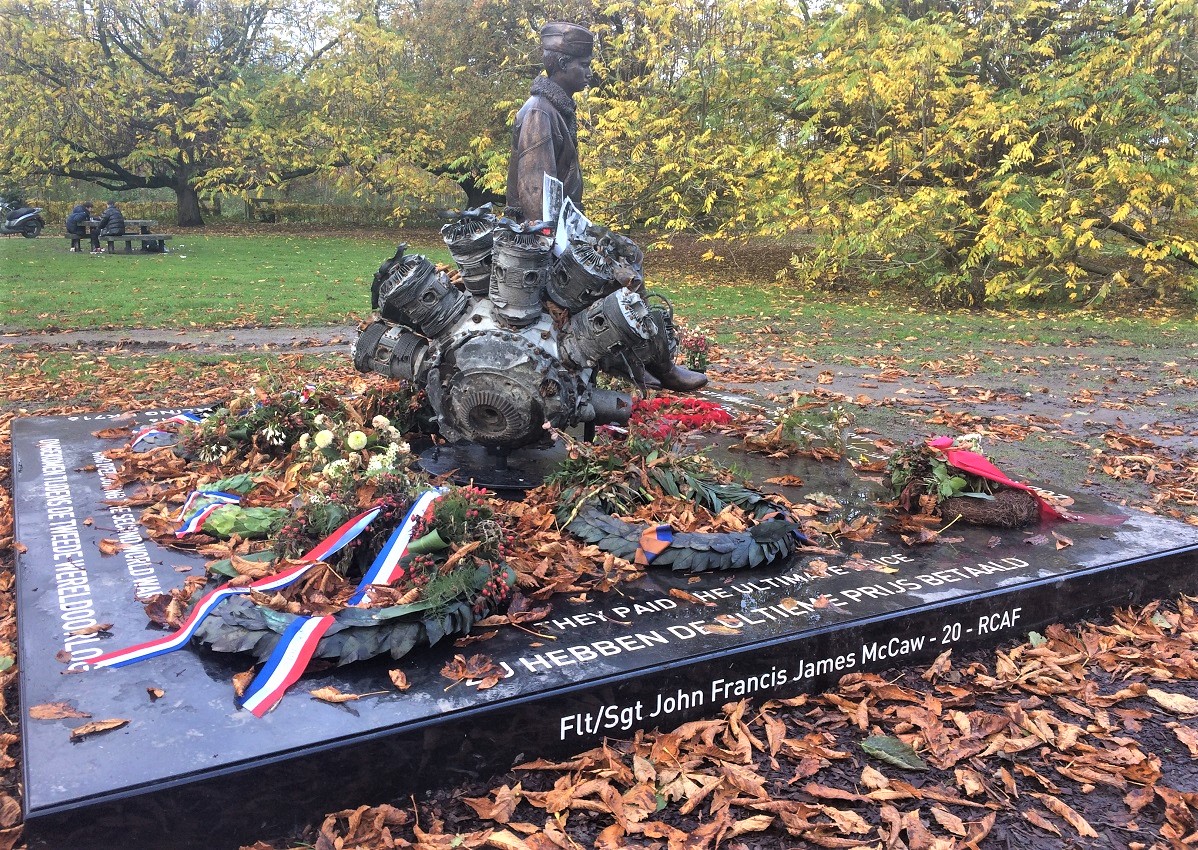
10 November 2021. Thigh bone (Femur) found at former crash site (video). Dutch Wadden Sea shoreline at Den Helder. Stirling W7474, crashed night 3-4 June 1942.
Stirling W7474, 218 Sqn, took off from RAF Marham in the night of 3-4 June 1942 to bomb Bremen. On route over Den Helder, Holland, the Sirling was shot down by German nightfighter Oberleutnant Becker. It crashed on the Wadden Sea shoreline in shallow (tidal) water, just outside the dyk between airbase de Kooy (Den Helder Airport) and Dutch Naval Base Den Helder Harbour. Exact position is nature park Balgzand-het Kuitje, Oostoeverweg. A hiker noticed that the sand had uncovered an struck aircraft tire. A human thigh bone was found also.
Short video: https://youtu.be/2ijea5Ynwhw?list=TLGGQS1WE5VpIscxMDExMjAyMQ
In the days after the crash, the Germans had cleared the smashed wreckage (photo above) and recovered the remains of the crew. One man, Sgt. Cox was taken POW. The Germans buried the remains of what they believed four men in two coffins. First burial was in Den Helder (Huisduinen). All Allied casualties from Den Helder were reburied after the war in CWGC Bergen-op-Zoon War Cemetery, BOZ-British Plot. Pilot P/O John Webber rests with his crew in collective grave 32 A, no. 7 and 8. Five headstone with seven names were placed: Pilot Officer John Webber (19), P/O James Garscadden (29), Sgt. Leonard J. Smith, P/O John D. Insch, F/Sgt. Harold Broadbent (DFM), Sgt. Norman Sibley and F/Sgt. Leo Farley (RCAF).
Restanten vliegtuigband en een dijbeenbot gevonden bij het Kuitje, Den Helder. Stirling W7474.
Sources:
-Streekomroep Regio Noordkop, Sanne Scharloo.
-Book 'Opgegraven Verleden' by Jan Carsjens and Piet Riteco, Den Helder 2005.

31 October 2021. Wreckage of Manchester L7390 has not been found (see below), suggesting a German recovery in April/May 1942. Wreck of Lancaster ED603 was still there. All recoveries are postponed to 2022.
20 August 2021.
In June 2021 the Dutch Military Defence Dive Group (Dutch Army and Navy divers combined) conducted a dive-reconnaissance in preparation of the possible upcoming recovery of the wrecks of Lancaster ED603 and Manchester L7390. Lancaster ED603 is located in Lake IJsselmeer left (west) of the Breezand/Makkum windturbine park (see below), south of Breezanddijk harbour. The Manchester is located east of the park, just under the Kornwerderzand sluices. It has been more than 78 years ago since the aircraft crashed in the Lake during WW2 and the wreckage suffered dearly over the years. Both aircraft lay in shallow water and ships damaged the wrecks. The Manchester crashed on thick ice and is torn-up the most. Because the Germans knew the crash position (the hole in the ice), a previous German recovery in 1942 can not be excluded. The Manchester was a high-tech new type in 1942 in which the Germans had a lot of interest. Both aircraft have MIA crew, possible still in the wreckage, but if a complete and thorough enough salvage is feasible will be based on the June recon and is evaluated at this time.
Video Dutch Army Dive reconnaissance 14 June 2021: https://www.defensie.nl/actueel/nieuws/2021/06/14/marine-zoekt-naar-vliegtuigwrakken-in-ijsselmeer
File on Lancaster ED603: https://www.zzairwar.nl/dossiers/27.html
File on Manchester L7390: http://www.zzairwar.nl/dossiers/18.html
Als volgende op de lijst van het Nationaal Programma Kansrijke Bergingen staan Lancaster ED603 en Manchester L7390. Beide onder de Afsluitdijk in het IJsselmeer, zie tekst boven. Of de bergingen daadwerkelijk uitvoerbaar zijn wordt op dit moment geevalueerd.
ZZairwar (Zuyder Zee Air War).
14 Augustus 2021. Fishermen protest against windturbine park in Lake IJsselmeer, size of city of Amsterdam.
On Saturday August 14 more than 50 fishing vessels with 450 fishermen on board protested against the Makkum/Breezand windturbine park. The huge park with the size of the Amsterdam city centre was constructed in a protected nature zone (!) and in fishing waters. From now on the area is forbidden for boats. To the left and right of this park, two RAF WW2 bombers will be salvaged.
.
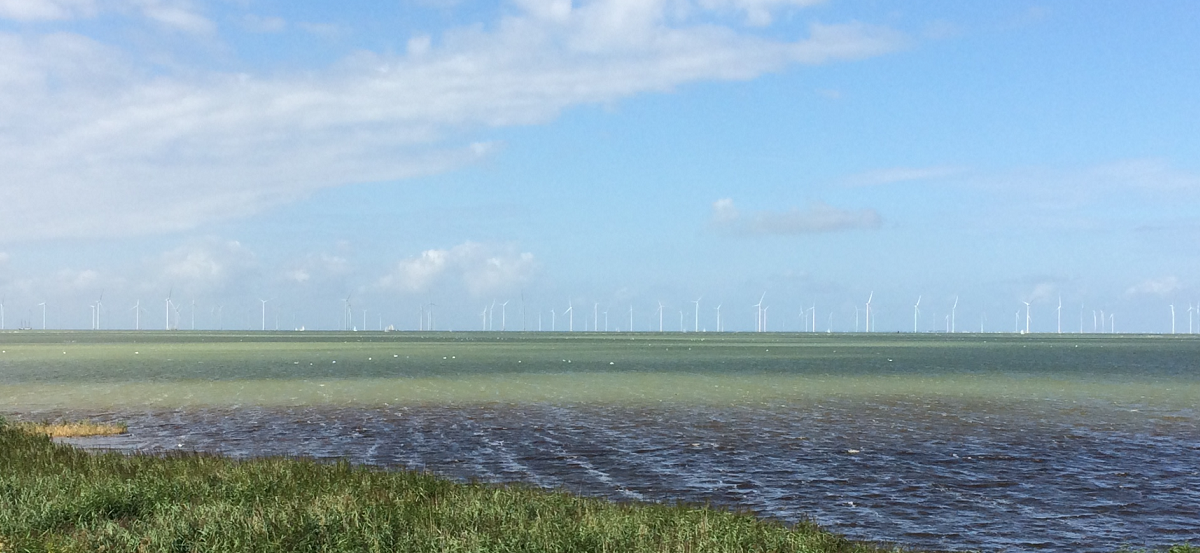
8 June 2021. Recovery ended. Wellington T2990 Nieuwe Niedorp, Czech crew.
Good video, published 18 June 2021 by the Dutch Ministry of Defence (6 minutes, 40 seconds): https://www.youtube.com/watch?v=w8d12R7oeSc
Last 11 June 2021 all aircraft-parts were removed from the ground. The digging is finished. Until 18 June the material will be cleaned. Human bone fragments were found.
Video: https://www.regionoordkop.nl/10/06/2021/alle-wrakstukken-bommenwerper-nieuwe-niedorp-uit-de-grond-gehaald-video
5 Juni 2021. Het IJsselmeer kan zich niet verdedigen.
Het IJsselmeer is nationaal gebied, maar heeft geen eigen bestuur dat voor haar belangen vecht. Dat gaat desastreus uitpakken.
De binnenzee is onderverdeeld bij gemeentes, zie kaart onder. Dat zijn meest landgerichte bestuurscentra zoals Anna Paulowna, Joure, Sneek, Emmeloord, Den Haag, Amsterdam, Provincie Noord-Holland in Haarlem, Lelystad, Almere en Dronten. Helaas zit er IJsselmeer in hun gebied, daar regeren ze met de rug naar toe. In de praktijk toont men met het water weing op te hebben.
Het nationale binnenwater, waar gemeentes een stuk van in beheer hebben, vaak uit de boedel van een andere gemeente of sinds 1960 bij inpoldering in de schoot gevallen, wordt misbruikt voor lokale belangen en probleemgevallen die in het eigen binnenland niet kunnen. Elke gemeente kan met het water z'n gang gaan. Alles bij elkaar gaat het IJsselmeer eruit zien als een lappendeken van plannen van locale wethouders en politici die na een jaar alweer vertrokken zijn. Helaas blijven de lobbygroepen erachter en de schade aan het gebied. Een van de meest schokkende voorbeelden, nog erger dan andere lelijke windturbineprojecten rondom het IJsselmeer/Markermeer, is de aanleg van een enorm windturbinepark van 35km2 dat de gehele Breezand tegenover Makkum zal vullen. De moloch met bijna 100 turbines wordt veel groter dan onderstaande foto van de bouw laat zien. Iedereen die er langskomt stuurt in ongeloof en horror de foto's door in app-groepen.
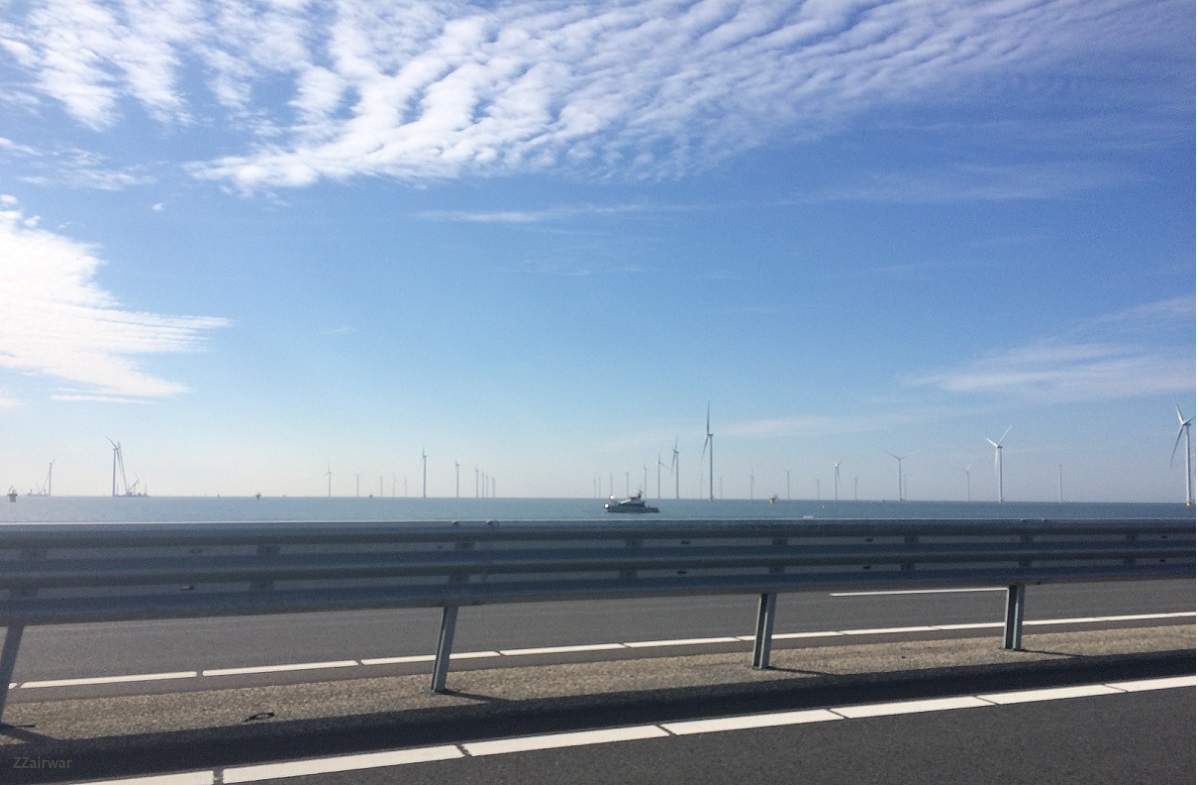
Binnen de gemeentegrenzen van Sudwest-Fryslan, met gemeentehuis in Sneek (zie kaart onder) is het grote turbinepark zo ver als mogelijk uit hun eigen blikveld geplaatst, op de Breezand, op maximale afstand van eigen weiland, bebouwing, kustlijn, gehoor en zichtlijnen. De naam Windpark Friesland 'Friese Windenergie' is een aanfluiting, het park staat midden in ons IJsselmeer. Het enige Friese eraan zijn veel van de financieel belanghebbenden die dit stuk nationale zee hebben gekaapt en vernietigd. Het is te hopen dat over een jaar of 10, als de dwaling wordt ingezien, subsidies stoppen of onderhoudskosten te hoog worden, het gedrocht ook door Sneek wordt opgeruimd, inclusief de funderingen.
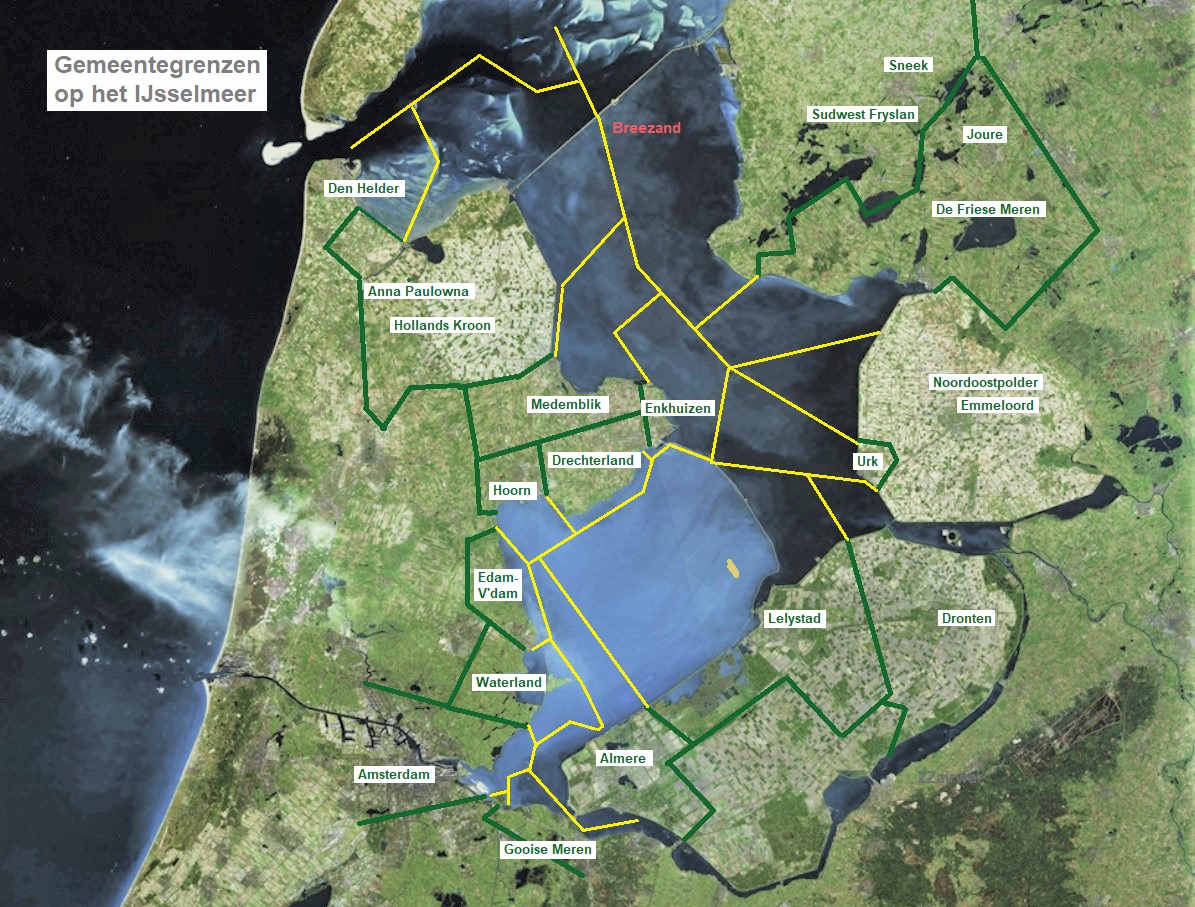
De gemeente Sudwest-Fryslan volgt andere agrarisch ingestelde gemeentes, zoals Noordoostpolder en Dronten, die hun kustlijn al met turbines hebben dichtgebouwd en de link met het water definitief hebben verbroken. Verwachting is dat Hollands Kroon snel zal volgen en ook met turbines het water op zal gaan. Hollands Kroon is wel Wad-gericht, maar het IJsselmeer is in de praktijk geen issue, alleen voor waterwinning. Urk zal als laatste tot turbineplaatsing in haar watergebied overgaan of het kunnen weerstaan. Drechterland, Edam-Volendam en Gooise meren (Muiden) hebben geen water meer, dat heeft men aan nieuwkomers Almere en Lelystad moeten afstaan zoals bovenstaande kaart laat zien. De gemeenteraad van Amsterdam (Maarten van Poelgeest en Eric Wiebes) heeft in 2010 haar oog op het Markermeer laten vallen. Dit zal volgebouwd worden. Hiervoor heeft men moeten opvaren samenspannen met Almere en Lelystad, anders was dit voor Amsterdam onbereikbaar gebleven. Proefproject Het Lelystadse Vogeleiland is al gerealiseerd. Ingehuurde PR-specialisten bedachten hiervoor de naam 'Marker Wadden'. Dit wekt namelijk de indruk dat het hier om een sympathiek op zichzelf staand natuurproject gaat. In feite is dit, inclusief de 'dijkversterking' die Rijkswaterstaat uitvoert aan de dijk Enkhuizen-Lelystad, de start van de Markerwaard 2.0. Vanzelfsprekend volgen we de ontwikkelingen en de omgang met vliegtuigwrakken en vermiste bemanning.
30 May 2021. Liberation of Ameland Island, 3rd of June 1945. Dunkirk June 4, 1940.
To commemorate the (late) liberation of Ameland on 3rd June 1945, and the last day of the evacuation of Dunkirk 4th June 1940, we have updated our webpage on the Ameland 'Dunkirk' war graves. We have identified the Allied officer visiting Ameland and its war graves in June 1945 as Canadian Major-General Guy Simonds. File: http://www.zzairwar.nl/dossiers/899.html
Further research made it clear that most of the end July/begin August 1940 washed ashored men on Ameland Island (near 50), came from one ship: the Emile Deschamps, the last ship leaving Dunkirk. Succesfully evaded loaded with people, but struck a mine off Ramsgate.
Bevrijding Ameland 3 juni 1945. Onze webpagina over de (verdwenen) 'Duinkerken'-oorlogsgraven op Ameland is bijgewerkt. Generaal Guy Simonds bezocht zo te zien het eiland juni 1945. De meeste van de groep van 50 drenkelingen die eind juli 1940 op Ameland aanspoelden komen van één schip: de Emile Deschamps, het laatste schip dat Duinkerken verliet in de nacht van 3 op 4 juni 1940. Het voer in een lijn van schepen vlakbij de Engelse kust bij Ramgate en zo goed als veilig, toen een magnetische mijn onder het schip volgepakt met evacuees ontplofte. Bemanning en opstappers spoelden twee maanden later aan op de hele Nederlandse kust, bijna 50 op Ameland, maar ook Vlieland, Harlingen, Terschelling, Schiermonnikoog en Rottermerplaat. Ook van schepen die in de 1e wereldoorlog zonken bij Ramsgate dreven drenkelingen aan op de Waddeneilanden.
9 May 2021. 09 May 1941, 80 years ago, Wellington R1322 shot down in Lake IJsselmeer. A wartime film has turned up of the funeral of rear gunner Ludwik Karcz, July 1941.
See link: https://nos.nl/artikel/2379224-eervolle-begrafenis-boordschutter-wo-ii-op-film-blij-verrast-met-beeld
The film was made by mr. Dirk de Boer, who was working on construction projects in Urk 1940-1945. Six cans with film reels were donated by the family.
The wreck of Wellington R1322, pilot Jan Dorman, Polish 305 Sqn was recovered in 2017 (see further below this page). But rear gunner Corporal (Kapral) Ludwik Karcz had washed ashore two months after the crash. His body was found at the Noordoostpolder-dike on the 1st of July 1941, north of Urk just below 'Rotterdamse Hoek'. Crash location of R1322 being in sea 6 km to the NW.
The people of Urk gave the Allied pilot (they named him 'KORCZ') a funeral with all honours, to the dislike of the Germans who were also present at this funeral. In September 1941, after again such a burial, the Germans forbade further interment of allied pilots on Urk Island.
The images on the film could be identified as the Karcz burial, because in 2014 we established based on old photos that his funeral had taken place July '41. The photos showed the same people as on the de Boer film. The Urkers placed a white stone cross on the grave (photo below). On the right KORCZ, burial date 2.7.'41. It was a joint grave (two coffins stacked). End May 1941, before Karcz, another washed ashore British airman was buried in this grave as first, see left 'D. Mc D'. burial date 25.5.'41. In 2014 we could identify him as Sgt. Duncan McDougall, the WO/air gunner of Wellington W5375. More on Urk cemetery: http://www.zzairwar.nl/dossiers/915.html
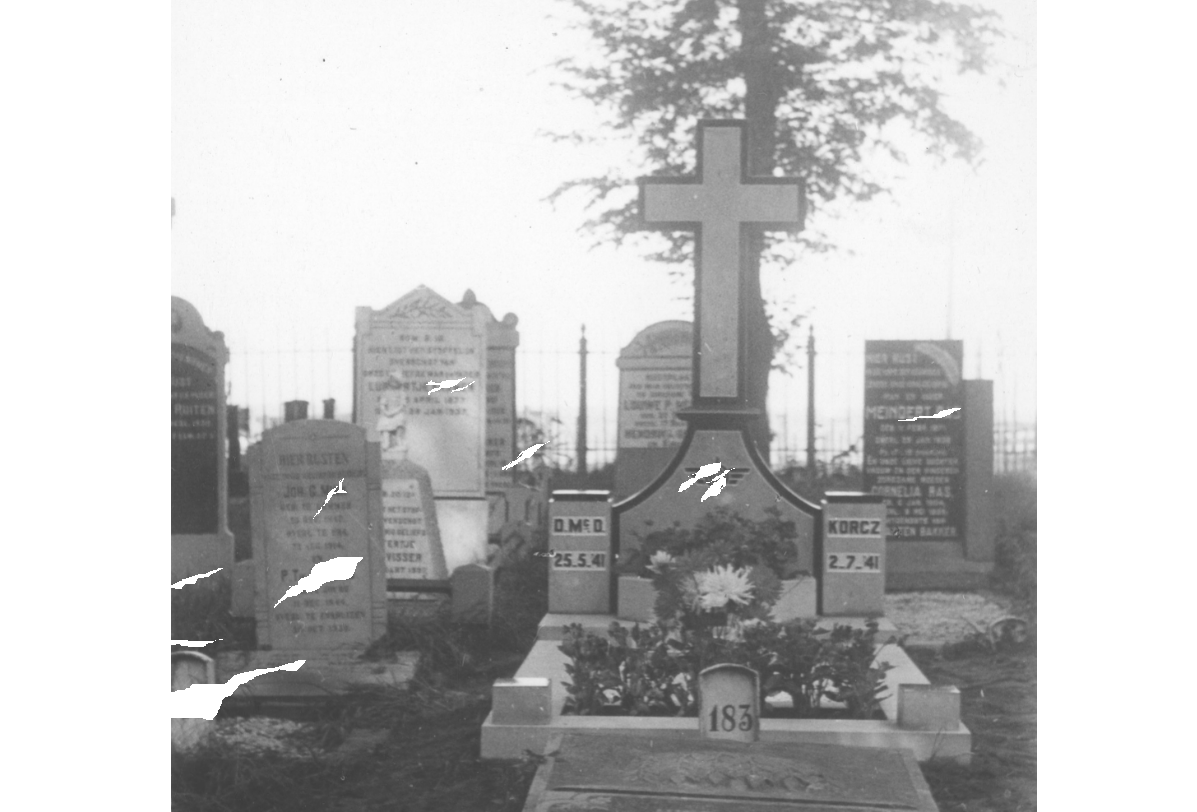
06 March 2021. Recovery in May 2021 of Wellington IC T2990 of RAF-Czech 311 Squadron. Clearing the field grave in Village Nieuwe Niedorp.
Het veldgraf in Nieuwe-Niedorp wordt na 80 jaar geruimd. De mannen die daar sinds juni 1941 onder een monument liggen worden herbegraven.
In the night of 22/23 June 1941, a small force of 45 Wellingtons and 25 Hampdens bombed Bremen just after 01:15h. Wellington T2990 with pilot F/Sgt. Alois Rozum and co-pilot F/Sgt. Vilém Bufka made their return over east-Netherlands (Drenthe) and headed in a strait line back to their base East-Wretham in England. South-west of Lemmer, they entered 01:59h, altitude of 4000m, the zone of German radar station 'Hering' (Herring) located at Medemblik. The German nightfighter flying patrol in Hering, Oberleutnant Prinz Egmont zur Lippe-Weissenfeld and his radio operator Unteroffizier Jozef Rennette in their Me-110 of 4./NJG1 headed east over Lake IJsselmeer (old Zuider Sea) towards the bomber to intercept it, talked to the target by Leutnant Jauk of the radar station.
Survivor F/Sgt. Bufka describes a long fight in which the German nightfighter attacked multiple times from below, before they finally spiral burning down without an engine and a wing at Nieuwe Niedorp. According to his account, Sgt. Bufka helps pilot Alois ('Lojza') Rozum and front turret gunner Sgt. Jan Hejna to parachute out (see link to his story further below). A jump into the Lake under Medemblik is possible, but they were never found. German pilot zur Lippe however reports that he followed the bomber for some time and made two unsuccessful approaches, but in the third he opens fire and it dives down at Nieuwe Niedorp. Lippe and Rennette visited Bufka next day in Hospital. The opening in May of the official field grave at Nieuwe Niedorp will at least unearth the remains of the three men who died in the radio room, at the navigation table and in the rear turret: Pilot Officer Leonard Smrcek, P/O Vilém Konstacky and gunner F/Sgt. Karel Valach.
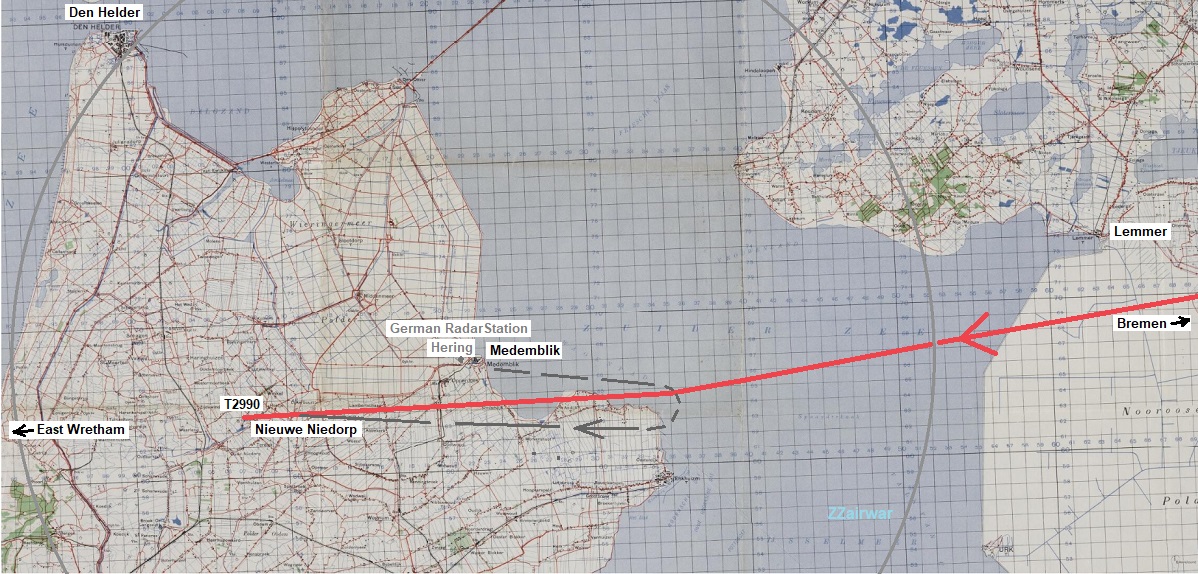
Below. The yellow sign announces that the field grave (insert) behind the farm has been removed because of upcoming events.

Below. The crash location at Nieuwe Niedorp. Field grave monument removed. The exact position of the wreck in the soft ground is determined for the operation in May.
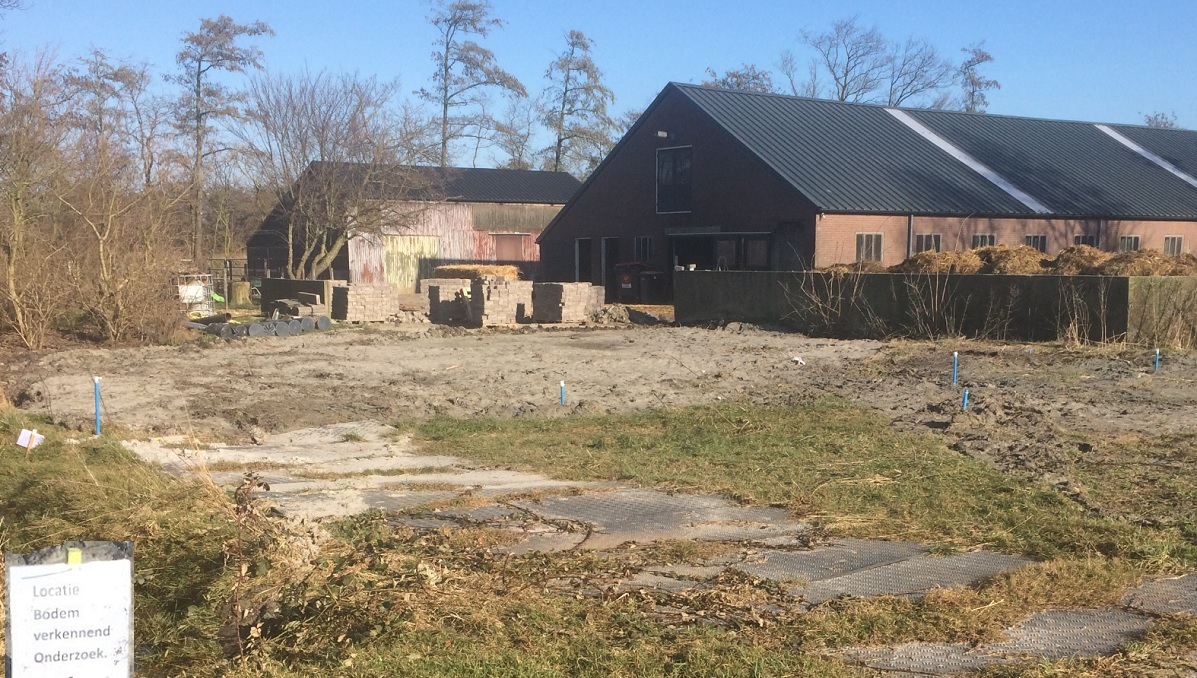
File 467 on Wellington T2990 and F/Sgt. Bufka story: http://www.zzairwar.nl/dossiers/467.html
Het is nog niet bekend of een zelfde veldgraf in Zuidoostbeemster ook wordt geruimd. Blenheim R3892.
It is unknown at this point whether a simular fieldgrave (Blenheim R3892) in Zuidoostbeemster will be cleared also: http://www.zzairwar.nl/dossiers/392.html
===
12 November 2020. With the 4th recovery, the Dutch Air Force closed the Dutch WW2 National Aircraft Recovery Program for this year, recommences April 2021.
Up to now these four aircraft were recovered:
Recovery 4. 02 Nov/13 Nov 2020. German Me-109 G-6. Werke-Nr. 27023, 8./JG 1. Schwarze 10. Between Zwolle and Millingen, under Dalfsen, Hamlet Hoonhorst, Oude Vechtsteeg.
Shot down: 30 Jan 1944. Was location known: yes. Marked by an old field grave marker or monument: yes. Number of crew expected in ground here: 1. Found: yes. Uffz. Otto Tillack.
Recovery 3. 31 Aug/ 9 Oct 2020. Stirling BK716, HA-J, 218 Sqn RAF. In Lake IJsselmeer (Old Zuyder Sea) 4 km SE of Marken. Start recovery in April 2020 was postponed because of Covid.
Shot down: 29/30 Mar 1943. Location known: yes, since 2008. Stirling BK710/716. GPS position: yes. Number of crew expected in mud here: 1-7. Found: yes/some, bone fragments in research.
Recovery 2. 11 Nov/15 Nov 2019. Typhoon MN582, 175 Sqn RAF. Location south of Deventer, between Gorssel and Eefde, Lindeboomweg-road.
Shot down: 26 Sep 1944. Was location known: yes. Marked by an old field grave marker or monument: yes. Number of crew expected in ground here: 1. Found: yes. F/Sgt. William R.S. Hurrell.
Recovery 1. 16 Sep/30 Sep 2019. Stirling W7630, MG-M, 7 Sqn RAF. Location between Sittard and Roermond, in Echt-Susteren, Hamlet Peij, field of Abby Lilbosch, Patersweg-road.
Shot down: 10/11 Sep 1942. Was location known: yes. Marked by an old field grave marker or monument: yes. Number of crew expected in ground here: 4. Found: no. No trace.
Up to now (per 12 Nov 2020 en 2021), the aim was/is for known locations because the Program's objective is recovering airmen in the known wrecks for which recovery is long overdue.
Since the budget of 15 million Euro is still largely intact, it may be possible in future that also search and recovery is started for lost aircraft for which the crash location is roughly known, but not exactly. For example Wellington Z1470, UV-R of 460 Sqn (Royal Australian Air Force), lost 02/03 July 1942, 4 MIA. File on Wellington Z1470.
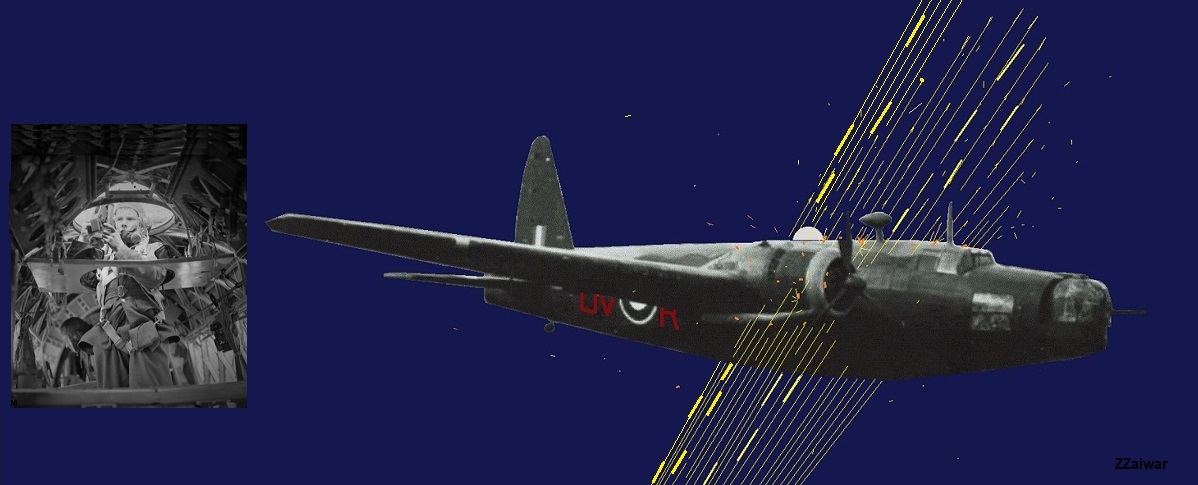
2020, October 9. This Friday was the closing day of the five week recovery of Stirling BK716.
The project on the Lake has stopped. The findings will be further examined and the Dutch Air Force will report to the British MOD, this will take several weeks. On this last Friday at 15:00h, the Dutch Ministery of Defence published a video (01:34 minute) filmed on board the recovery ships. It gives detailed insight in the work method used. At 01:12 the pilot's steering wheel is shown. Link (video 01:34 is below the page): https://www.defensie.nl/actueel/nieuws/2020/10/09/berging-britse-bommenwerper-in-markermeer-afgerond
2020, September 22. Status recovery BK716, human bone fragments found.
Last friday some small human bone fragments were recovered. They were not identifiable at this stage. The bone condition was poor, quality for DNA-extraction insufficient. The search will go on for another 2,5 weeks. Every find will be send to the Dutch Army Identification Centre for further research.
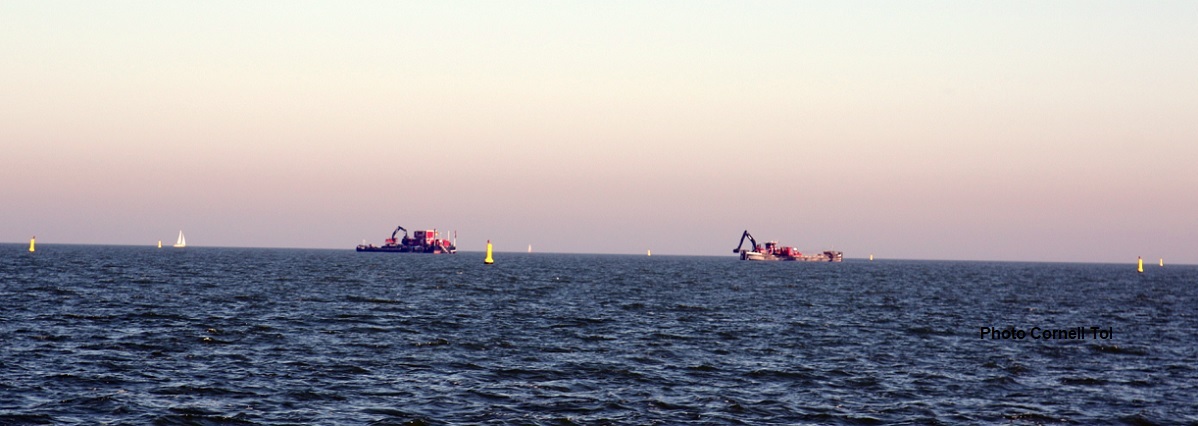
.
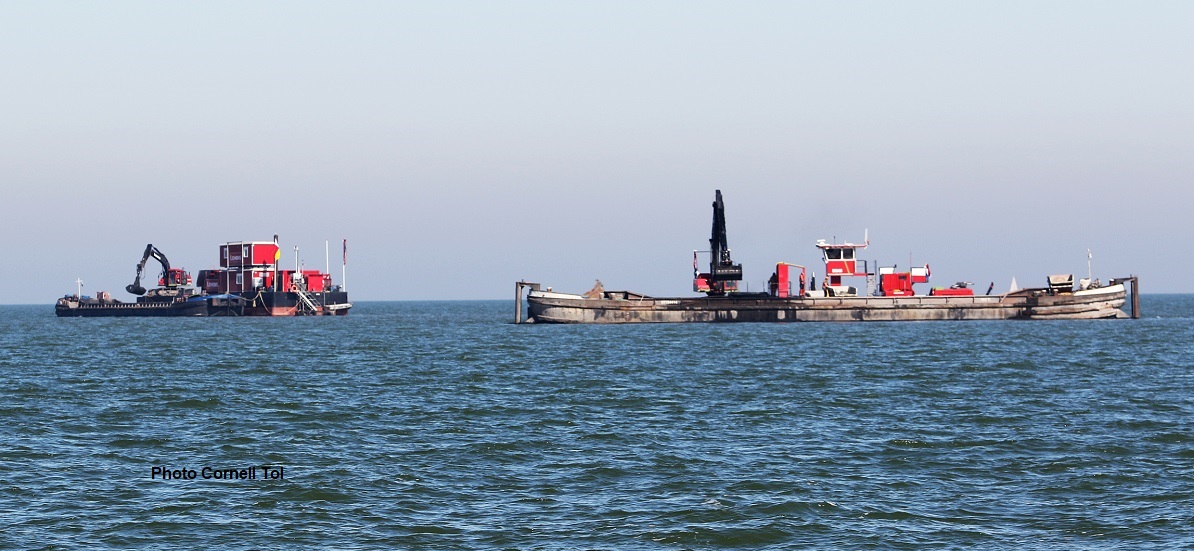
.
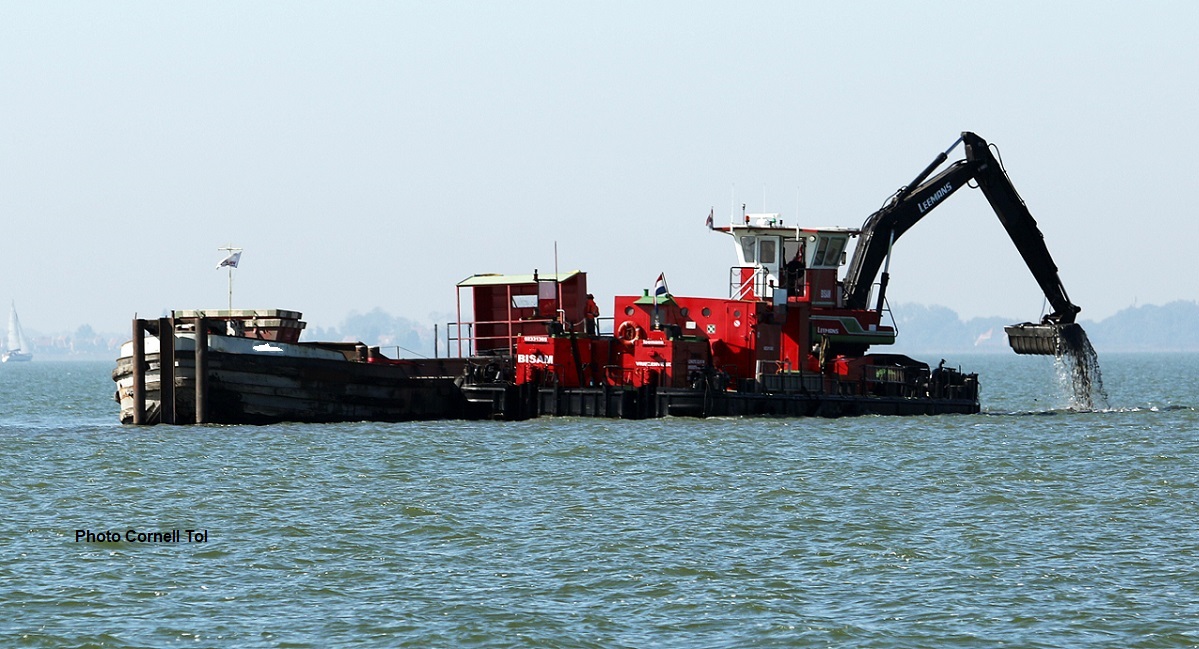
.
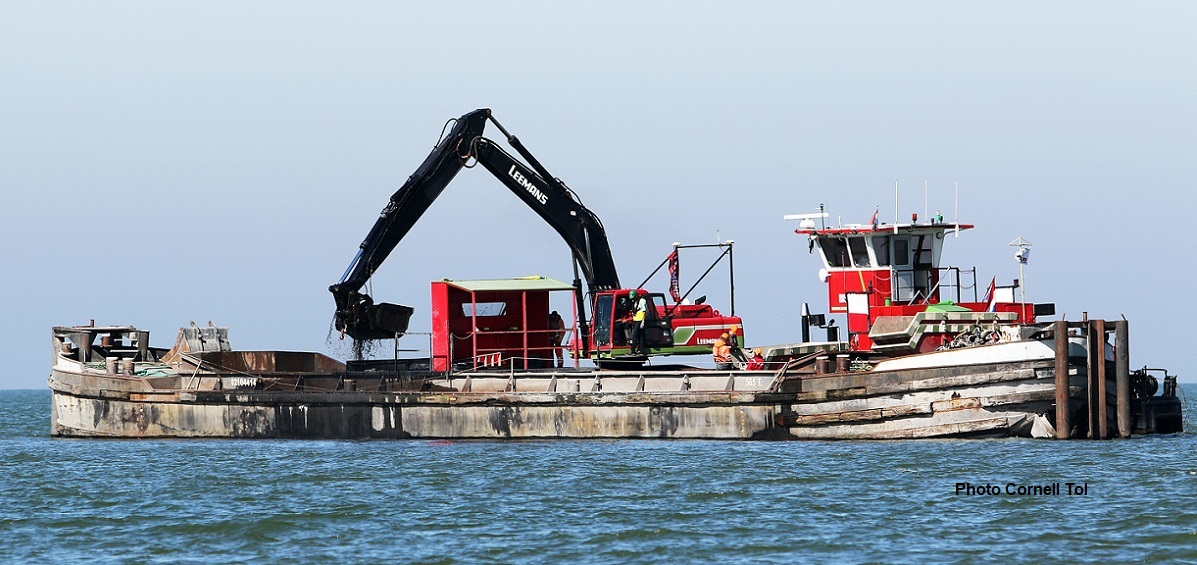
2020, September 15. Second motor with propeller found, no human remains until now.
A spokesman declared that up to now no human remains were found, but in the recovery process they are getting now closer to wrecked sections of the fuselage.
2020, September 13. Last hours of the BK716.
In the evening and night of 29/30 March 1943 two raids were planned, one on Bochum and one on Berlin. The German night fighters took positions in their patrol area, waiting for aircraft to cross. Around midnight Major Helmut Lent, guided by radar station Eisbär at Sondel near Lemmer shot down Wellington JB762, which crashed near Nijemirdum: http://www.zzairwar.nl/dossiers/959.html . Twenty minutes later Feldwebel Heinz Vinke guided by radar Zander at Zandvoort also shot down a Wellington 20km west of Zandvoort, crashing in the North Sea. This was the X3965 of 166 Sqn.
Later that night the bombers from the Berlin raid returned. They had flown to Germany over the North Sea, north of the Wadden Islands and entered the German coast near Bremen. After Berlin they followed a 270° west course to the Dutch coast and then back to England. Guided by radar station Hase at Harderwijk, Leutnant Werner Rapp and his radio operator Unteroffizier Ortmann of the 7th Gruppe of the first Nachtjagergeschwader from Twente and Deelen airfields, first shot down Lancaster ED761 on 4800 meter which crashed between Waverveen and Vinkeveen. This was at 04:12h. After the war their graves in Waverveen were exhumed: http://www.zzairwar.nl/dossiers/859.html .
Lt. Rapp in his Messerschmitt Bf-110, type G-4, squadron code G9+CR, then returned to his radar patrol box 'Hase' and was a half hour later directed to a lower flying bomber at 4300 meter. This was the BK716. Lt. Rapp reported shooting down 'Stirling, 2-4 km East-Southeast of Marken Island'. Source: book 'Nachtjagd Combat Archive 1943 part 1' by Theo Boiten, 2018. Lt. Rapp's report (previously unknown) thanks to Boiten's book, initialised the turn of identification of the Stirling wreck east of Marken from BK710 into BK716.
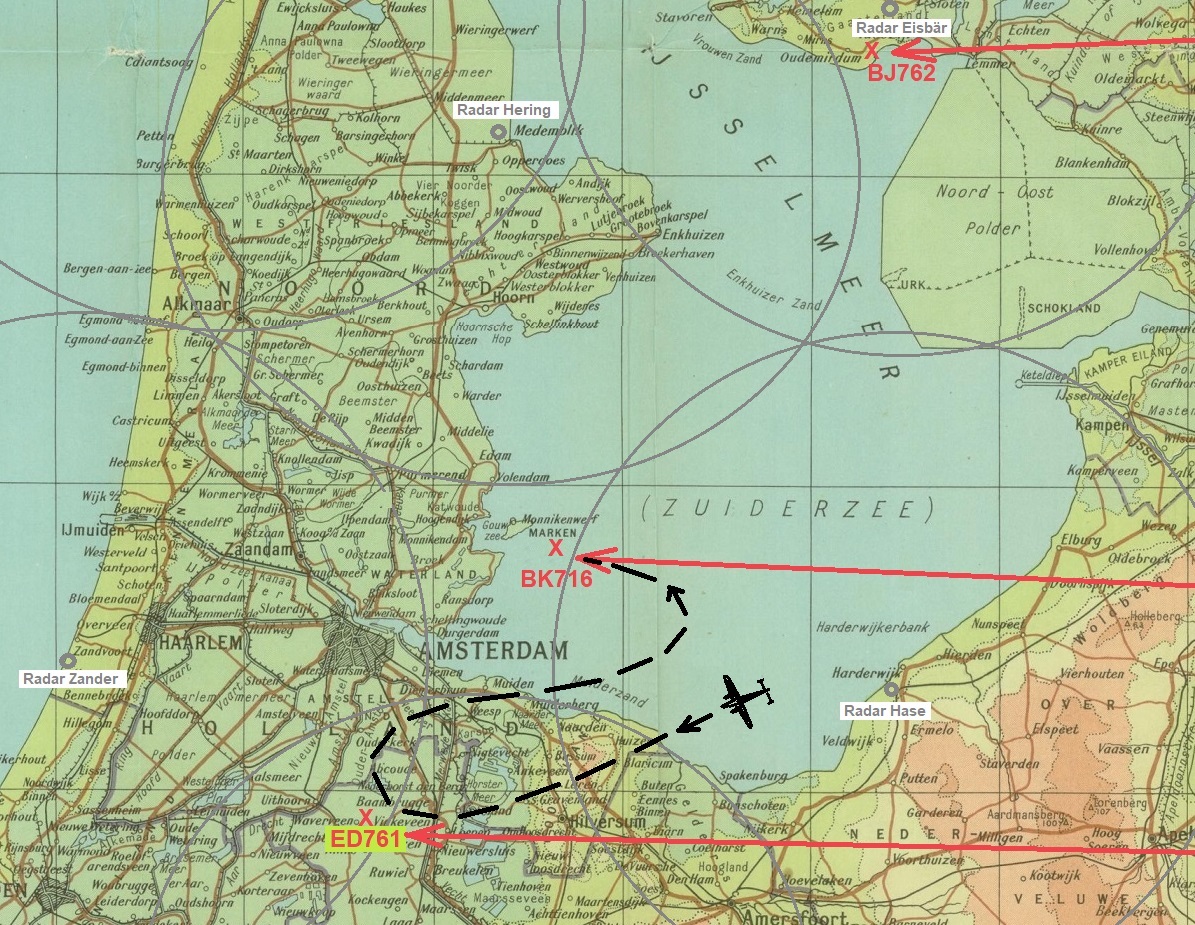
2020, September 8. Progress on recovery Stirling BK716. Engine found.
At the end of the first recovery week, one of BK716's engines was recovered from deep in the mud. It is a Bristol Hercules Mk. VI ('HERC VI' as was engraved on it, see photo below). Before take-off on March 29, 1943 it was recorded by the ground crew in the maintenance books that a Herc 6 with this serial number was fitted to the BK716. The Hercules VI is a radial engine with two rows of seven cylinders, 14 cylinders total. On the photo the engine lays face down. Most of the 14 cylinder heads broke off from their shafts during the hard crash on the water, three are still attached. More photos of a Bristol Hercules from the Lake: https://www.zzairwar.nl/dossiers/110.html
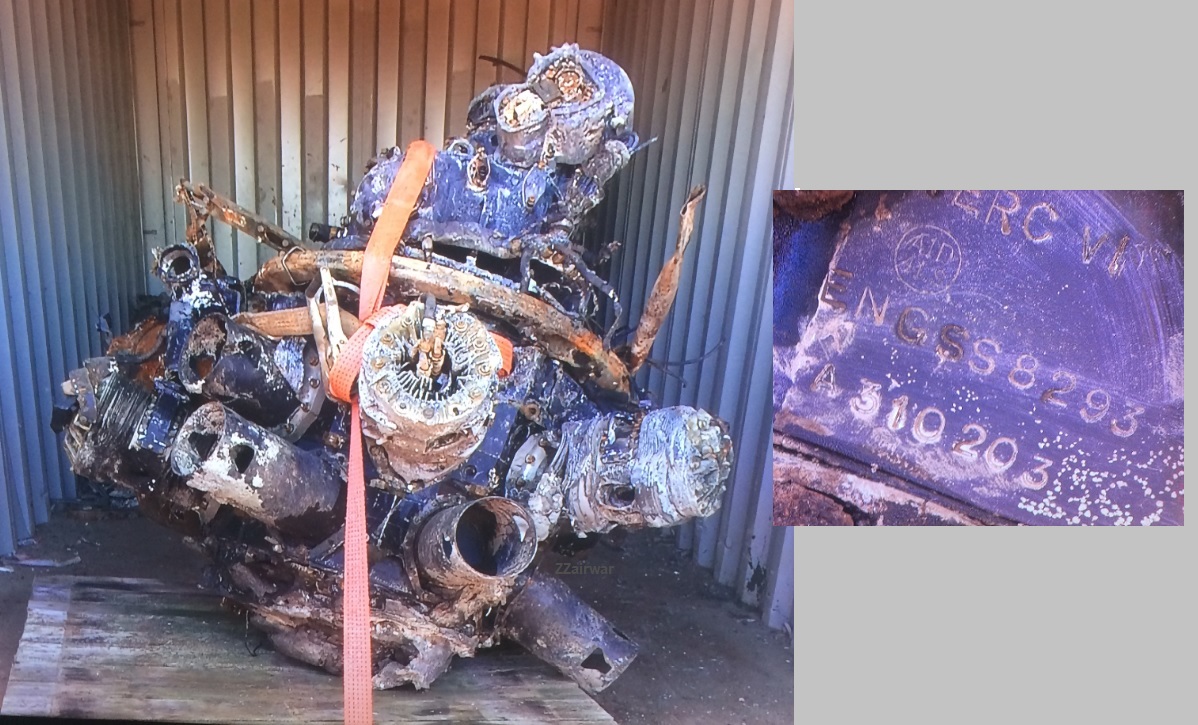
Source: NOS.
2020 August 31. Recovery of Stirling bomber BK716 started. Lake IJsselmeer, Marken/Almere, Holland.
Monday August 31 the recovery ship sailed out after a 4 month delay because of Covid-19. The bomber lays fully desintegrated in hundreds of pieces in the mud, spread out in a square area of 75 x 75 meters. Water depth is only 3,5 meter, but the lake bottom here is a soft muddy clay that runs down for more than 10 meters. In this thick mud-layer most aircraft pieces are unvisible embedded. It was already established years ago that a cofferdam to pump the water out and recover the aircraft parts by hand was impossible due to this mushy seabed which could also not support a cofferdam wall. In past weeks a survey ship probed the bottom with a sub-bottom profiler and magnetometer and entered the objects that were scanned in the mud onto a digital map. The recovery ship is equiped with an excavator that will carefully extract the mapped objects and its surrounding area. All extracted mud will be filtered.
In March 1943, this Stirling bomber came down from high altitude. Because of the hard, shattering and splintering crash on the water, the previous recoveries in and just after the war on this location and the 77,5 years that have passed, it would be already an excellent result if any crew remains (bone fragments) of the MIA seven men will be found. In such cases individual identification of crew members is usually unachievable, although every attempt will be made to succeed in this. The recovery is made under supervision of the Dutch Military with hired-in specialized civilian contracters. Recovery will take five weeks to complete.
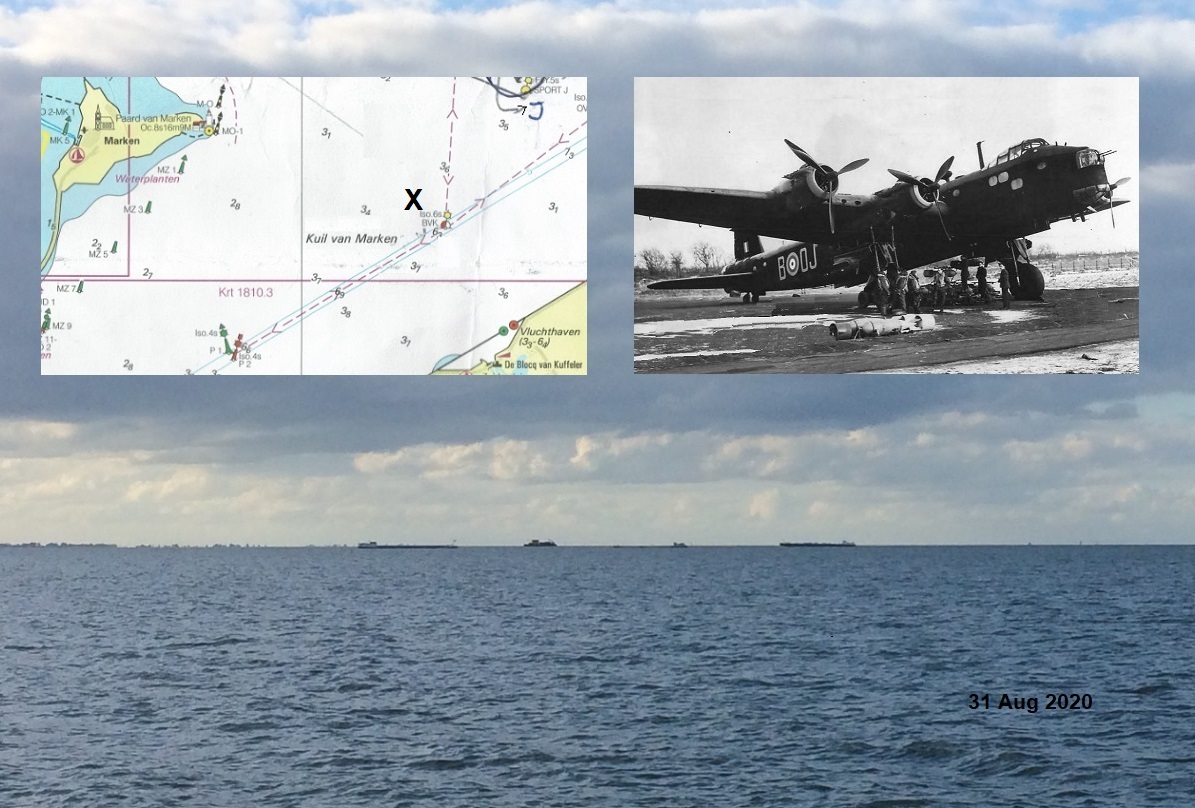
2020, January 27. Recovery of Stirling BK716 scheduled April 2020. Lake IJsselmeer, Marken/Almere.
As part of the Dutch National Recovery Program, next WW2 bomber to be recovered is the RAF Short Stirling BK716 of 218 (Gold Coast) Squadron with seven crew MIA. Position is Lake IJsselmeer, near Almere. It had a painful start. In 2008 the wreck was incorrectly identified as the Stirling BK710. This was based on a barely readable painted code and a wooden elephant. This lead to visiting relatives from all over the world and a monument for BK710 on Marken Island. In 2019 it became clear that it was another plane, the Stirling BK716 of 218 Gold Coast Squadron, a squadron that fitted the wooden mascot elephant even better than BK710's 149 East India Squadron (read more with photo below at News 2018, November 28). The location was probably visited by the German recovery ship in 1943, as they were very active in this part of the Lake (example photo) and because little is left on the Lake bottom today. No burials of BK716's crew have been reported during the war. However burial as not-identified airmen is possible. The location was given on the map 'Cross 75' end 1950s/begin 1960s when the tail section of a then unknown bomber was recovered. File on Stirling BK716: https://www.zzairwar.nl/dossiers/355.html

2020, 27 januari. Berging van Stirling BK716 gepland voor april 2020. IJsselmeer ten oosten van Marken, voor het gemaal Blocq van Kuffeler, Almere.
Als onderdeel van het 'Nationaal Programma Kansrijke Bergingen' is het de beurt aan RAF bommenwerper Short Stirling BK716 van 218 'Gold Coast' Squadron. De crew van zeven is vermist. Positie is in het Markermeer bij Almere. De vondst van het wrak had een pijnlijke start. Het werd in 2008 incorrect geidentificeerd als zijnde de Stirling BK710, een andere vermiste Stirling. Dit kwam door een nauwelijks leesbare code en een houten olifantje. Dit leidde tot bezoek van familie van over de hele wereld en een monument voor de BK710 op Marken. In 2019 werd echter duidelijk dat het om de BK716 ging, een toestel van 218 'Gold Coast' Squadron. Een squadron waar de mascotte-olifant nog beter bij paste dan BK710's 149 'East India' Squadron (lees meer hierover met foto hieronder bij News 2018, November 28). De locatie is hoogwaarschijnlijk door het Duitse bergingsschip in 1943 bezocht, omdat de Duitsers in dit gedeelte zeer actief waren (zie foto van een geborgen Stirling als voorbeeld) en omdat er vandaag niet veel meer ligt. Er zijn in 1943 geen bemanningsleden van BK716 geborgen, wat bij een berging wel gebruikelijk was. Het is mogelijk dat crew als unknown airman rondom het IJsselmeer begraven ligt. De crashlokatie kwam einde jaren 1950/60 op de kaart als kruisje 75, toen een staartgedeelte werd geborgen van een toen een onbekend gebleven vliegtuig. File on BK716: https://www.zzairwar.nl/dossiers/355.html
2019, November 1st. The 1979 documentary "Some of our airmen are no longer missing" 40 years old.
The above documentary was made in the new Dutch South Flevo polder. A section of the Old Zuyder Sea, made dry in 1968. Several WW2 aircraft wrecks emerged. A British film crew followed Dutch Air Force recovery officer Gerrit Zwanenburg (MBE) for some years, first take is from 1971, last from 1979. Seven aircraft and their crews are highlighted (two American, three RAF and two German). Which planes were involved and precise location was not revealed. We took a close look and explain under what is shown:
03:10 - 13:15. Intro. Holland's airspace. Schiphol. The You-Tube link for the docu: https://www.youtube.com/watch?v=gTpAXE4WIJM
13:16 - 13:59. Wall of Missing (USAAF) in Margraten. 1200 American airmen missing over water in/around Holland.
Names of F/Lt. Kent Miller, George Pasvanis (Passavant), Stanley Pilch and James Childers of B-24H 42-7638.
14:00 - 14:14. Wall of Missing (RAF) in Runnymede. 22.000 RAF airmen missing.
14:15 - 16:00. Year 1960. Holland reclaiming land, building dikes. Birth of polder Flevoland in Lake IJsselmeer (correct pronounced 'Eisselmeer', not 'Isselmeer').
16:01 - 16:59. Bombs & shells. Mr. Zwanenburg walks with a bomb-locator (metal detector) through green bushes towards an aircraft wreck, (No. 1) B-17G 42-30280, crew Holcombe.
This is 1971, in the new South Flevoland polder. Direct south of Zeewolde, southwest of Harderwijk.
17:00 - 17:59. First thing you do. Explanation by Mr. Zwaneburg on aircraft identification. Part number 1-2-9. Stands for Short Stirling. Factory inspection stamp 'SHB'. Recovered 1972.
Short & Harland Belfast. Excludes other Stirlings build by Rochester & Austin. Process of elimination. Shell 1942. About (No. 2) Stirling BF523, crew F/Sgt. Morey. Bridge Nijkerk.
18:00 - 18:37. OF sign. Code for 97 Squadron. Lancaster crashed Amsterdam Volewijkers park, recov. 1962. (No. 3) Lancaster R5512, OF-C, crew P/O Eales. His grave Groesbeek War Cemetery.
18:38 - 19:16. This is again a lucky shot. This was from a Heinkel 115, which was a German float plane. From Amsterdam seaplane base (Schellingwoude). Serial number 2218.
The Germans recovered this seaplane in WW2. Mr. Zwanenburg found little pieces back in 1974, South Flevoland, west of Almere stad. (No. 4): Heinkel 115, Werk-nr. 2218.
19:17 - 27:30. Shipham to Münster. The 1975 recovery in the Oostvaardersplassen, north of Almere. (No. 5) B-24H 42-7638, crew F/Lt. Kent F. Miller.
27:31 - 30:23. Advertisements.
30:23 - 32:34. The morning is freezing cold, just as it was in February 1941. In the second car is John Hall, sgt. gunner in the rear of a Wellington bomber. Emergency landing on the Lake ice.
One KIA. The location where they stand is the Zeebiesweg-road no. 25, Biddinghuizen (No. 6) Wellington T2702, crew Sgt. W. Garrioch, RAF 15 Sqn. Night 10/11 February 1941.
32:35 - 36:59. Continous with parts of B-24H 42-7638 and Stirling BF523 (the bottle of oil from the Bristol Hercules radial engine).
Personal items shown of F/Lt. Kent F. Miller. His brother interviewed in 1978.
37:00 - 40:20. About the 'Safe route' over Holland to Germany. German defences.
40:21 - 43:09. Sgt. Brian Bacon of Stirling BF523, found back in the 1972 recovery. His sister Beryl interviewed. Commemoration at the propeller monument in Dronten, 1979.
43:10 - 43:45. Sgt. John Hall about MIA. Followed by Mr. Ron Emney (must be: Emeny). Sgt. R.T. Emeny shot down over France (evd) in Lancaster ND556, crew F/Sgt. Lissett, 3/4 May 1944.
43:46 - 46:44. Karl-Heinz "Charly" Willius. Oberleutnant, German fighter ace. Recovered 1976, Kamperzeedijk, Genemuiden (No. 7). Fw-190, Werke-nr. 170009, 2./JG26, 8 April 1944.
He was buried 1972 in the German Centralisation War Cemetery Ysselsteyn, grave STE-6-67. This is not 'outside Nijmegen', but 30km more south near Venray.
46:45 - 49:32. Losses of personnel. Bomber Harris and General Doolittle. Walking through the grass in Flevoland, about future findings.
49:33 - 50:04. Co-pilot Lt. Charles Taylor, only survivor of B-24H 42-7638, laying flowers in US War Cemetery Margraten, 1975.
50:05 - 51:19. Sgt. William (Bill) Howarth of 617 Dambuster Squadron, crew F/Lt. Les Munro, Lancaster ED921, 16/17 May 1943. Mrs. Beryl Bacon. Brother F/Lt. Kent Miller.
51:20 - 53:03. Credits and End.
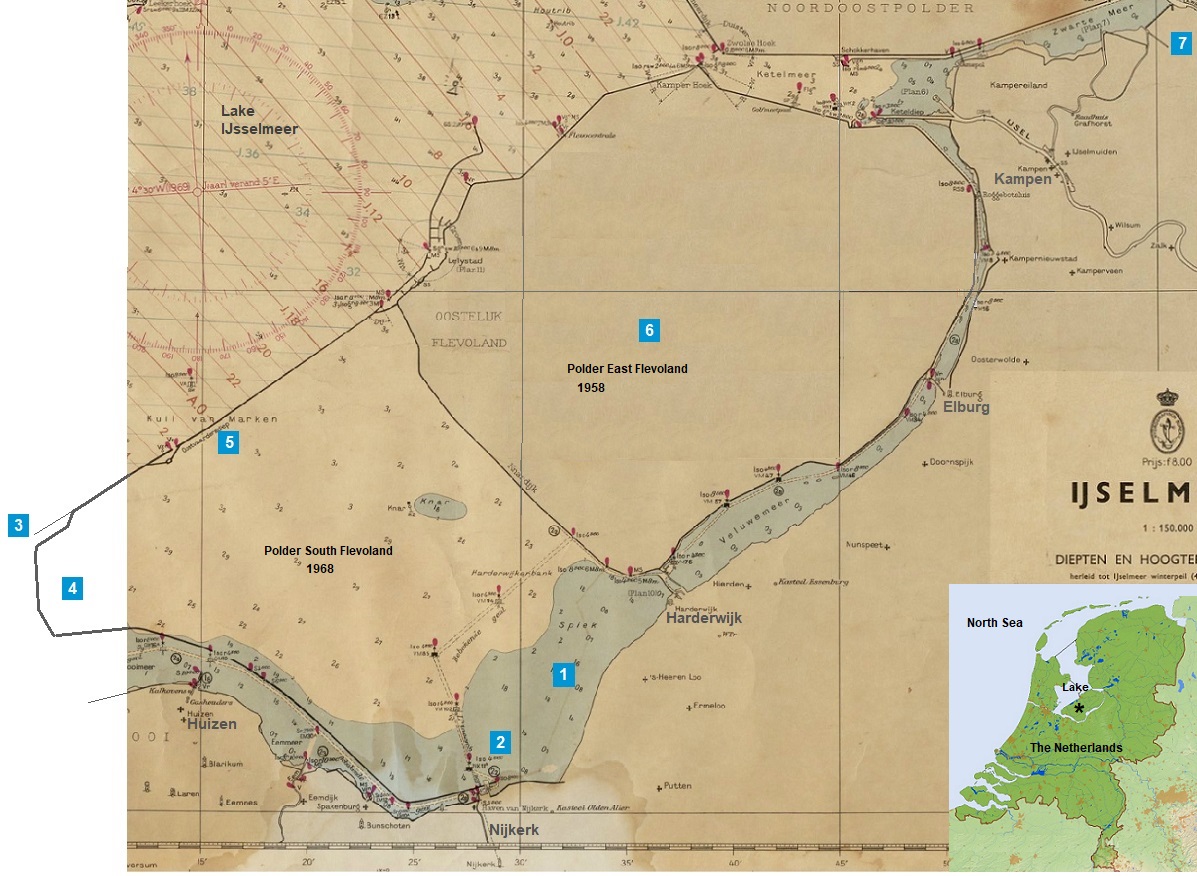
2019, May 5th. Monument and book presentation on B-17G 'Crazy Horse' at Zeewolde, Flevopolder, Netherlands.
In a very well organized ceremony with foreign relatives invited, the Dutch community Zeewolde commemorated the crews of three Allied aircraft crashed on her grounds in 1943-1944 when this area was Zuyder Sea. An information pole with a bomber silhouette was positioned on each crash position. A general monument (see below) was unveiled at pavillion de Verbeelding in Zeewolde where the American Air Attaché Colonel Fisher made a moving speech.
The day opened with the book presentation on B-17G SH serial 42-30280 'Crazy Horse' to mayor Gerrit-Jan Gorter by author and airwar researcher Cees Steijger. In 1991 he wrote 'USAAF-A history of the United States Air Force in Europe'. With the new book he surpasses his previous work, because the hard cover 237 pages book 'Crazy Horse' is a true encyclopedia on the build up of the 8th Air Force in England 1942/1943 and their stategy. Only on page 137 begins the well documented story on pilot Lt Ralph Holcombe of B-17 Crazy Horse and his crew. Cees lives only a few hundred meters from the 1944 crash position. The book's first edition is in Dutch. English version is planned for year 2021.
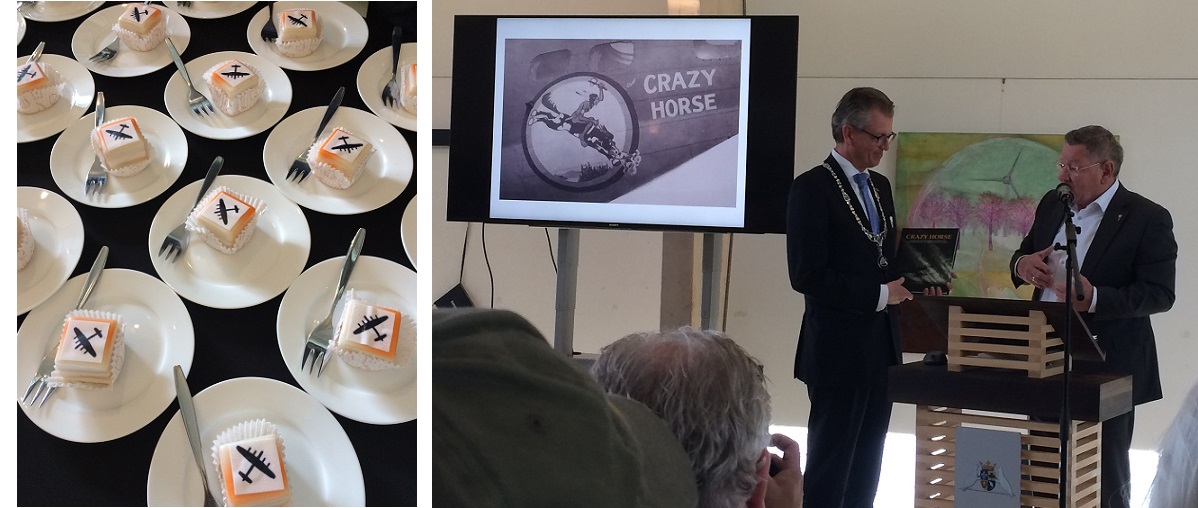
Speech by USAAF Colonel Fisher.
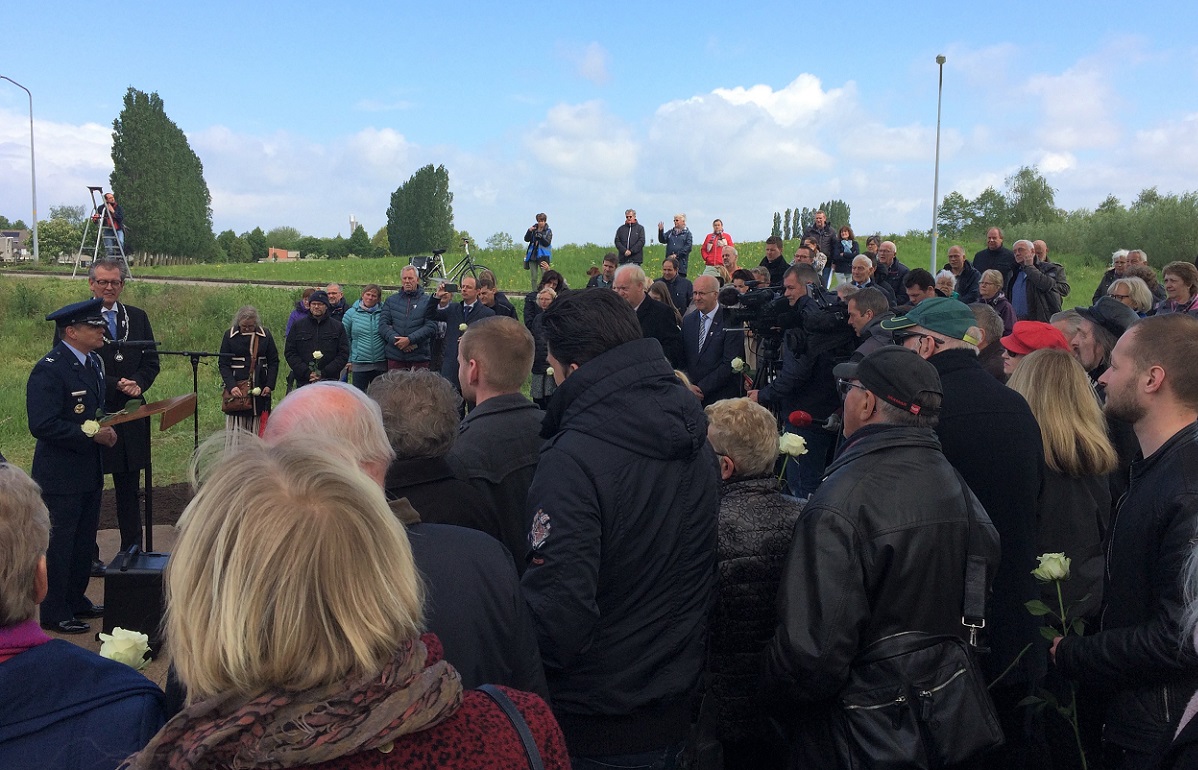
The Monument, Zeewolde May 2019. Aircraft mentioned:
- B-17 GSH (radar pathfinder) 42-30280, 'Crazy Horse', crew 1Lt. Ralph Holcombe, 21 February 1944: https://www.zzairwar.nl/dossiers/164.html
- P-51 Mustang, 44-13411, pilot 1Lt. Leonard Werner, 20 November 1944: https://www.zzairwar.nl/dossiers/166.html
- Short Stirling BF523, RAF 90 Sqn, crew F/Sgt. Wesley Morey (Canada), 12/13 May 1943: https://www.zzairwar.nl/dossiers/110.html
- not on the moument, but received an information pole on the crash site: Me-110, Werke-nr. 5477, Hptm August Geiger (Luftwaffe), 29 September 1943.
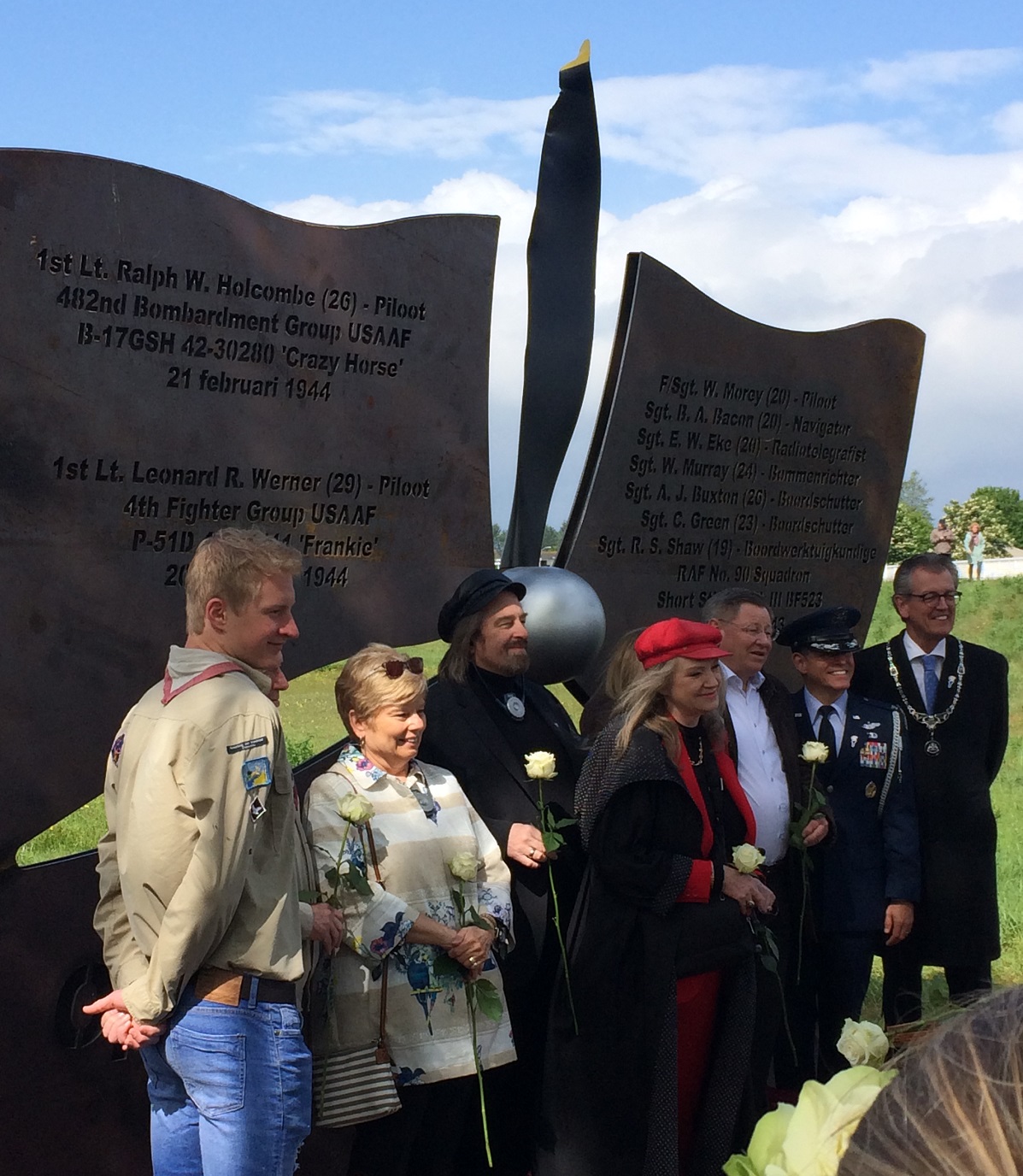
2019, May 1st. Recovery of wreck Mosquito HK529, RAF 29 Sqn, shot down 17 December 1944, pilot F/Lt. Schwartz. Amsterdam.
Since Monday April 29 a recovery is made on a Mosquito wreck, found 1 meter deep in a clay field in the Amsterdam harbour area. Location is a few km west of the Amsterdam city centre, between the Oceaanweg and the Texashaven (docking cay for ships), see image below. The field next to the cay is part of a new building project and items were discovered in the preparations. In February green light was given for the recovery, paid for by companies with commercial interest in the project and carried out with help of hired-in civilian machinery under lead of the Dutch military.
On 17 December 1944 this was farmland, named Grote IJpolder, Frogerweg road. Mosquito HK529 with young pilot F/Lt. Nicolai Roy Schwartz from London and navigator F/Sgt. Robert Walter Donaldson on route for Dortmund were both killed. Shot down by the experienced German nightfighter pilot Hauptmann Fritz Lau (died 2003). Years ago we found the war time Amsterdam cemetery entry document of F/Sgt. Donaldson, buried five days after the crash on 22 December 1944. An entry for pilot Schwartz was not found, but he is buried in Amsterdam (above F/Sgt. Donaldson). Now we know thanks to the newsbulletin of the Dutch Air Force Recovery Team, that pilot Schwartz was recovered in 1948 by the RAF and buried in the top coffin of the grave (no. 82) now with four coffins complete. Remarkable is that after the terrible losses and many British RAF burials in 1940-1943 in Amsterdam, F/Sgt. Donaldson is the only British airman buried here in 1944.

The aircraft is a type NF.XIII. This model has no machineguns. In stead it carries four Hispano 20mm cannons in a bay under the fuselage. One of the cannons has been recovered so far, along with the ammunition for all four guns. Further are found the Merlin engines, propeller blades and other items. Read more, photos and video: Telegraaf and Parool.
2019, April 6. John A. Gartlan, Wellington X9786, Elburg, passed away, age 98.
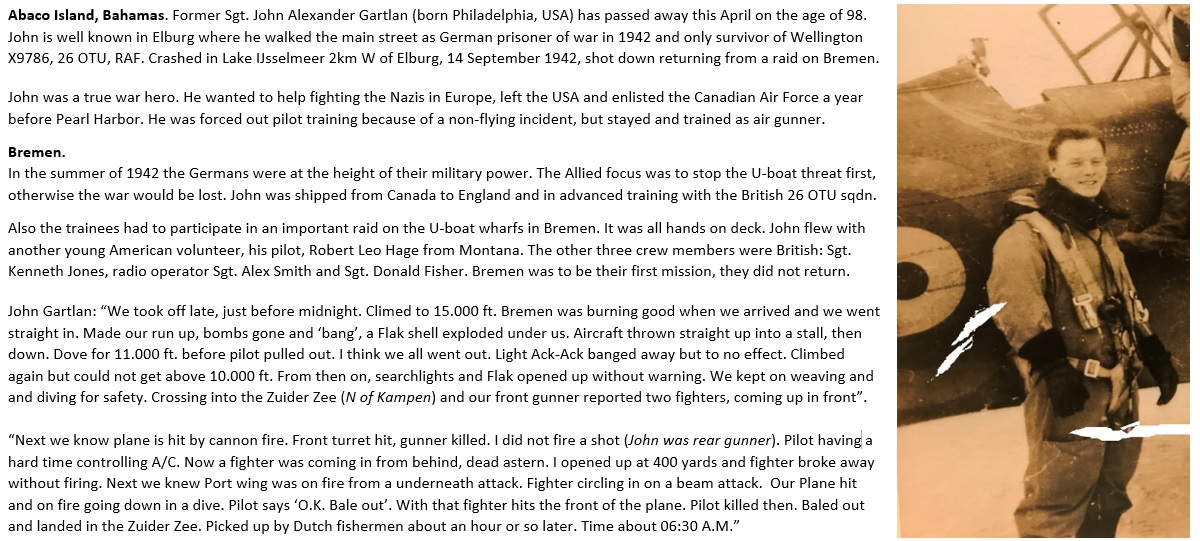
In Elburg the burning bomber was spotted and the EB40 with skipper Westerink sailed out to the location. It was almost daylight and next to the wreck, which was laying on a shallow, was standing a survivor. To everybodies surprise he was not English, but American. They took him and the dead on board. In port, the Germans arrested the man and escorted him to the city jail. People walked with the first Allied soldier they had ever encountered, a symbol of the free world. He was tall and good looking, with red hair and in a white woolen sweater and boots with fur. Enthusiasm rushed through the town. In Elburg no war graves plot was present yet and on the 15th a German boat brought Sgt. Gartlan and four coffins to Amsterdam. John escaped three times from his Stalag, but was recaptured. In January-April 1945 he survived the death marches in the snow from East to West-Germany. Returned to the United States in 1945. Today the crash location is land in northeast Flevoland. At least three bombers crashed in northeast Flevoland did not receive a commemoration-pole due to poor local research, Wellington X9786 is one of them. In memory of the crew of X9786 and what they did for us. John Gartlan Rest In Peace. Article thanks to Jan Halvorson, relative of P/O Robert Leo Hage and friend of John Gartlan.
Dossier on Wellington X9786: https://www.zzairwar.nl/dossiers/34.html
2019, March 3. Harlingen reconstructed.
We completed our file on Harlingen 1945. This small Dutch coastal town had after WW2 a varied and interesting war graves plot, not visible today. A gruesome effect of war hit Harlingen two months after the Dunkirk evacuation, when in weekend of 26/27 July 1940 a group of more than 100 dead soldiers washed ashore on the coast here. Thirty men were buried in Haringen. Among them a German pilot, British RAF and Royal Navy personnel, but most were French sailors and French Army troops from the minesweeper Emile Deschamps, the last ship that left Dunkerque. In the early morning of June 4, it hit a mine only a few miles off the English coast northeast of Ramsgate and sank in seconds.
Nous avons terminé notre fichier sur Harlingen 1945. Cette petite ville côtière néerlandaise avait après WW2, une parcelle de tombes de guerre variés et intéressants, pas visible aujourd'hui. Un effet horrible de la guerre a frappé Harlingen, deux mois après l’évacuation de Dunkerque, en fin de semaine du 26/27 juillet 1940, un groupe de plus de 100 soldats morts échoué sur la côte ici. Trente hommes furent enterrés dans Haringen. Parmi eux, un pilote allemand, le personnel britannique RAF et la Royal Navy, mais la plupart était des marins Français et troupes de l’armée Français du dragueur de mines Emile Deschamps, le dernier navire qui quitte Dunkerque. Tôt le matin du 4 juin, il a touché une mine seulement quelques miles des côtes anglaises au nord-est de Ramsgate et coulé en quelques secondes. Fiche/file Harlingen.

2018, November 28. Recovery Program WW2 Aircraft Wrecks by Dutch Government announced.
The Dutch Government will budget 15 million Euro to speed up the recovery of war planes holding missing crew that are still in soft ground in the Netherlands nearly 75 years after WW2. This was welcome news for everybody involved and families who want their relatives properly buried.
A number of 30 to 50 aircraft is mentioned in the media. Expected is that this figure in 2019 will become much lower once experts have assessed each case for its feasibility for succesful recovery. In most cases there is not much left to find because bomb loads exploded in the air or on impact and previous recoveries. This leaves mostly aircraft wrecks that have been reported in inland water (Lake IJsselmeer) and excavating known field graves that usually have a commemorating monument on it.
The challenge for the Dutch Army and Air Force recovery units will be locating and salvage sections of aircraft with MIA crew that must be near a crash site, but were never discovered. By careful evaluation of each case and carrying out only viable recoveries one at a time, budget can be saved for recoveries in nearby future that no doubt will arise because of upcoming building projects. We expect that 75 aircraft wreck sites will be encountered when all sections of Lake IJssel-/Markermeer (Old Zuyder Sea) will be developed.
Important candidate for recovery: Stirling BK710, 149 Sqn, 25/26 May 1943. Lake IJsselmeer, 6km SE Marken, 1,5 km off harbour Blocq van Kuffeler, Almere (inside boundary Almere).
Or: Stirling BK716, 218 Sqn, 29/30 March 1943, see further below.
End Dec. 2008 (not boating season), a sailing yacht made a daring trip over the Lake. As often in such cases they got in trouble (engine failure). The waves pushed the boat towards the dike between Almere - Lelystad. It was eminent it would be smashed on the stones of the Oostvaarders-dike. Anchor was dropped, did not hold and a SOS was made, Marken lifeboat was sent underway. When the lifeboat had situation under control and tried to raise the yacht's anchor, a large piece of metal came up also. Investigation a day later by the notified ARG 40-45 foundation showed that it was wreckage of a WW2 Stirling bomber. Later a painted 'BK710' on a metal sheet could be read with help of X-Ray. Stirling BK710, pilot Sgt. Jack Uden, was lost on return from bombing Düsseldorf, thought to be lost in the North Sea. Only tail gunner Sgt. Charles J. Percival was found back. He was buried four weeks after the crash (20 june 1943) in Heligoland Island (Helgoland), North Sea- German Bight, northwest of Bremerhaven. This is consistent with the wind and time elapse. His body can have floated north and passed the wide dewatering sluices at Kornwerderzand after which the standard current brings a body further east. Another such similar case is known. On 20 October 1946 Sgt. Percival was reburied in Hamburg Ohlsdorf. The other six crew are missing (MIA). Post scriptum: Dutch newspaper De Telegraaf mentioned in an article 1st May 2019 (page 2) that the wreck could also be another Stirling than BK710 (the BK716).
Based on the small and very damaged debris found, the crash must have been nose-first and very hard. Front of the aircraft disintegrated on impact and drove hard into the muddy bottom. Depth is only 4 meters. It is expected human remains are there as parachute-harnass gear has been found in dive reconnaissance. The Germans can have salvaged larger bomber parts, they were quite active with aircraft recoveries in this area. Image below shows they recover a Stirling nearby second half 1942.

Cross 75.
During and after the war the spot was marked by fishermen. They lost trawl nets there and reported location to the Dutch Government. What was recovered by the Germans is unknown. Recovered by the Dutch after the war was the tail section, but it could not be identified. Location for the tail received no. 75 on the map (see above). It is a bit closer to Düsseldorf as where the cockit section debris was found. Apparently the tail had broken off in the crash, it did not went into the mud. It previously was believed tail gunner Sgt. Percival had time to jump or his body came clear of the tail section.
The X-ray and the elephant. Stirling BK716.
With the first piece of aluminium found in 2008, on which X-ray revealed 'BK710' in fainted white paint, also a wooden mascotte was recovered from the Lake bottom, an elephant, see photo below. Since BK710 was from the 149 'East India' Squadron, an elephant as mascotte made sense. However, the elephant made more sense in the 2019 discovery that the bomber also could be the BK716 of 218 'Gold Coast' squadron. In those days, Gold Coast was the name for the British colony that in 1957 would become the independent state of Ghana. The Gold Coast had an elephant in its national flag. Also state organisations as for example the railroad had the elephant as symbol. The first RAF 'Gold Coast' squadron was RAF 249 squadron. Of course, 249 squadron took the national elephant in its badge. The 2nd 'Gold Coast' squadron was 218 squadron (BK716), they adopted an hour glass with text 'In time', but as mascotte the elephant prevailed. The book Bomber Command Losses 1943 has little information on BK716, only 'lost without trace'. BK716 came in view in 2019 as prospect for cross 75, when the book Nachtjagd Combat Archive 1943 part 1 by Dr. Theo Boite came out. This book mentions on page 52 that the German nightfighter Leutnant Werner Rapp of 7./NJG 1, guided by radar station 'Hase' (Harderwijk, nearby), shot down at 4300m and 2-4 km ESE of Marken Island a never identified Stirling coming from the Berlin raid, as last downed bomber that night at 04:49 hours (30 March 1943). A renewed X-ray examination on the aluminium plate showed the last digit to be more a six than a zero... Families of BK710 are informed by now that BK710 came down in the North Sea NW of Texel Island.
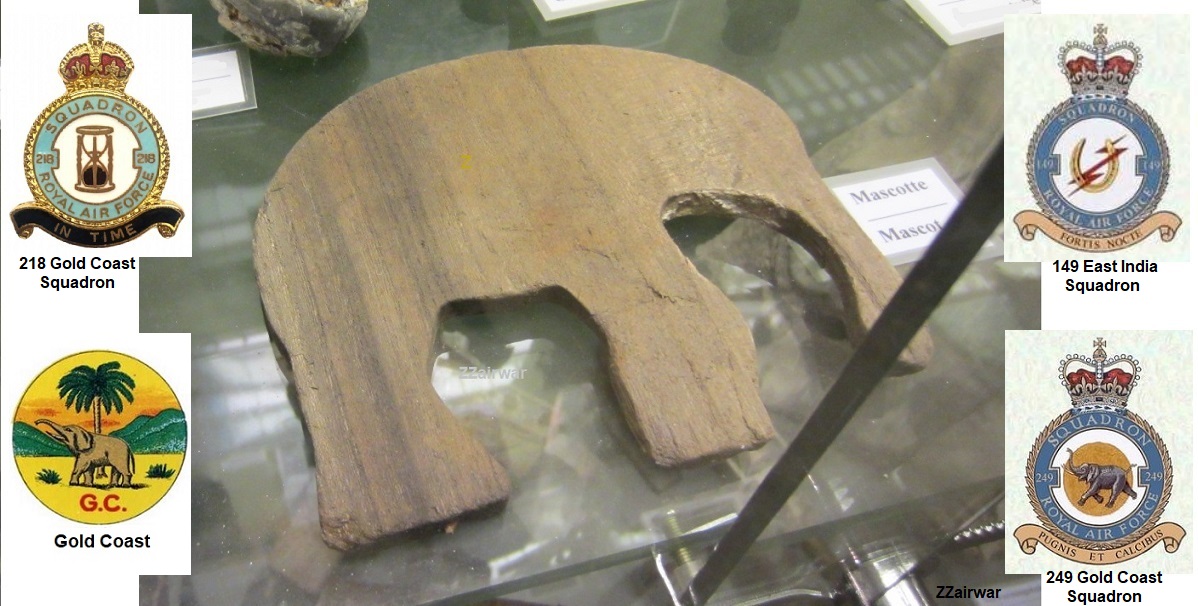
De Nederlandse staat zal 15 miljoen Euro vrijmaken voor versnelde berging van vliegtuigen met vermiste bemanning die zich bijna 75 jaar na het einde van de 2de WO nog steeds in de bodem bevinden. Dit was welkom nieuws voor iedereen die zich hiermee bezighoudt en families die hun geliefden behoorlijk begraven willen zien. Een aantal van 30 tot 50 vliegtuigen werd in de media genoemd. Verwachting is dat dit getal veel lager zal uitvallen wanneer specialisten elk geval hebben beoordeeld en de haalbaarheid van een succesvolle berging zal zijn getoetst. In meeste gevallen zal niet veel te vinden zijn omdat bomlading in de lucht of bij de crash is ontploft, brand en eerdere bergingen. Blijft over voornamelijk vliegtuigwrakken die gerapporteerd zijn in binnenwater (IJsselmeer) en het uitgraven van bekende veldgraven die in meeste gevallen gemarkeerd worden door een monument. De uitdaging voor bergingseenheden van de Nederlandse krijgsmacht zal het lokaliseren en bergen zijn van vliegtuigdelen incl. vermisten die in het verleden niet eerder op de crashsite ontdekt zijn. Door zorgvuldige evaluatie, uitvoering van alleen haalbare bergingen en stapsgewijs werken kan budget beschikbaar blijven voor toekomstige vondsten die zeker zullen komen. Wij verwachten dat 75 vliegtuigwraklokaties aangetroffen worden wanneer alle delen van het IJsselmeer/Markermeer in ontwikkeling gaan. N.b: sinds april 2019 wordt het bergingsproject genoemd: "Nationaal Programma Kansrijke Bergingen".
Dutch provinces where we do not expect recoveries: Flevoland/NOP, Groningen, Zuid-Holland, Zeeland, Drenthe, Utrecht.
List of other interesting wreck locations:
Noord-Holland.
Zuidoostbeemster. Zuiderweg 41 (private land). Marked field grave. Blenheim R3892, 19 August 1940.
Nieuwe Niedorp. Kanaalweg 5/Westerweg (private land). Marked field grave. Wellington T2990 (Czech crew, RAF/Czech 311 Squadron), 23 June 1941.
Limburg.
Echt-Susteren, Abdij Lilbosch. Between Roermond and Sittard, near German border. Stirling W7630, 10/11 September 1942.
Meijel. Between Weert and Venlo. Road N275 Nederweert - Maasbree (N275 x N279). Roggelsedijk 19. Lancaster W4949, 14/15 June 1943.
Overijssel.
Mariënheem, road Raalte to Hellendoorn. Bloemkampseweg no. 4. Lancaster ED584, 12/13 June 1943.
Friesland.
Follega, northeast of Lemmer. Straatweg 31, behind Tramdijk. Lancaster JA853, 16/17 December 1943.
Speers, northeast of Sneek. Speersterdijk x N354. Marked field grave. Halifax W7714, 29/30 June 1942 (6 MIA in soft ground).
Noord-Brabant.
Asten (de Peel), between Eindhoven and Venlo. End of Veluwsedijk, today Kokmeeuwenweg. Halifax NA197 (French crew), 7 February 1945.
Gelderland.
Between Zutphen and Deventer, southwest of Gorssel, Lindeboomweg. Typhoon MN582, pilot F/Sgt. W. Hurrell, 26 September 1944.
Angeren, south of Arnhem. Community Lingerwaard. Close to German border. FW190 (410005), German pilot, possible Oblt. Karl Becker, 30 July 1943.
Another long waiting candidate for recovery: Lancaster ED603, 83 Sqn, 12/13 June 1943, F/Lt. Eric Tilbury, Lake IJsselmeer north, a few km S of Breezandhaven.
Discovered 1996. Image below shows situation today on the white sand seabed. Lancaster lays belly up, nose in sand, fuselage to the back slightly running upwards, tail is broken off. Depth 6 meter. This recovery can be realized cost-effective by sawing off the wings at inside of the inside engines. This leaves the wing fuel tanks intact. The Rolls Royce Packard Merlin 28 engines are already taken off. Loosening the sand under the wreck and hoisting the centre section up. Missing crew members are expected behind the cockpit, the floor with bomb racks is above them. Recovery operation like this is also within the capability of the Dutch Army Engineer Divers.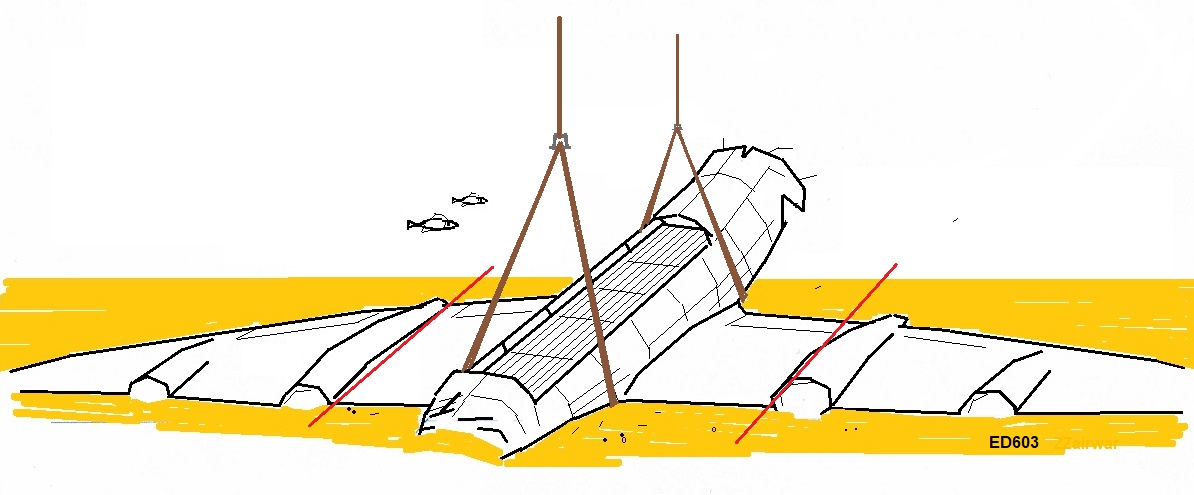
Aircraft was just inside the jurisdiction of village Makkum (Wonseradeel), but it did not set recovery in motion. Today location is inside community-boundry of Sudwest-Fryslând (Sneek).
Crew Lancaster ED603. Highly skilled and at the time specially selected pathfinder crew, all officers. Pilot Flight Lieutenant Eric A. Tilbury (service number 127147) washed up and buried Stavoren 22 June 1943. Navigator P/O Harold E. Howsam (146295) and bomb aimer P/O Arthur G. Fletcher (J/17802, Canada) both buried in Workum 21 and 23 June 1943. Tail gunner F/O Gordon R. Sugar (127055) buried Hindeloopen 22 June 1943. The three officers with the lowest service number (longest in service) and all three holder of the DFM (Distinguished Flying Medal) are missing in action: flight engineer P/O Arthur B. Smart, DFM (51914), wireless operator P/O Raymond E. Moore, DFM (52074) and mid upper gunner P/O Charles F.J. Sprack, DFM, age 24 (51543).
2018, March 15. In memoriam, 1Lt. Hubert R. Cripe.
A few weeks ago, we received a delayed Christmas card of Mr. Hubert Cripe, mentioning that he had been sick and therefore was not able to sent his card on time. Today we received the message that Mr. Cripe passed away February 20 2018 peacefully in his house in Astoria, Illinois, age 97. Our great friend who parachuted into our Lake IJsselmeer (Old Zuyder Sea) in 1944, was a symbol to us of the USAAF daylight raids into Germany 1943-1945. On February 23 2018, also the fisherman involved died in Volendam, NL. In honor of Mr. Hubert Cripe, his crew and the fishermen participated in the rescue 6 March 1944, we have updated the file of B-24 Liberator 42-52226.
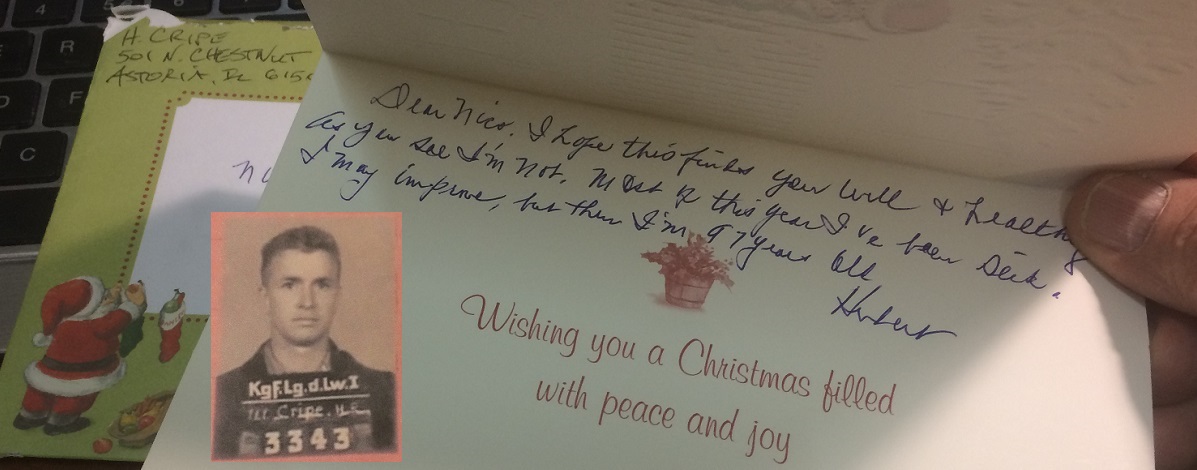
2017, November 25. Background of Sgt. Vincent Sature, buried 1941 Texel Island, finally known.
Years long research in Canada reveal he is Polish WW2 volunteer, born with name Vincent Korzydlowski.
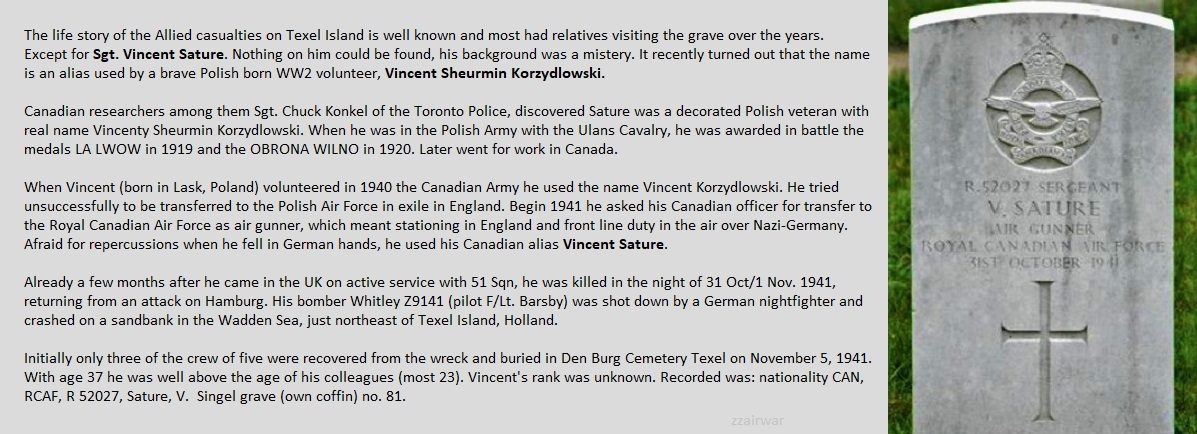
On Friday December 1, 2017 a church service will be held for Vincent in Windsor, Canada.
Church service news, Dec 1st: http://windsorstar.com/news/local-news/forgotten-no-more-vincent-sature-gets-multinational-sendoff-76-years-after-hes-killed
His name is there on the RCAF memorial in the city's waterfront. Church is the Our Lady of Mount Carmel Catholic Church, 4401, Mt. Royal Drive, Windsor. Below is a letter the RCAF sent in 1946 to Vincent's uncle in Detroit (opposite to Windsor). Father and mother in Poland could not be reached. Up to today, no relatives in Poland were found.
Letter of his volunteering for air gunner in the RCAF Page 1. Page 2. Letter of the RCAF to Vincent's uncle in the US.
News paper article: http://windsorstar.com/news/local-news/history-buffs-close-in-on-mystery-surrounding-windsor-airman-killed-in-ww2
2017, November 20. Recovery coordinates found of missing B-17G 42-102565 'The Ugly Duckling', crew Rolfe, 398 Bomb Group, 26 Nov. 1944.
The aircraft appears to be recovered from Lake IJsselmeer 1947 and end 1950's. Then not identified. Story: http://www.zzairwar.nl/dossiers/339.html

2017, September 6. Amsterdam. Burial crew Polish Wellington R1322.
Burial with military honour of two Polish airmen (their remains in one coffin) recovered after 76 year from WW2 wreck Wellington-bomber R1322 in Lake IJsselmeer, Holland. Officer Navigator Maciej Socharski and Radio Operator Sgt. Henryk Sikorski. Plus grave stone-change of the unknown Polish Airman buried 20-05-1941 in grave 69.E.21, who was identified as Sgt. Stanislaw Pisarski also from this aircraft, shot down by a German nightfighter night 8/9 May 1941. Very moving and worthy ceremony, compliments to Polish Embassy, Polish Military, Church and other organizing people and committees. Begrafenis Poolse militairen Amsterdam Nieuwe Ooster. Short impression of ceremony in church: https://www.youtube.com/watch?v=ft-Ie9OREiI
Ceremony coffin leaving Polish church Amsterdam-Osdorp to cemetery: https://www.youtube.com/watch?v=EvN08ejQewc
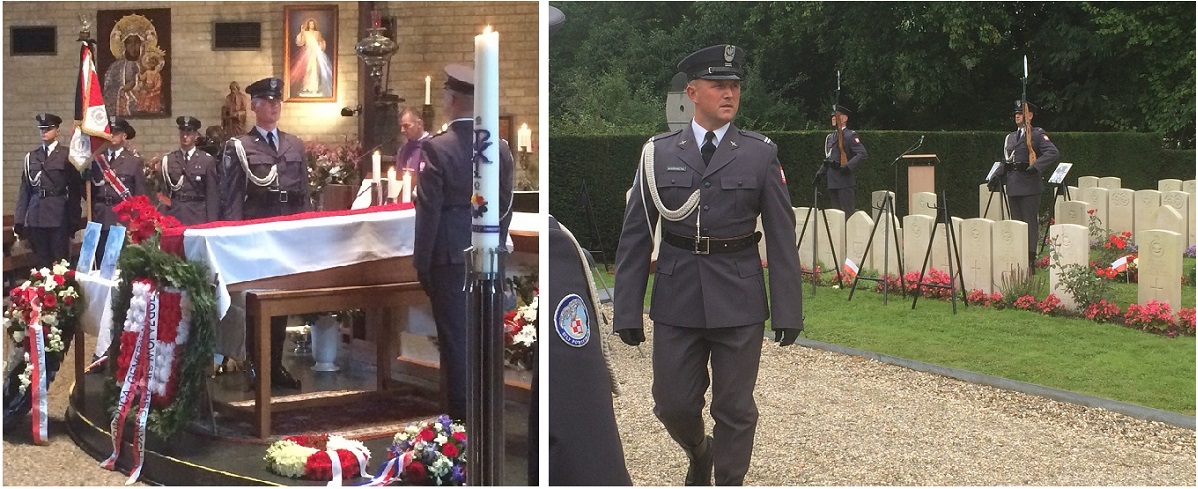
Photo right. Begin of ceremony. Polish airforce and honour guard at attention at the open grave, behind the first row of headstones.
Arrival in cemetery: https://www.youtube.com/watch?v=-Mh21JXmCnY
Below: Polish rifle salute guard 20 men strong. On the right, Dutch Army band. Polish, Dutch and British National anthems were played.

Polish anthem: https://www.youtube.com/watch?v=3N2FVpnQjkg
Dutch anthem (short): https://www.youtube.com/watch?v=KIl6LTsn1JU
British anthem: https://www.youtube.com/watch?v=S-AbBXdWfyI
Speech by Polish authorities, flanked by Polish chaplain and priest of the Polish church in Amsterdam. The six men on the right are personnel of the Amsterdam undertaker and Amsterdam City New Eastern Cemetery personnel including the Consul of Dutch War Graves Commission. Coffin with Polish flag is in position over grave Plot 69, row B, grave 2. At front row is visible headstone of Polish Spitfire pilot Jan Wierchowicz. In the middle is the headstone (with photo and Polish ribbon) of pilot of Wellington R1322, Sgt. Jan Dorman.

Below. Flag is taken from coffin, folded in special way and brought to the highest Polish officer present in the cemetery.
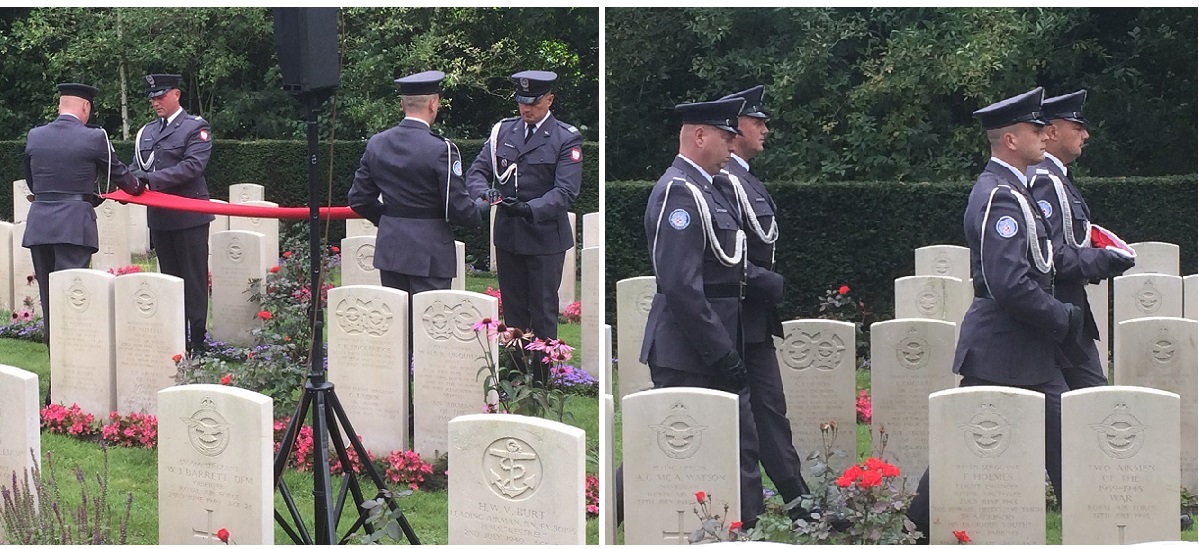
Below. Polish guard begins making ready for firing three salute salvos.
Polish trumpet salute: https://www.youtube.com/watch?v=yDYCNLv3A3E
Polish rifle salute: https://www.youtube.com/watch?v=nfl9ed9zmj4

Dutch Army sergeants involved in recovery of wreck Wellington R1322 and Polish Air Force staff.
Folded flag is brought one step closer to the Polish General. Flypast by two WW2 Harvard aircraft: https://www.youtube.com/watch?v=esZikp4a3RU
2nd pass (short) better sound: https://www.youtube.com/watch?v=jMhKwxOVXZU
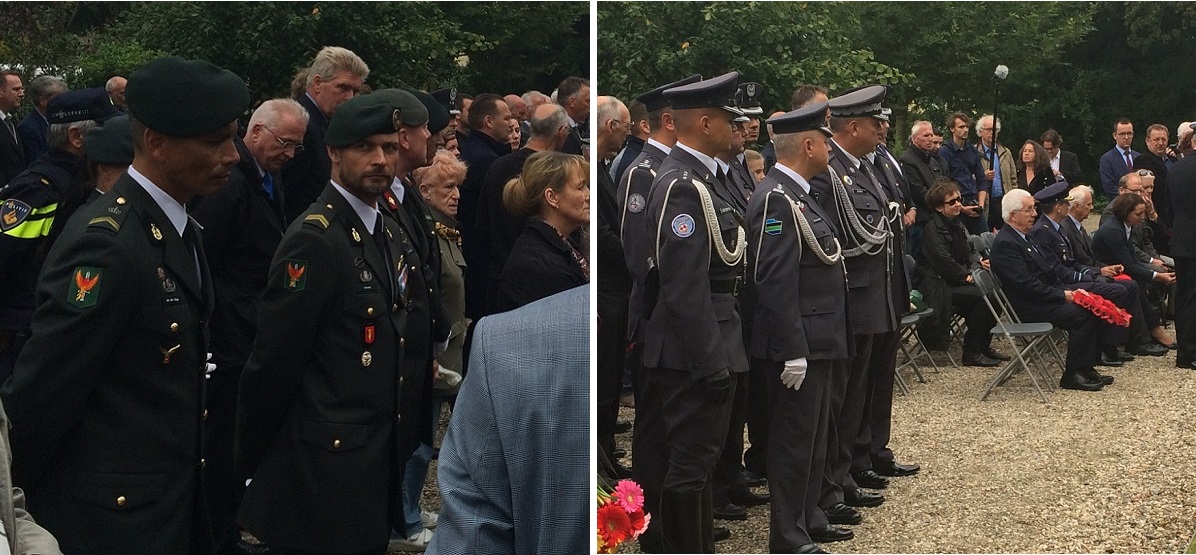
Polish Air Force staff laying their wreath, a captain, colonels and general. https://www.youtube.com/watch?v=AqFRuzv95y4
Chosen is interment in grave 69.B.2. Here was room to place a headstone in between the 2nd stone (Sgt. Everest) and the 4th stone from left (F/O William Peers). The grave involved is the old grave no. 80 in which in 1944 four American airmen were buried, exhumed 1945. Post war RAF Sgt. Albert Everest was reburied in the empty American grave. He came from the cleared plot 72, killed 13 November 1940. He still rests in this grave, bottom coffin. His stone is the 2nd headstone. The coffin with F/O Maciej Socharski and Sgt. Sikorski is added onto the coffin of Sgt. Everest. Most graves on this row have two to four coffins in each grave.

.
Below. Moving moment. The Polish General handed over the folded Polish flag that was over the coffin, to the son (age 78) of F/O Socharski. He was 2 years old when his father was shot down in Wellington R1322. His mother was member of Polish resistance and was in 1943 arrested and moved to Auschwitz-Birkenau. Mr. Malcolm Mason MBE of the RAF Association, Dutch Air Force General in blue uniform and British Consulate Mr. Johnson in background are all respectfully silent.

Photo right. Major Arie Kappert laid flowers and stands at the attention in civilian clothes. He led the recovery of Wellington R1322 just before his retirement from the Dutch Air Force.
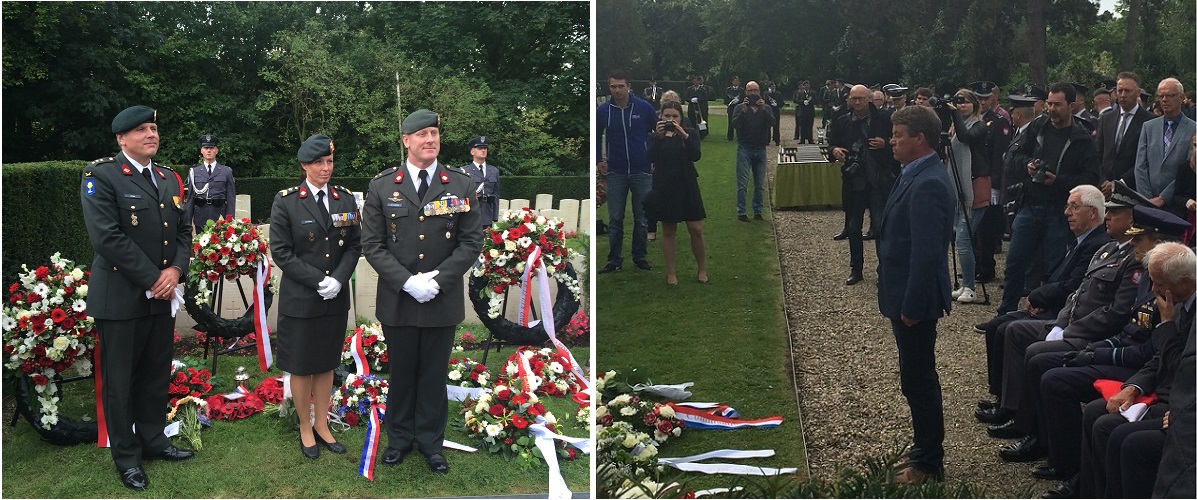
Left the experienced men and woman of the Dutch Army Recovery and (human remains) Identification Unit. They did an excellent job in the recovery of Wellington R1322.
Maybe got to little official attention during the funeral ceremony: in the process of identifying the remains of F/O Socharski and Sgt. Sikorski, it could be established that the unknown Polish airman in the begin of plot 69 (nearest to the Cross of Sacrifice) was the missing Sgt. Stanislaw Pisarski, the front turret gunner of Wellington R1322. His grave stone was changed in a new one with his name. Not MIA (Missing In Action) anymore after 76 years... This to joy of his direct relative, Mr. Jakub Bialowas.

==============================
2017, June 26. Amsterdam. Robert Leo Hage.
In an intimate and beautiful event, RAF Pilot Officer Robert Leo Hage was honoured in a joint American-British ceremony. Robert 'Bob' Hage was an American Volunteer from Montana who entered the British Airforce before Pearl Harbor. After he was shot down and killed over Lake IJsselmeer in Wellington bomber X9786 night 13/14 Sept. 1942, he lay buried non-identified in Amsterdam for 6 years. He was only child. His parents could not speak about his death and could not visit his grave when he was finally identified in 1949. On the gravestone was a mistake. Recently it transpired that three medals still lay in London, waiting. In the ceremony last Monday, the new headstone was rededicated. The British medals were given to the family and will be donated to the Fillmore County Historical Society in southeastern Minnesota, where Robert Leo's parents and other family were born and are buried. At the graves of the other five American volunteer pilots in Amsterdam also flowers were present, laid there on US Memorial Day.
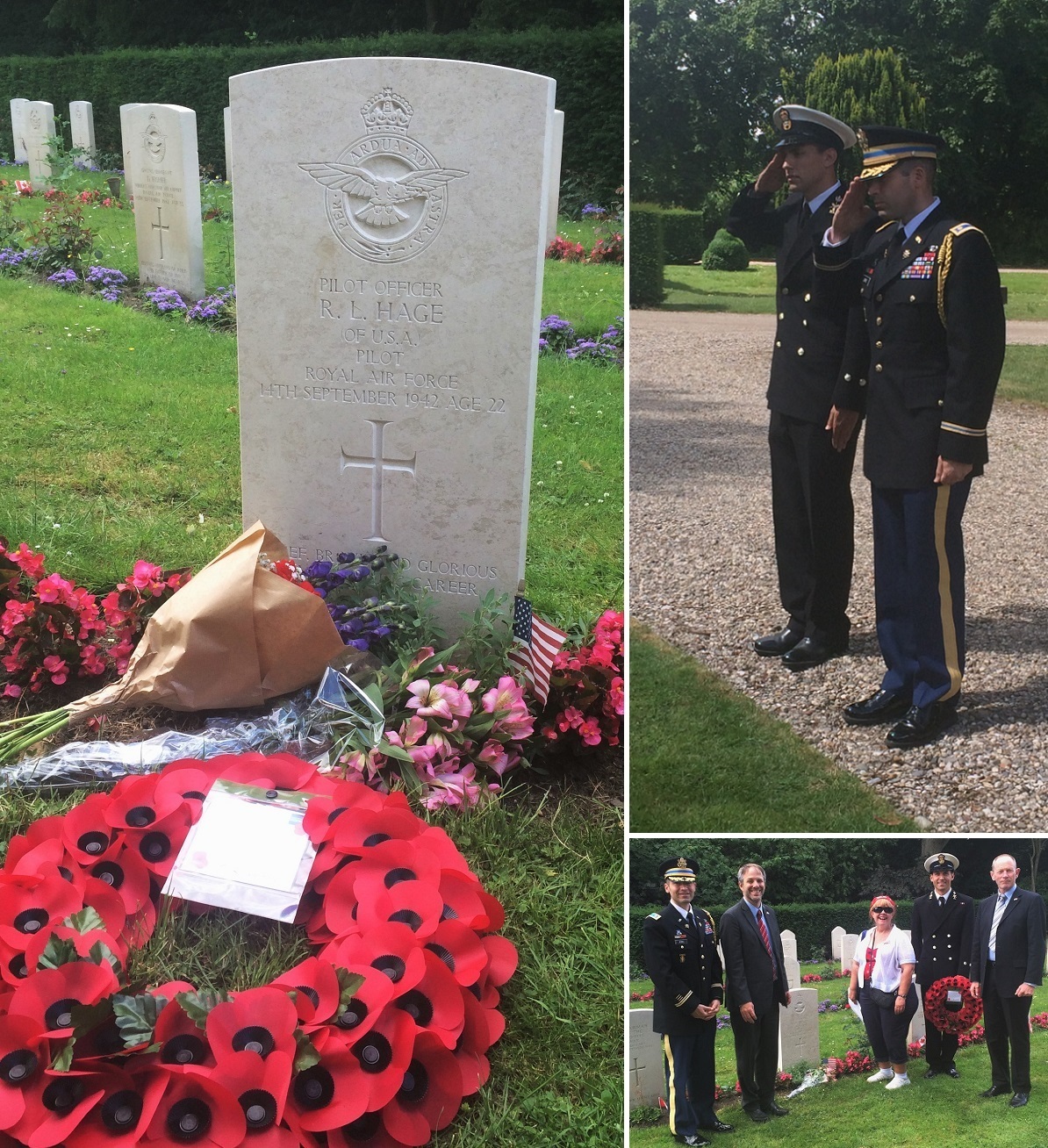
2017, June 25. Pratt & Whitney R-1380 Twin Wasps back over the Lake.
For us a flight with a 1941-build Consolidated Catalina PBY seaplane, was a tribute to the Consolidated B-24 Liberator and Vickers Wellington Mk. IV (Polish and Australian squadrons) that passed over our Lake day (B-24) and night (Wellington) in the period 1941-1945. Both having the same engines as the Catalina: the 14-cylinder (double row) radial Pratt & Whitney R-1380 Twin Wasp. Beautifull sound and experience. We crossed the Lake east to west, as coming back from a mission over Germany 1943.
Short impression (25 seconds): https://www.youtube.com/watch?v=S-7dJ_g0nq0 <- increase sound level!

This Catalina PBY was build 1941 and patrolled the North-Atlantic waters. It was based on Iceland and its American crew sunk three German U-boats with bombs. The Dutch Navy also flew with Catalinas before and in WW2. In 1996, a Dutch Historical Society managed to buy this aircraft. It was named 'Karel Doorman' after the Dutch naval war hero and fully restored.
Heating-up the engines before take-off: https://www.youtube.com/watch?v=cN40zlYtui4&t=23s
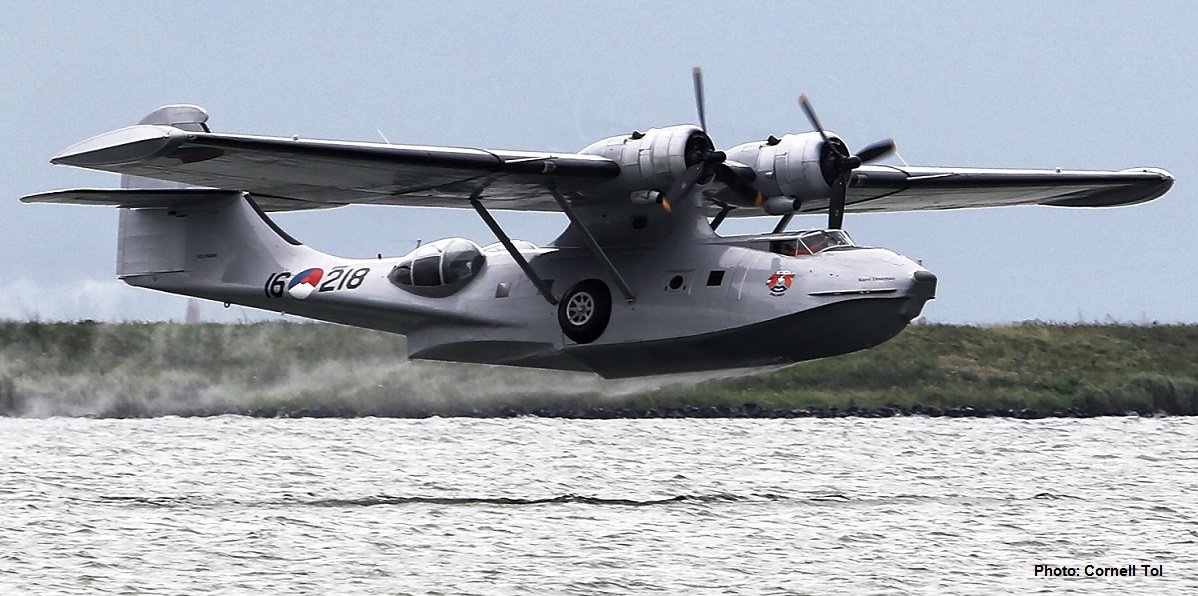
2017, June 21. Wallace Emmert died at 101.
Pilot of the in our region well-known B-17G 42-37751 Lt. Wallace E. Emmert died in his hometown age 101. War hero, may he rest in peace.
Read more: http://www.maderatribune.com/single-post/2017/06/21/Wallace-Emmert-dead-at-101
Our article on his B-17 emergency landing at Urk October 8, 1943: http://www.zzairwar.nl/dossiers/146.html
2017, May 2-7. Remains found in Polish Wellington R1322 (08/09 May 1941) identified.
Dutch military recoverers believe that bone fragments found are of the two men in the compartment behind the pilot; the missing wireless (radio) operator corporal Henryk Sikorski and navigator Flying Officer Maciej Socharski. The leg (bone) of a third man was found, which belongs to the unknown Polish airman in grave 69/E/21 in Amsterdam which identify him by deduction as front gunner Stanislaw Pisarski. This was communicated to the Polish Embassy in The Hague. Advised is replacement of the stone in Amsterdam for Pisarski and burial of Sikorski and Socharski.
In 2012 we discovered that together with pilot Jan Dorman and co-pilot Zdzislaw Gwozdz, a third unknown airman (also from the water) was buried next to them in grave 72/34. This was on 20 May 1941, Amsterdam. The unknown was post war (1946) exhumed, examined and moved to grave 69/E/21. There he received a Polish headstone with engraved 'Polish airman, 20 May 1941, known unto God' (photo stone). However, it was clear to us he had a connection with Dorman and Wellington R1322 and had to be one of the three missing crewmembers. When wreck parts of Wellington R1322 were discovered in the Lake in 2014, our knowledge on grave 72/34-69/E/21 became relevant and we put it on this website and send emails out. On the first day of the recovery by the Dutch airforce on 19 August 2016, parts (bones) of a right leg were found front of the wreck. The English exhumation report of 11 October 1946 for grave 72/34-69/E/21 was consulted recently. The report stated in the grave was a Polish airman, Air Gunner, Sgt. stripes on shoulder, no 'Sparks' wireless badge on right arm, without right leg... Deduction then lead to the front gunner of Wellington R1322, Sgt. Stanislaw Pisarksi, since tail gunner Ludwik Karcz is buried in Amersfoort (Leusden-Zuid) and Sgt. Henryk Sikorski was in the radio room.

Pisarki and Sikorski were both trained Air Gunner/Wireless (radio) Operators. Dutch Army & recovery archeologists believe Sgt. Henryk F. Sikorski was the acting wireless (radio) operator, probably with Sparks badge. On Sikorski's very early in war personal name card (Polish Embassy in England in WW2) now in Hayes (files MOD) is mentioned at Remarks "RADIO & TELEG. MECH." (or "MSCH."). Sgt. Stanislaw Pisarski is presumed front gunner and had probably no Sparks badge on his uniform and was therefore front gunner, the man who was buried with pilot & co-pilot. It makes sense that the three men in front of the aircraft were thrown clear when the cockpit smashed, and the two men in the radio- and navigation section were closed in (Sikorski and Socharski).
08/09 May 2017: The Tadeusz and Anna Krzystek list (listakrzystka.pl), a recent project and website with the names of the 17.000 Polish that served in the Polish Air Force in England, confirms Stanislaw Pisarski, 781063, Sgt/Plutonowy had as specialty: Wireless Operator and Air Gunner. Henryk Franciszek Sikorski, 780349, Sgt/Plutonowy had that also, but that Henryk Sikorski was the actual Radio Operator in the crew. That confirms that unknown Polish front air gunner found in grave 69/E/21 in Amsterdam is Stanislaw Pisarski. Thank you Piotr.

.
Above Photo.
The sergeants in R1322 were classmates in 18 OTU (Photo Mr. Bialowas). Above 2nd right: Henryk Sikorski. Middle 2nd left: Stanislaw Pisarski. Below 1st left: Ludwik Karcz (thanks PATS).
Burial.
Replacement in Amsterdam of the Polish headstone on grave 69/E/21 for a headstone with name Pisarksi and burial of Sikorski and Socharski is not expected soon and can be some months away. Amsterdam is normally not an open cemetery for burial of airmen found, last burial there was 24 May 1945. However, there is a few meter free space right next to grave 69/E/21, towards the cross of sacrifice, which is ideal. The last burial of Polish airmen recovered from the Lake (five crew of Boguslaw Morski, Lancaster DV286, 12/13 June 1944, from Lake IJsselmeer at Wijdenes) was in 2003 in Breda Catholic Church followed by interment in the Breda Polish Field of Honour (Ettensebaan street). This is the cemetery where General Maczek rests.
2016, Dec 18. In memoriam S/Sgt. John "Jack" R. Lantz.
In Tulsa Oklahoma Jack Lantz died, age 92. Well known in our region. Only survivor of the 10 men that parachuted in Lake IJsselmeer 11 Jan. 1944. In memory of him and his crew we extended our file on B-17G 42-37719 "Hellcat", 381 BG. http://www.zzairwar.nl/dossiers/152.html

2016, Sept. 13. Fly-over the Wellington recovery location by the BBMF Lancaster planned Monday 19 September.
Sunday 18 September Operation Market-Garden is commemorated. The BBMF (RAF's Battle of Britain Memorial Flight) Lancaster PA474 'KC-A' is in Eindhoven and over Arnhem-Oosterbeek. Monday 19 September the cofferdam in Lake IJsselmeer is visited as a salute to the crew of Wellington R1322. Estimated time of arrival (ETA) at nearby Oudemirdum village is 15:30h. We hope that PA474 can fly over the Frisian coastline here and salute the RAF airmen recovered from this lake shore and are buried in Lemmer, Nijemirdum, Bakhuizen, Scharl, Stavoren, Molkwerum, Koudum, Hindeloopen, Workum and Makkum.
Lancaster at Oudemirdum (cofferdam is off shore, near boats). 1 minute, recommended, increase sound level!): https://www.youtube.com/watch?v=Rm5K_9J1fW0 Thanks Kreidler & BBMF.
2016, Sept. 7th. 15:00h. Identity Wellington R1322 confirmed.
Dutch air force announced this afternoon that a part with the aircrafts serial number R1322 was found. Also a headphone with name of one of the crew was recovered. This confirms it is Wellington R1322, Pilot Jan Dorman, RAF/PAF (Polish Air Force) 305 Squadron. Human remains have been found (bone fragments only) and brought over to the Dutch Army ID centre. It can take several weeks/months before anything about this is conclusive and if family members of the MIA can be informed. The bombs will be blown up on land in a location in eastern Netherlands. The cofferdam will be removed within 2 weeks. The fact that only bone fragments were found, supports our research (see link below) that only one or two of the crew can be inside the wreck, or as expected, all six crew washed ashore/were recovered in 1941. The bone fragments can be for example of a hand or other body part. Sources in 1941 reported the aircraft burned in the air after the attacks of the German nightfighter and fell from great height hard on the water.
Alleen botfragmenten gevonden in Wellington R1322. Dit steunt ons eerder onderzoek dat nog 1 of 2 man in wrak aanwezig kan zijn, maar meer waarschijnlijker is (zie link onder) dat ze alle zes zijn aangespoeld/geborgen in 1941. De botfragmenten kunnen afkomstig zijn van b.v. een achtergebleven hand of ander lichaamsdeel. Bronnen uit 1941 meldden dat dit vliegtuig door beschieting van de Duitse nachtjager brandde en van grote hoogte in stukken op het water stortte.
Our file on R1322 and its crew: http://www.zzairwar.nl/dossiers/56.html
2016, August 31. Recovery Wellington bomber IJsselmeer. Results, first (armed) bombs found.
Also found were .303 cal. Browning machineguns and a Smith & Wesson revolver in good condition. No human remains found so far. The wreck is not identified yet, but the revolver is a good indication it can be Wellington R1322 with Polish crew. RAF flying personnel were forbidden to carry side arms, but the Poles took no chances with the Germans in case they came down in enemy territory. It is said that a Lancaster bomber will do a fly-over over the location as a tribute to the KIA crew.
Dutch news video and photo August 31: http://nos.nl/artikel/2129184-geladen-machinegeweren-na-ruim-70-jaar-uit-ijsselmeer.html
Below photo shows the four 500 lbs bombs (227kg) waiting for disarmament and a Dutch 'BIDKL' soldier (identification unit) in the cofferdam-pit, struggling with old fishing nets that are wrapped over the wreck. The bomb tail stabilization fins were made of thin metal and have rusted away completely.

More photos: http://www.nrc.nl/nieuws/2016/09/01/berging-van-een-bommenwerper-a1518927
More photos: http://www.joustercourant.nl/nieuws/50290/bergingswerk-vickers-wellington-weer-op-schema/
The above photos in the link show also British soldiers working in the pit. The cylinder heads are clearly belonging to a Bristol Pegasus engine, confirming the underwater reconnaissance that involved is a Wellington Mk IC.
2016, August 27. Recovery Wellington in progress.
Lemmer. In last weeks water was pumped out of the cofferdam (almost 4 million liter). Monday 29 August the careful excavation will commence. According to the officer in charge of the salvage operation, Dutch Airforce Major A.L. (Arie) Kappert, the Wellington wreck consists out of smashed apart pieces, mostly covered with sand. If human remains will be found, they will be transferred to the Dutch Army Identification Centre 'BIDKL' in Soesterberg (Bergings- & Identification Dienst Koninklijke Landmacht). The location on sea is guarded by the local scouting club as a training. They are stationed next to the cofferdam onboard an old minesweeper, the W806. See for photos and video underneath link to website of Dutch TV. In their article is mentioned that there are still 63 aircraft wrecks in Lake IJsselmeer.
Photos and video of recovery in progress 26 August: http://nos.nl/artikel/2128109-stukje-ijsselmeer-drooggelegd-om-wo-ii-vliegtuig-te-bergen.html
2016, June 17. Recovery announced of Wellington bomber (R1322?) in Lake IJsselmeer, starting 22 August 2016.
Lemmer. The Dutch Airforce and Community Friese Meren (Gaasterland-Lemmer-Joure) announced to start 08/2016 to clear the wreck location of a WW2 RAF Wellington bomber. A steel sheet pile cofferdam (25 x 36 meter) will be erected around the wrecksite after which the water will be pumped out, see recovery plan. Water depth is 4 meters. It is the 2nd time a cofferdam is build around a wreck to recover it. First was B-24 42-7638 Oostvaardersplassen 1975. The work will take 4 weeks and will cost 1 million Euro (30% for the Community, 70% Dutch State). Most budget is for civilian contracter Leemans who is hired-in for the job, in close cooperation with specialists of the Netherlands Armed Forces. Expected to be found are at least two bombs and possible human remains.
In this part of the Lake the seafloor is sand and of good quality for construction. In 2014 a Dutch mining-company gained a contract to excavate this sand in an area of 2,5 x 2,5 km x 30-80 meters deep. During a survey of the seabed the wreck items were discovered & reported. Location is situated 5,5 km south of the dyke at village Rijs ('R' on below map) and 15km SW of Lemmer. In 1961 a complete German Ju-88 was recovered here also.
Which Wellington is involved is not certain yet, but it is an early type Mark IC (with Bristol Pegasus engines). It could be R1440, crew Pilot Officer Thomas Fairhurst (09/10 April 1941 'off Stavoren') with five MIA. Or N2844 Sgt. Kenneth C. Shearing (18/19 August 1941, with MIA). Most likely candidate however is Wellington Mk IC R1322 of 305 Squadron (Polish) fuselage code SM-F, pilot Flight Sgt. (Sierz. pil.) Jan Piotr Dorman. Three, possible five crew of Dorman's R1322 were recovered here from the water in July 1941 and buried in Urk (Karcz) and Amsterdam. A 6th man is unaccounted for (MIA). R1322 took off night 8/9 May 1941 from RAF Syerston airfield near Nottingham and was on route to Bremen. German nightfighter pilot Oberfeldwebel Hans Rasper (4./Nachtjagergeschwader 1) reported to have shot down that night a Wellington bomber 12km southwest of Lemmer ('L'), which is near current recovery location.
If it is Dorman's Wellington R1322, than involved is a quite well-known aircraft in our region, because crewmember Corporal Ludwik Karcz washed ashore on the nearby Northeast Polder dyke (at 'K'). He was buried with full honour by the Urk community as 2nd Allied airman there on 2 July 1941. He was one of the two airmen under 'the Monument', his name engraved right-under at the base. After the Germans had Dorman's body, they (mis)used his identity to spy on other RAF airmen that were wounded (POW) and hospitalized in Amsterdam Luftwaffe Hospital.
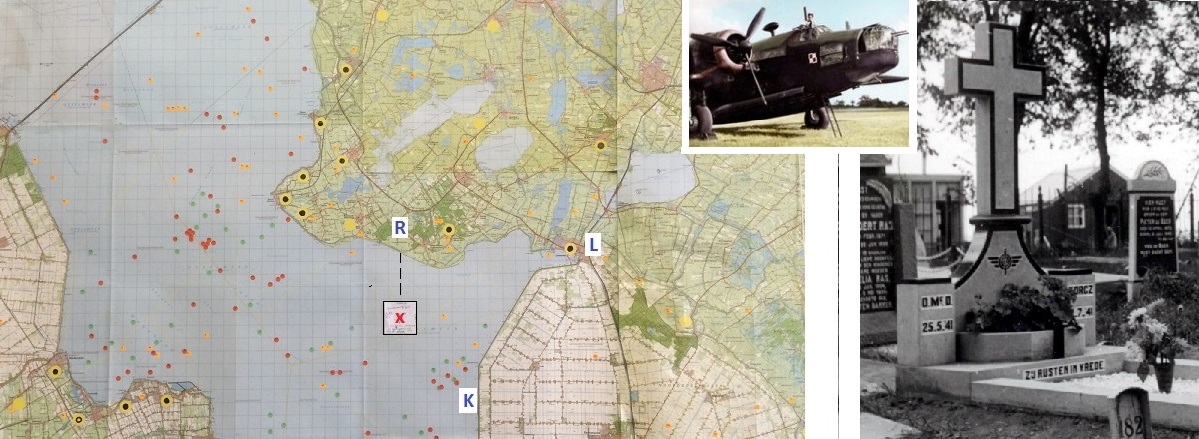
Links on the above, read more: Recovery plan Wellington August 2016. First dam around aircraft: B-24 42-7638 Oostvaaardersplassen 1975.
File Urk war graves 1940-1945. Our file on the Amsterdam war burials 1941 July-Dec (Dorman and crew R1322).
Other news articles June 17 2016: Jouster Courant and Community Friese Meren.
Dutch translation:
Lemmer 17 juni 2016. De Bergingsdienst van de NL Luchtmacht o.l.v. Staf Officier Vliegtuig Berging Majoor A. Kappert en de Gemeente Friese Meren (Gaasterland-Lemmer-Joure) maakten bekend in augustus 2016 te starten met het ruimen van een vliegtuigwraklocatie uit de 2de Wereldoorlog, het betreft resten van een RAF Wellington bommenwerper. Een stalen damwand (25 x 36 meter) wordt geslagen rondom de wrakstuken waarna het water wordt weggepompt. ZZairwar: de waterdiepte is 4 meter. Het is de tweede keer dat een damwand wordt gebruikt om een vliegtuig te bergen. De eerste keer was in 1975 bij de berging van de B-24 in de Oostvaardersplassen. Het werk begint 22 augustus en zal vier weken duren. Kosten bedragen 1 miljoen Euro. 30% voor de gemeente en 70% het Rijk. Het grootste deel van het budget gaat naar aannemer Leemans die hiervoor is ingehuurd, in samenwerking en onder toezicht van specialisten van Defensie. Verwacht wordt twee of meer bommen te vinden en mogelijk menselijke resten.
De IJsselmeerbodem bestaat hier uit zand dat erg geschikt is voor met name wegenbouw. In 2014 verkreeg een bedrijf vergunning om dit zand te winnen in een gebied van 2,5 x 2,5 km tot een diepte van 30 tot 80 meter. In het vooronderzoek (bodemscan) werden de vliegtuigwrakdelen aangetroffen en gerapporteerd. De wrakdelen liggen op 5,5 km zuidelijk van de Friese kust onder Rijs (Riis) en 15km ZW van Lemmer. In 1961 werd hier al een complete Duitse JU-88 geborgen.
Om welke Wellington het gaat is nog niet bekend, maar het is een vroeg model IC met Bristol Pegasus motoren. Het zou de R1440 kunnen zijn, crew Pilot Officer Thomas Fairhurst (neer 09/10 April 1941 niet ver van Stavoren) met nog vijf vermisten. Maar het meest waarschijnlijk is Wellington type IC, serienummer R1322, romp- en radio code SM-F van het 305 squadron, een Pools sqn. binnen de RAF. Pilot was Sgt. Jan Piotr Dorman. Drie en mogelijk vijf bemanningsleden van dit vliegtuig werden later uit deze omgeving uit het water gehaald en begraven op Urk (Karcz) en in Amsterdam. Eén man is nooit gevonden en vermist. De R1322 vertrok in de nacht van 08/09 Mei 1941 van het RAF vliegveld Syerston bij Nottingham voor een missie op Bremen. De Duitse nachtjagerpiloot Oberfeldwebel Hans Rasper (4./Nachtjagergeschwader 1) meldde die nacht een Wellington te hebben neergeschoten 12km ten zuidwesten van Lemmer, in de buurt van de huidige wraklocatie.
Als het inderdaad om Dorman's R1322 gaat, dan betreft dit een bekend vliegtuig in de IJsselmeer-regio. Bemanningslid korporaal Ludwik Karcz spoelde aan op de Noordoostpolderdijk ten noorden van Urk. Hij werd op 2 Juli 1941 begraven op Urk waarbij het hele dorp uitliep om de laatste eer te bewijzen. Hij en de RAF airman voor hem werden begraven in één graf (boven elkaar) en kregen een paar maanden daarna een waardig, voor Urker begrippen uitzonderlijk grafmonument (katholiek uitziend, Karcz was katholiek). De naam KORCZ (later gewijzigd in KARCZ) staat rechtsonder op de steen. Nadat de Duitsers Dorman's lichaam in handen hadden, werd z'n identiteit gebruikt om te spioneren op gevangengenomen gewonde Engelse vliegers in het Amsterdamse Wilhelmina Gasthuis.
2016, May 01. The Dutch National Broadcast Organization NOS reported on its news channels that still 1085 Allied airmen can be expected in aircraft wrecks in the Netherlands, in the ground or (most) under water. After the war these locations were not cleared. In total there are 501 such locations.
Dutch communities as Almere, Makkum, Sudwest-Friesland and Echt-Susteren did turn down family-requests for recovery because of the financial coasts (500-800 K), no urgency or the fact that these locations have a monument on them and are considered as honorable field grave. Furthermore it is (ZZAW: correctly) argumented by them that it is not certain that remains are inside because crew can have jumped over water and can be lost on sea or washed ashore and buried somewhere as unknown Allied airman. Also many aircraft exploded with such force (bomb load) that human remains are not found back.
In total 5000 aircraft came down in the Netherlands during WW2. American and Australian governmental organizations are trying actively to trace missing countrymen from that period. The British government supports the policy of considering the wrecks as field graves and leaving them in peace. However, many landowners did a survey on a wreck and wrecks were often excavated by historical societies. Today recoveries are always led by the Dutch Airforce Recovery Officer. Since 1960, nearly 200 aircraft wrecks were recovered from ground/water by the Dutch Airforce.
The NOS added a disclaimer that its figures are based on data of others and aircraft could be included that already were salvaged by the German Army in 1940-1945 and period 1945-1960. Aircraft that came down in the North Sea were not included in the survey. More than half of the missing aircraft surveyed are in not accurately known positions in water: Wadden Sea, Lake IJsselmeer (Old Zuyder Sea) and Wester-Scheldt estuary. The 1085 airmen are 247 Germans, 228 Americans and some 600 flyers in service of the RAF.
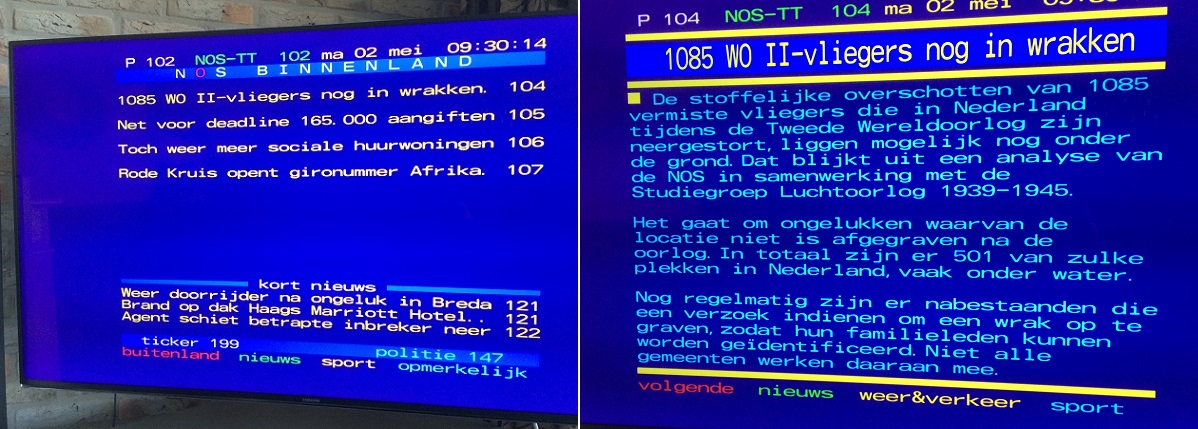
2016, Apr. 22. Former Dutch Airforce recovery officer Gerrit J. Zwanenburg passed away Friday 22 April after a short stay in hospital, age 88. He took part in more than 100 aircraft wreck recoveries in the period 1962 - 1987. He professionalized aircraft identification in the Netherlands and build-up an excellent network with other airforces, veterans, research organizations and relatives of Allied airmen. For his work he was knighted into the Dutch Royal Order of Orange Nassau and was awarded the title MBE (Member of the British Empire).

Gerrit Zwanenburg (1928) interest for Allied warplanes started in WW2, when as a boy he witnessed the airwar passing over his hometown Harlingen. He volunteered the Dutch Royal Marines in Indonesia in 1947-1948. In 1950 he worked as radio traffic annalist in the Military Intelligence Service (MID) in Amsterdam (Kattenburg). In 1962 he visited there the site of recovery of Lancaster R5512, crashed and drove deep in the ground night 20 December 1942 (pilot W.N. Eades). This was in the Volewijkers Park in Amsterdam-north. He had with him his private files on this aircraft, which were very welcome at that time. The Dutch Airforce Recovery Unit kept in contact with him. In 1967 Mr. Zwanenburg transferred from the MID to the Dutch Airforce and became member of the Recovery team. In 1970 he was appointed project-leader (Recovery Officer). After retirement in 1987, he researched the airwar over the Netherlands further and wrote several publications on this subject.
2016, Apr. 11. Website updated to new Joomla version. Test phase completed, site online. Some older pages can show excessive white spaces, this will be adjusted.
2015, Sept. Adobe Flash map on Homepage is not longer supported and viewable on Android phones and tablets, as Apple iPhone or iPad and browser Mozilla Firefox. The map will be replaced by a HTML-version in 2016, which will make it function again. Until then, this website is best viewed, incl. the map on homepage, on a desktop or laptop PC, with browser Google Chrome or Internet Explorer, minimum 13" (12,9") wide screen 16:9 ratio, 1920 x 1080 pixels. Also suitable for 10" and 12"-up tablets. Change over to HTML map on Homepage completed October 5th, 2016.
2015, Oct. 200 files of aircraft crashed in Lake IJsselmeer-area 1940-1945 updated and uploaded on this website. The next batch of 200 aircraft files will be uploaded summer 2016.
2015, August 15.
While fishing on the central North Sea, this 4000 lbs HC (High Capacity) "Cookie" bomb was fished up. It lay in the middle of the line North Yorkshire - Hamburg. Probably an aircraft had to return to base and dumped its dangerous cargo into the North Sea before landing on the home base, an unknown airfield between Newcastle upon Tyne and York. For a thin wall ordnance, this very heavy bomb with 1814 kg high explosive was in excellent condition after laying in salt seawater for 72 years. The bomb has been lowered again to the sea floor and will be/or is demolished by now. Source article: Visserijnieuws 15 August 2015.

2015, Aug. 150 cemetery files uploaded on the website. Research conducted on all (150) cemetery with war graves that could have yes or no a relation with airwar over Lake IJsselmeer. All non-identified airmen buried around the Lake as 'Known to God' were registered and entered in the database in SEARCH MENU at Buried as unknown.
2015, Feb. Website online in test phase with limited content to test database functions.
2014, Apr. In Lake IJsselmeer, section Ketelmeer, small aircraft parts were found. Community Dronten kept location secret. In April 2014 they launced a recovery operation. However, the recovery ship anchored on the well known crash postion '109' that was cleared in 1943 by the Germans and in 1947 by the Dutch Navy. Result 2014: nothing found, costs 430.000 euro. http://www.zzairwar.nl/dossiers/76.html
2014, Jan. Assisted in retrieving the names of the 25 airmen formerly buried on Urk Island, exhumed 1947. http://www.zzairwar.nl/dossiers/915.html
2013, Nov. Study completed on the original WW2 burial files Amsterdam New Eastern Cemetery. Amsterdam has the largest airwar-cemetery in Netherlands, end WW2 330 casualties interred. 50 men non-identified today, all washed ashore Lake IJsselmeer (Old Zuyder Sea) or North Sea beach at Zandvoort. Article homepage http://www.zzairwar.nl/ menu left 'The Amsterdam War Graves'.
2011, Jan. Start design of website. Goal is to bring on the internet the collected Lake IJsselmeer (Old Zuyder Sea) airwar data in a organized format for research purposes, also usable for non-airwar researchers and relatives of (missing) airmen.
2006, Dec. Database (MS Access) completed with aircraft crashed in Lake IJsselmeer (Old Zuyder Sea). Data based as much as possible on original files, 1940-1945 local burial files, oral and written regional history, fishermen interviews, Dutch Military recoveries 1945-1985, Dutch WW2 police records, German and Allied files.
2005, May. Assisted in identification in Lake IJsselmeer (IJmeer) a location with BMW-engines. This proved wreckage of Luftwaffe Heinkel 115 B seaplane, no. 2732, crashed in Lake 13 June 1940. No MIA. Engines to museum.
1999, Sep. Assisted in identification of aircraft wreck Lake IJsselmeer (north). Proved Halifax II, W1217, 10 Sqn, pilot C. Hine. Crashed in Lake night 23/24 May 1943. Crew washed ashore, no MIA.
1998, Sep. Assisted in identification of an aircraft wreck in Lake IJsselmeer (off Wijdenes). This was Lancaster III, DV286, RAF 300 Sqn (Polish), crashed in Lake night 12/13 June 1944. Reported to authorities. Recovery procedure completed 2002 by Dutch Military. Remains of five MIA crew found, buried with military honour Polish Field of Honour in Breda, October 2003.
1996, Apr. Assisted in identification of an aircraft wreck in northern Lake IJsselmeer, found by fishing boat VD64 (Volendam 64, Schilder Brothers). Reported to the authorities. Thanks to a retrieved engine number, this aircraft proved to be Lancaster III, ED603, 83 Sqn. Crashed in Lake night 12/13 June 1943, with elite Pathfinder crew. Engine to museum. Possible three MIA crew members inside fuselage behind cockpit. Recovery procedure by Dutch Government pending. Onboard diving equipment on VD64 was used to release a fishing net that was entangled with the wreck that prevented the fishing boat to sail on. A Rolls Royce Merlin 28 engine was winched-up to copy the the serial plate. Photo camera not on board, drawing made of that plate. Model was build to demonstrate belly-up position and (excellent) condition of this Lancaster, even a bomb-bay door is present, intact and stands half open. Scale of the aircraft under water is huge, a diver is smaller than visible tyre.
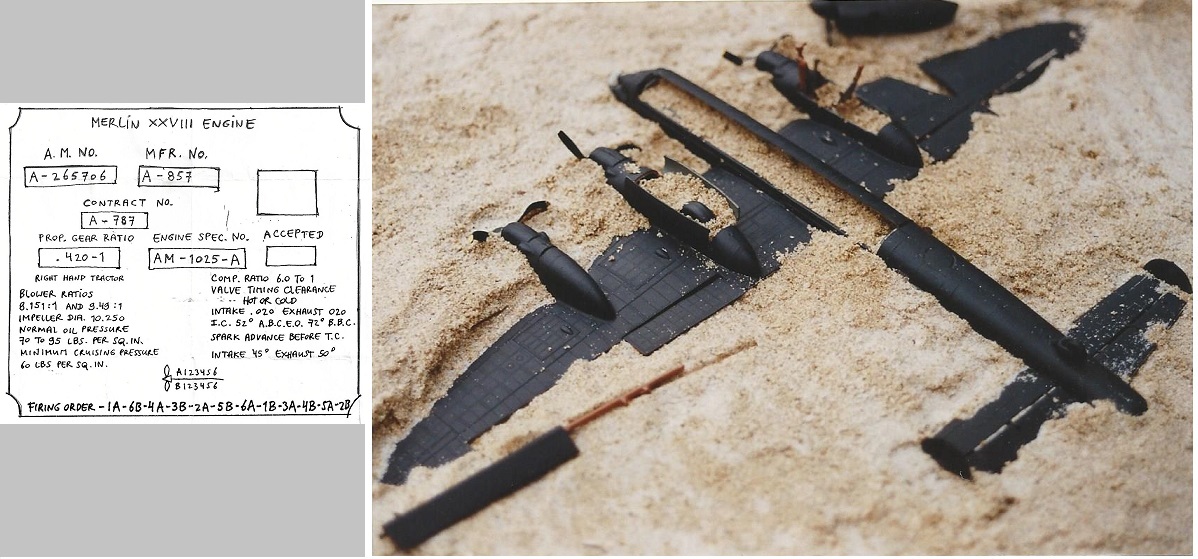
===